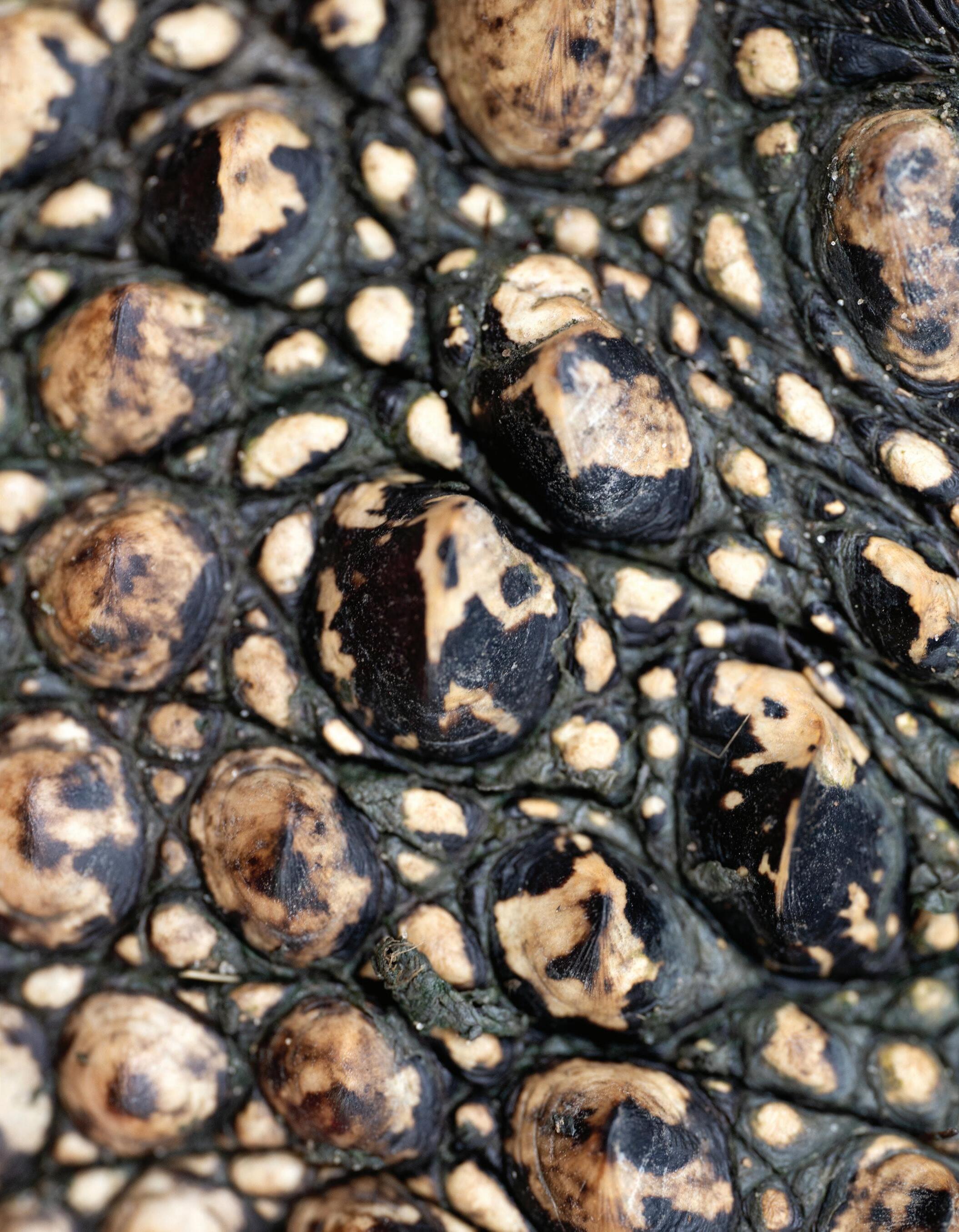
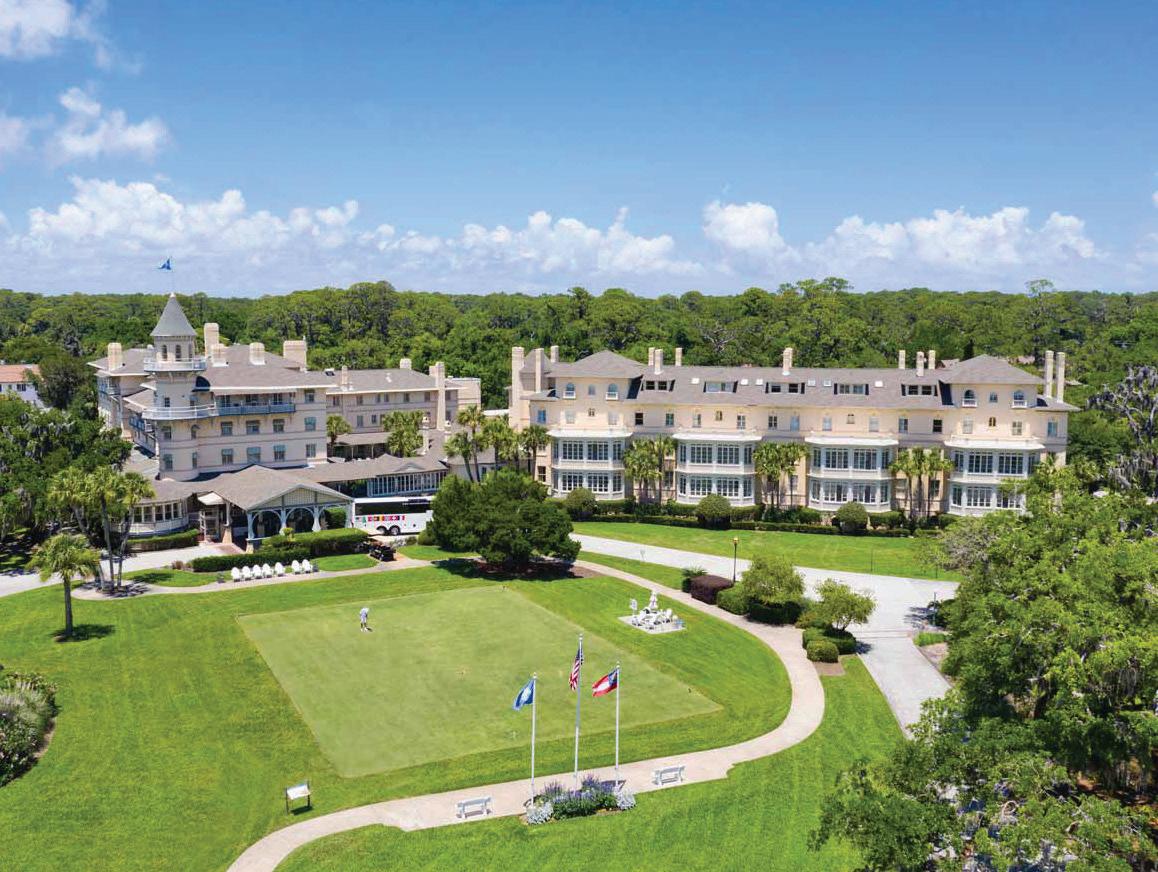



The newly renovated Jekyll Island Club Resort stands as the quintessential emblem of the Golden Isles in Georgia, presenting an enduring allure of timeless elegance. With its blend of waterfront lifestyle, captivating grounds, exquisite dining options, inviting pools, oceanfront access and an opportunity to escape the hustle and bustle, the resort promises to envelop guests in a tapestry of rich history and charm.
Richard L. Eldredge
By Lauren Finney Harden

Tyra Douyon
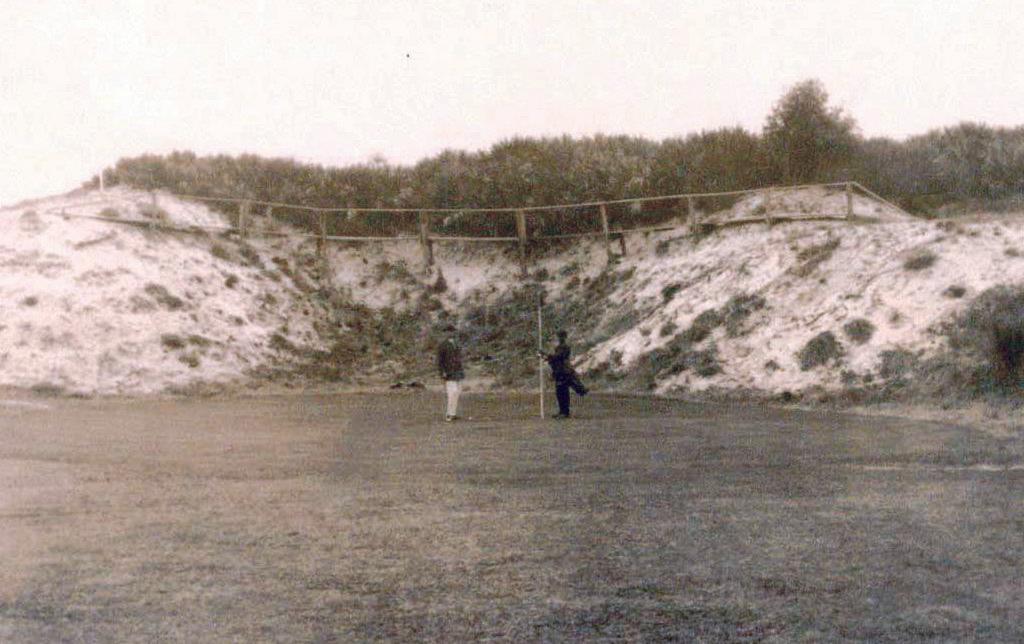


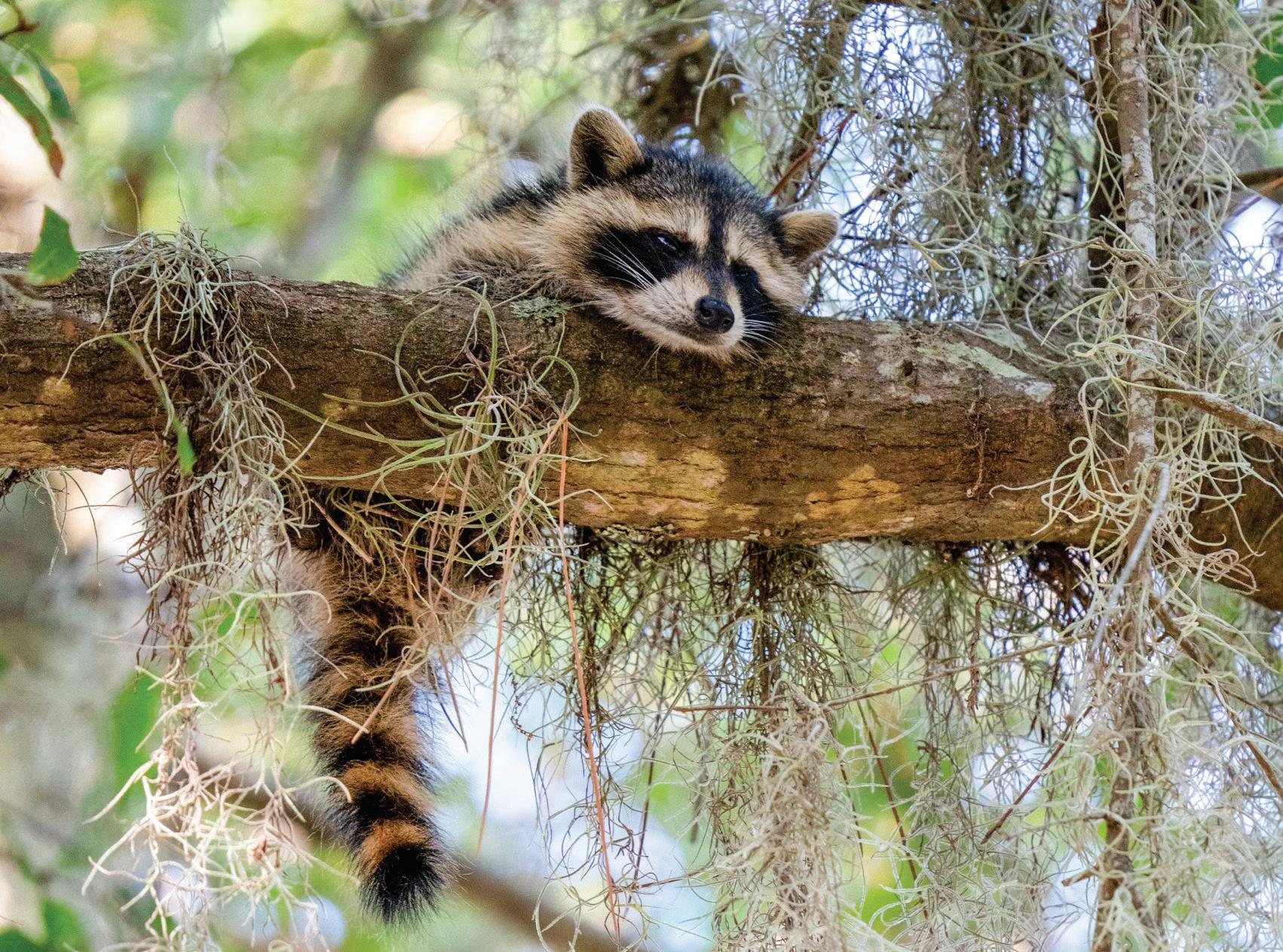
From
Nature's Nightlight
The
Clever Critters
Jekyll's
Ellen Rothstein
One
Tracing



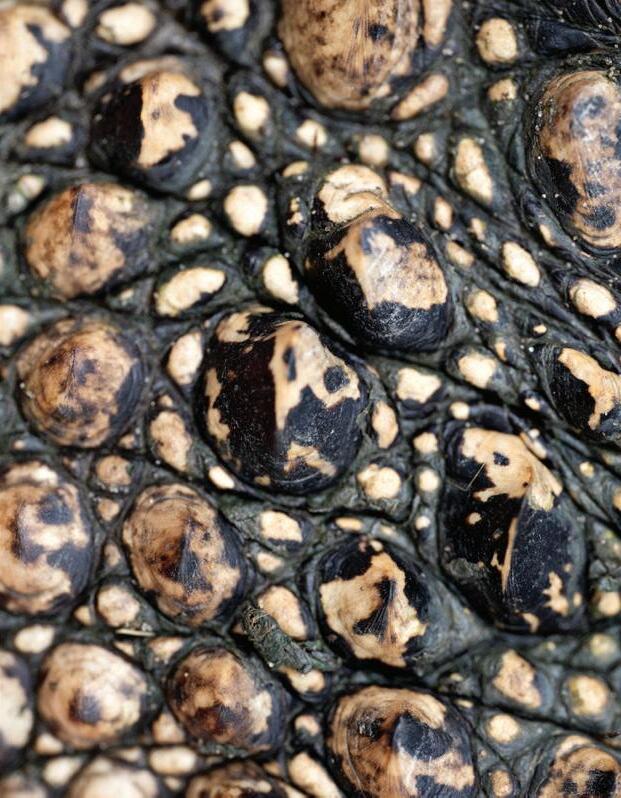
The American alligator is one of Jekyll Island’s most iconic residents. Spot one in the pond or on the go!
photograph by allison leotis
Find us on social media:

@jekyll_island

@JekyllIsland
about 31 · 81
Published twice a year, 31·81 pairs stunning photography with thoughtful articles to tell the stories of Georgia’s most unique barrier island.
Jekyll Island lies at 31 degrees north latitude and 81 degrees west longitude.
subscribe
To subscribe at no charge, sign up at jekyllisland.com/magazine.
To update your subscription information, email magazine@jekyllisland.com.
100 James Road • Jekyll Island, GA 31527 jekyllisland.com
executive director
Mark Williams
director of marketing & communications
Alexa Hawkins
marketing communications manager
Lauren Buie
creative director
Claire Davis
senior graphic designer
George Alread
Photography courtesy of Jekyll Island Authority unless otherwise noted. This magazine was published by the Jekyll Island Authority in cooperation with Atlanta Magazine Custom Media. All contents ©2025. All rights reserved.
publisher Sean McGinnis
editorial director
Kevin Benefield
editor
Lauren Finney Harden
art director
Tara McCarthy
associate publisher
Jon Brasher
production director Whitney Tomasino

GOLD WINNER North American Travel Journalists Awards honoring the best in travel journalism, photography, and destination marketing.

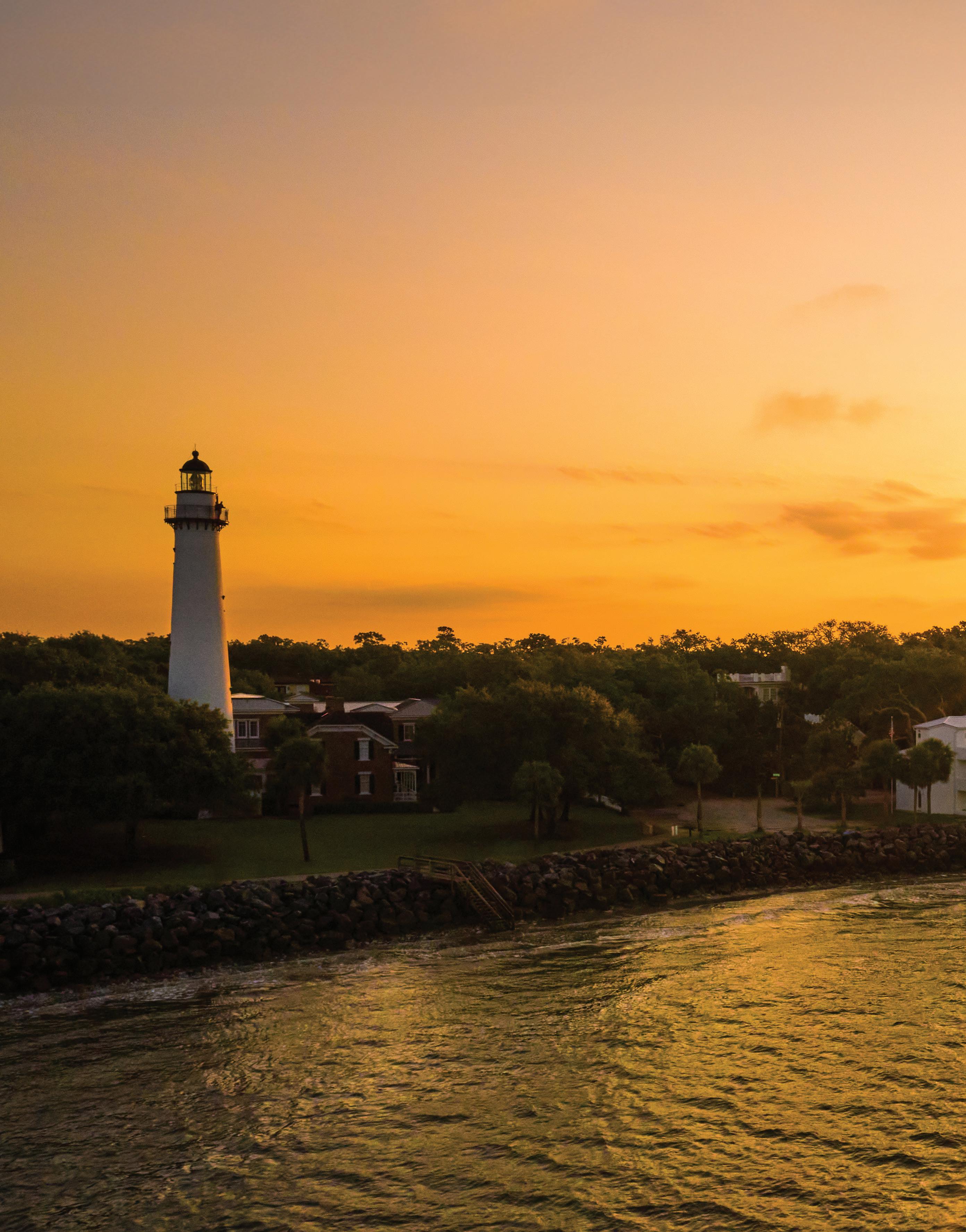



It calls out to you, the vibrant golden marshes stretching across the horizon, endless as the sunset sky.
A haven for all, timeless and eeting. Where simple pleasures lie and creature comforts thrive. Listen to your soul and the Golden Isles will reveal itself to you.
Each taste steeped in lifetimes of warmth and comfort, in the traditions of the ocean, the perfect pairing, as good as gold.
A Georgian gem long treasured, beloved across generations, the discovery of joy cherished by all.
Satisfy your soul in the Golden Isles.


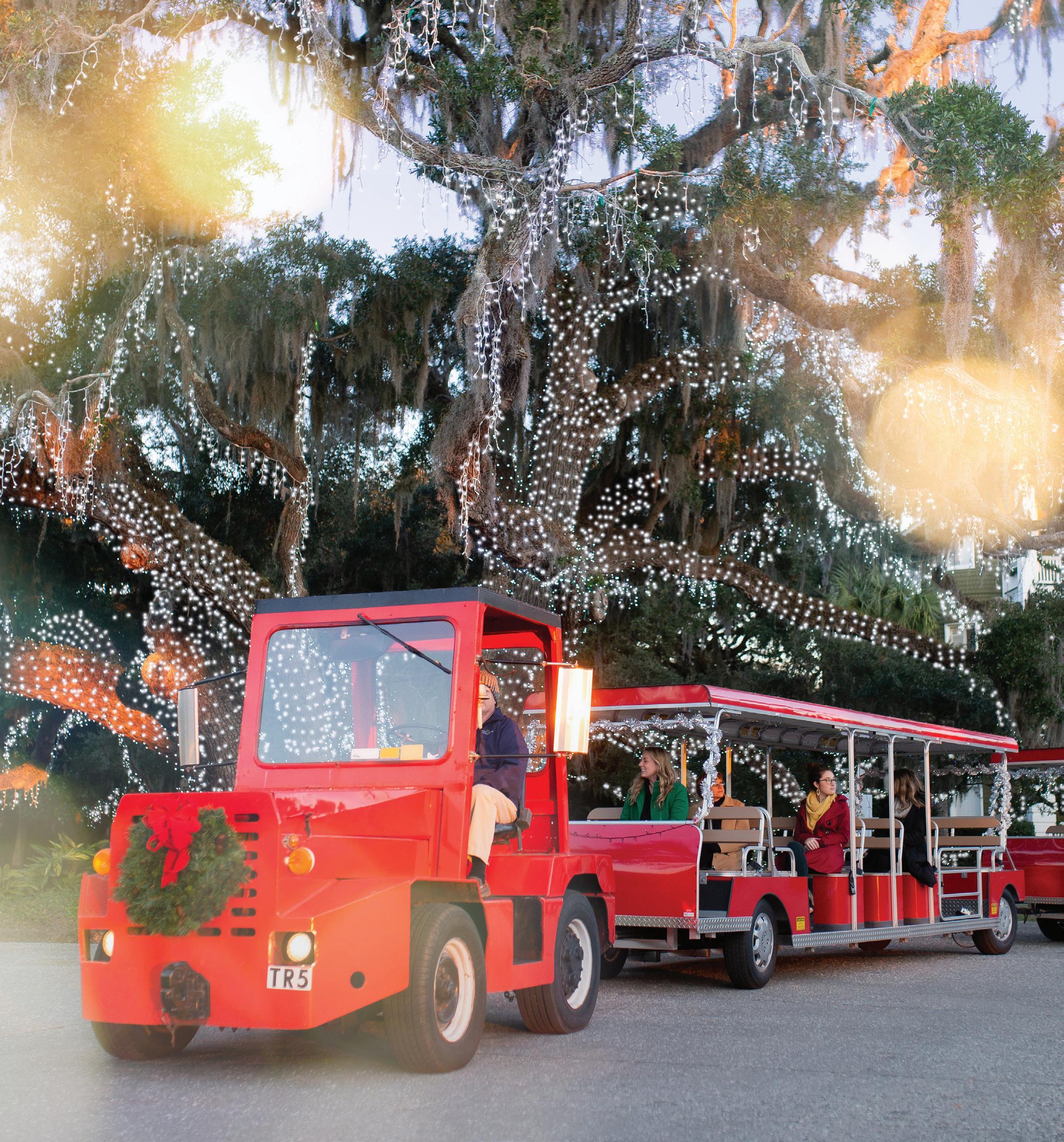

Jekyll brings me the same sense of joy it always has."
As another season changes on Jekyll Island, I’m reminded of the steady rhythm of island life. Tide by tide and season by season, Jekyll brings me the same sense of joy that it always has. Especially in the fall, which often seems to catch people by surprise. While many of our northern neighbors are settling in for cooler days, Jekyll is coming alive again. The marsh grasses turn a brilliant gold, migrating birds begin their journeys, and native wildflowers quietly bloom along our trails. It’s a season of subtle beauty, one that rewards those who look a little closer.
Already this year, we’ve celebrated incredible milestones and are looking forward to many more. One of those has been near and dear to me for quite some time: a reimagining of the District Shops on Pier Road. It’s been extraordinary to watch this beloved corner of the Historic District come alive again. Between coffee stops, shopping for your favorite Georgia Grown product, or dining under the oaks with friends, it’s another great reason to stay a while.
And of course, the restoration of the island’s historic Great Dunes Golf Course. The work we’ve done to elevate and enhance our golf experience reflects a shared commitment to honoring what’s always made the course special, while ensuring it can be enjoyed for generations to come. This project is the result of remarkable collaborations with some of the smartest minds in the golf industry, and we’re proud to show you what we’ve accomplished together.
When you look around, you will see the island’s magic comes from the people who love it—residents, locals, visitors, and everyone in between. I hope you’ll consider visiting these new experiences and much more of the island in the near future. And, as we enjoy this beautiful season, I hope it brings you time to cherish old memories and make new ones.
Mark Williams
Executive Director,
Jekyll Island Authority
Glen Willard chairman Richmond Hill, GA
Walter Rabon commissioner, dnr Monticello, GA
Joy Burch-Meeks Screven, GA
Robert “Bob” W. Krueger vicechair Hawkinsville, GA
Ruel Joyner Savannah, GA
Dr. L.C. “Buster” Evans Bolingbroke, GA
William “Bill” H. Gross secretary/treasurer Kingsland, GA
Dale Atkins Baxley, GA
Joseph B. Wilkinson St. Simons Island, GA
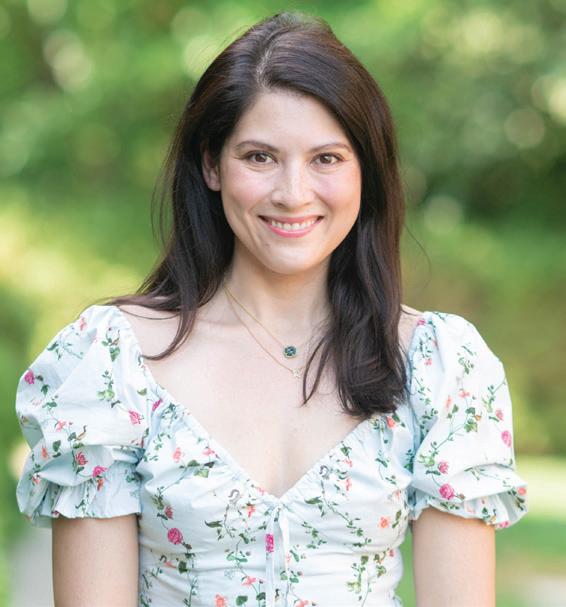
Anything can happen on Jekyll, and that’s part of the magic of the island. ” "
When I was 12, my sister and I tagged along with my mom on a PTA trip to Jekyll, my first ever to the island. I remember cruising down trails on a bike, old enough finally to explore on our own. I also remember slamming on the brakes when a large (at least to us) alligator crossed our path. We biked out of there as fast as we could, legs and hearts pumping, long dark hair flowing in the breeze as we shrieked with terror and glee. It proves anything can happen on Jekyll, and that’s part of the magic of the island.
Magic seems apropos for this fall-themed issue, where we delve into spooky season delights such as the look-butdon’t-touch jack-o-lantern mushrooms (page 14), maskwearing raccoons (page 16), ghost stories (page 58), and crypsis, a type of camouflage animals use (page 30).
Our writers perform their word magic on stories, such as Richard L. Eldredge’s account of Hollybourne, the meticulously documented Gilded Age home of the Maurice family (page 40), and Betsy Riley’s coverage of the architects behind the new Great Dunes Golf Course (page 25). Tyra Douyon sat down with Sandra Martin Mungin, the daughter of the first African American residents of Jekyll Island (page 22), to gain insight into what it was like growing up in her house.
Revel in the stories this island has to share, spooky or otherwise, and bask in the island’s history, culture, and versatility.
Lauren Finney Harden Editor
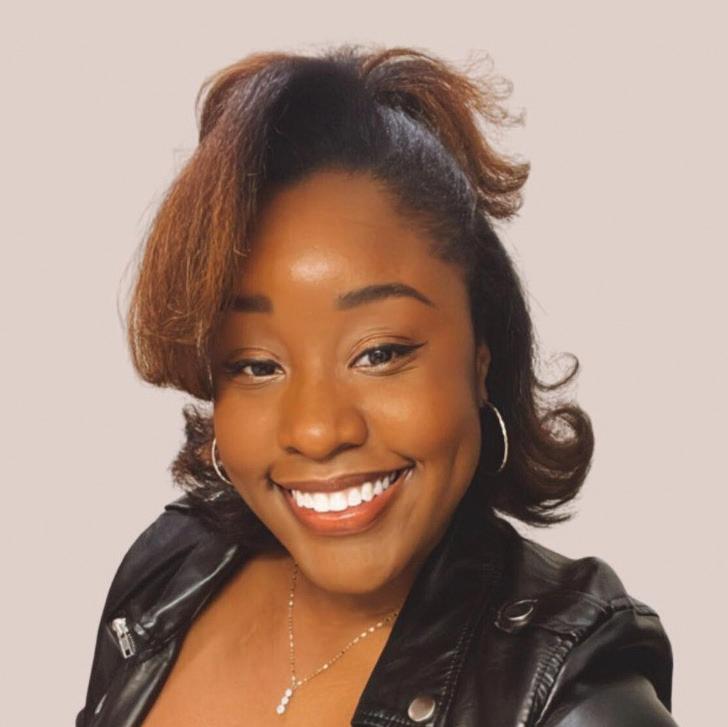
Tyra Douyon is an Atlanta-based journalist and editor. A graduate of Kennesaw State University, she earned her bachelor’s degree in English Education and master’s in Professional Writing. She is a published poet and staff editor for an independent literary arts magazine. tyradouyon.com

Josh Green is a writer and editor whose work has appeared in Urbanize Atlanta, Garden & Gun, Indianapolis Monthly, and elsewhere. His first novel, Secrets of Ash, is nominated for a Georgia Author of the Year award and won IndieReader's 2024 national contest for literary fiction. joshrgreen.com and others. She also serves as editor in chief of GaBiz and deputy departments editor of Southbound. jenniferbradleyfranklin.com

Tours depart daily from Mosaic, jekyll island museum. RESERVE your spot:

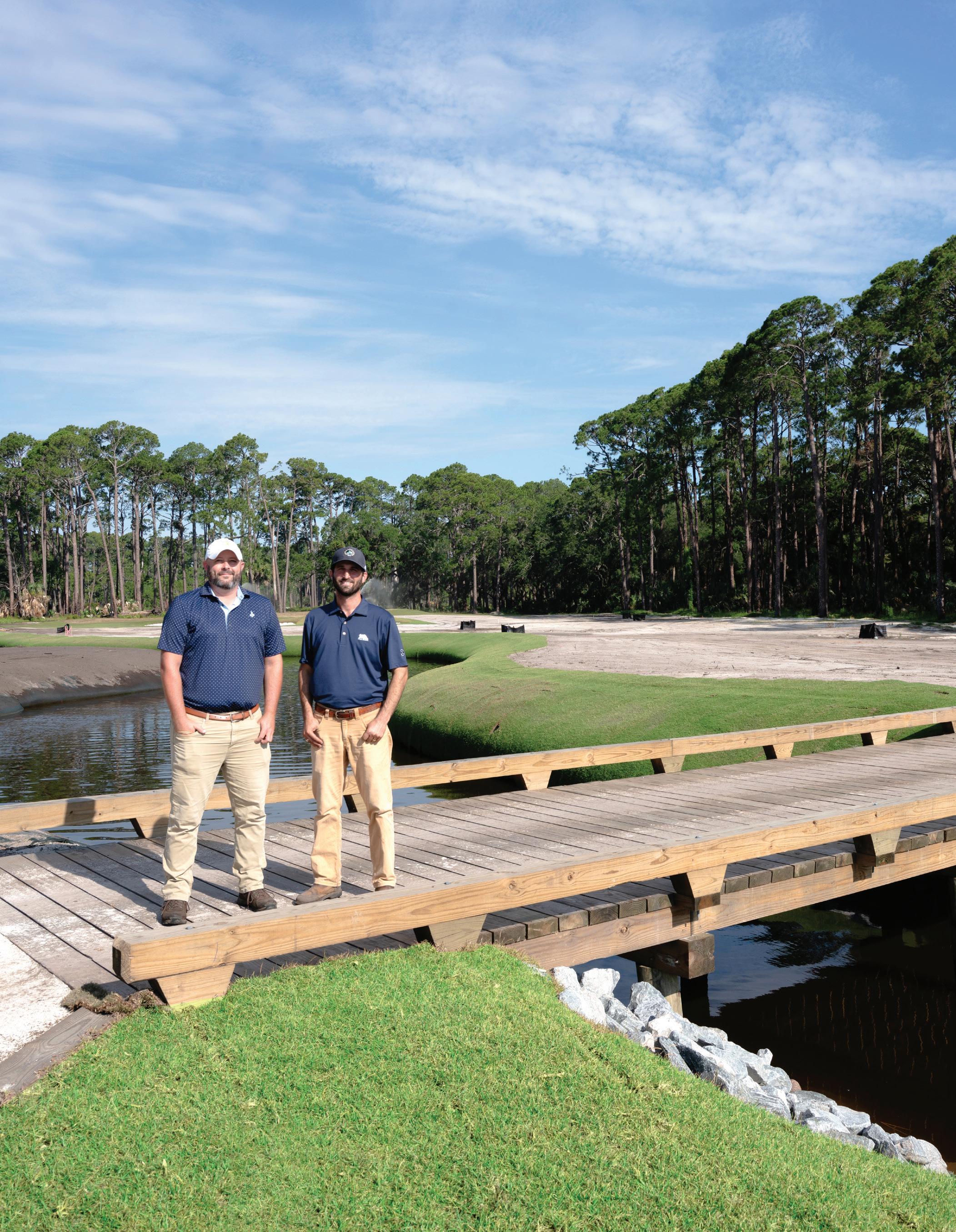

Bricks from a once-stately cottage find a new home BY NICOLE LETTS
Joseph Pulitzer was a visionary in American journalism. Beyond his success in newspaper circulation as the publisher of the New York World, Pulitzer’s enduring legacy is marked by his profound contributions to education and the arts, including an endowment to create the Columbia School of Journalism, the Pulitzer Prizes, and more. He also
left a legacy on Jekyll Island as one of 53 of the 1896 charter members of the exclusive Jekyll Island Club, among other notable bold-faced names like J.P. Morgan, William K. Vanderbilt, and William Rockefeller. Pulitzer found such enjoyment in the island that he commissioned Charles Alling Gifford to design the impressive Pulitzer Cottage as a winter retreat on the
north side of Moss Cottage in the Millionaire’s Village. Built between 1897 and 1898, and later expanded in 1899 and 1904, photos and documents reveal the cottage became an ever-expanding architectural oddity as Pulitzer desperately tried to win over his wife, Kate who notoriously despised the island’s heat and bugs.
The 26-room house rambled without a coherent design as Pulitzer continuously added rooms and improvements in his futile attempts to make Kate comfortable. Even with the changes, Kate never shared his passion for the retreat. Although his last visit was in 1909, and he
Learn more about Jekyll’s lost buildings, such as the Pulitzer- Albright Cottage and the old night watchmen cottages, on the Lost Buildings Trail. The trail begins in the Historic District at the 3181 Lifestyle Shop and ends at the District Shops at Historic Pier Road.
ultimately passed away in 1911 en route to Jekyll Island on his yacht “Liberty,” his significant connection to the island remained. The cottage later passed to coal magnate John J. Albright after Pulitzer’s death, thereafter becoming the Pulitzer-Albright Cottage.
In the 1950s, a fire deemed the cottage unsalvageable, and it was demolished. Its bricks, however, were extensively reused throughout other island projects. Notably, these salvaged bricks constructed the Great Dunes Golf Course clubhouse, which is now home to Red Bug Motors Pizza. “The bricks have a distinctive mottled look because they are from the early 20th Century. [They are] soft-fired, red clay bricks; the entire exterior of the structure is clad in them,” says Taylor Davis, the historic preservationist for the Jekyll Island Authority. In addition
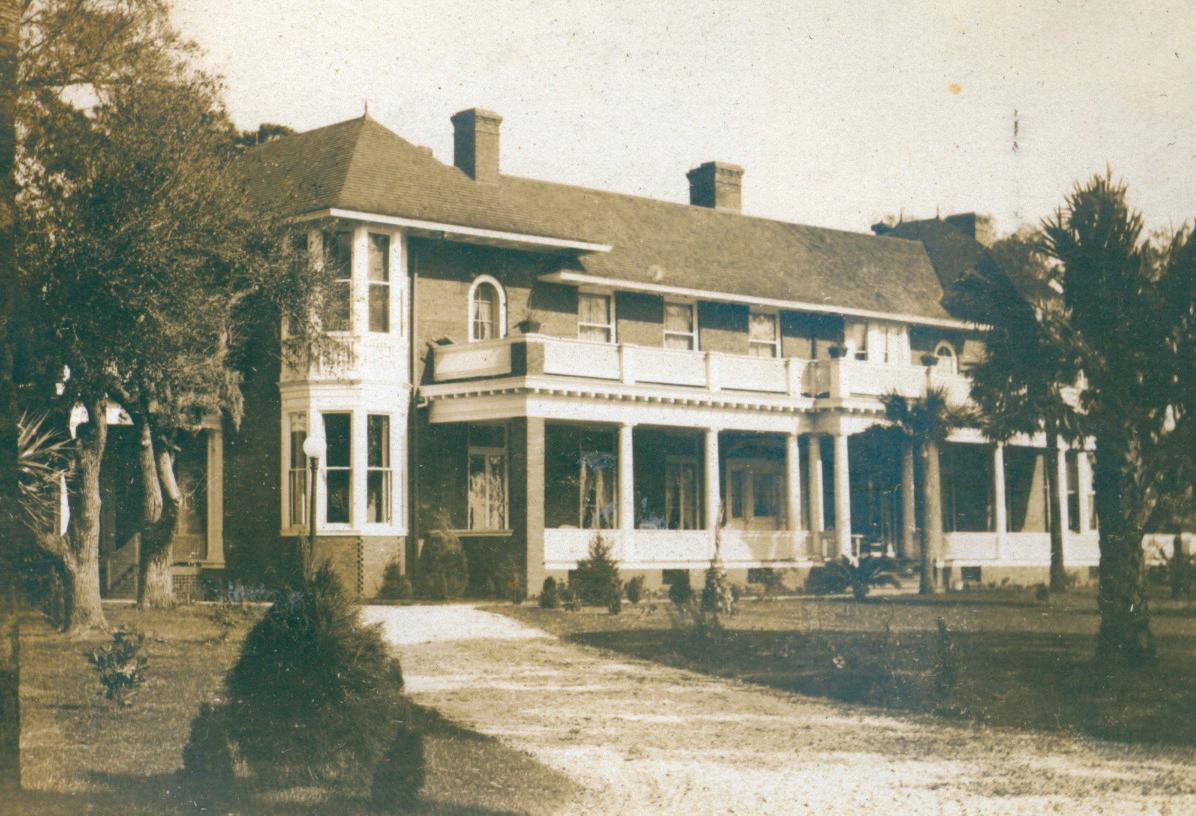
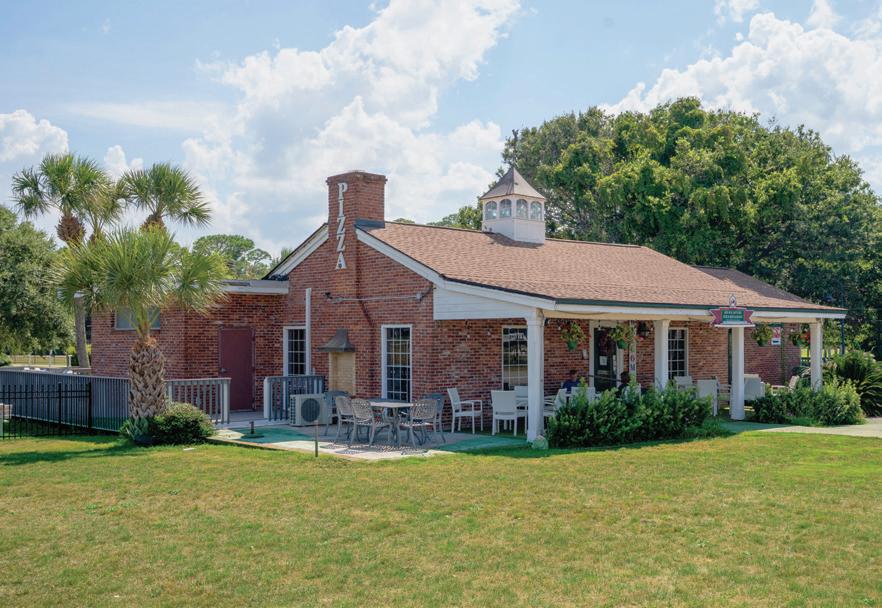
to the Great Dunes clubhouse exterior, several other buildings, such as a bike barn and some of the brick mini golf structure, are also outfitted with the bricks.
Davis explains that leaving materials as near to their original intended use and location maintains their authenticity, preserves their history, and keeps them accessible for future generations, saying, “That material was selected, constructed, and lived a life on a property, and I think it’s very important that it continues its story.” While ideally, the building would remain in its original place and form, the reuse of its materials, such as the Pulitzer bricks, allows for continuing its historical narrative and provides links to the past that people can still see and touch today.
Opposite: Great Dunes Golf Course clubhouse in the 1950s. (Jekyll Island Museum). Top right: Pulitzer-Albright cottage circa 1898 (Jekyll Island Museum). Bottom right: Red Bug Motors Pizza (Allison Leotis)

Glow-in-the-dark jack o’lantern mushrooms are appealing, but poisonous
BY TESS MALONE
Some of Jekyll Island’s fungi glows gold in late summer and fall. Aptly named the jack o’lantern mushroom, thanks to their orange coloring and the season when they emerge, large colonies reside in rotting hardwood trees and among palmettos across the island. These colonies are known for their occasional ability to glow in the dark; this bioluminescence comes from phosphorus that the mushrooms absorb and that attracts nocturnal insects to land and spread spores. Folklore has spread over the years about how they illuminate the way for travelers or even contain trapped souls. The pumpkin-colored stacks are toxic to humans and animals despite looking similar to tasty chanterelles. Look for the jack o’lantern’s distinctive gills to differentiate it from its gourmet twin. For now, we can admire their radiance and spooky glow from afar.
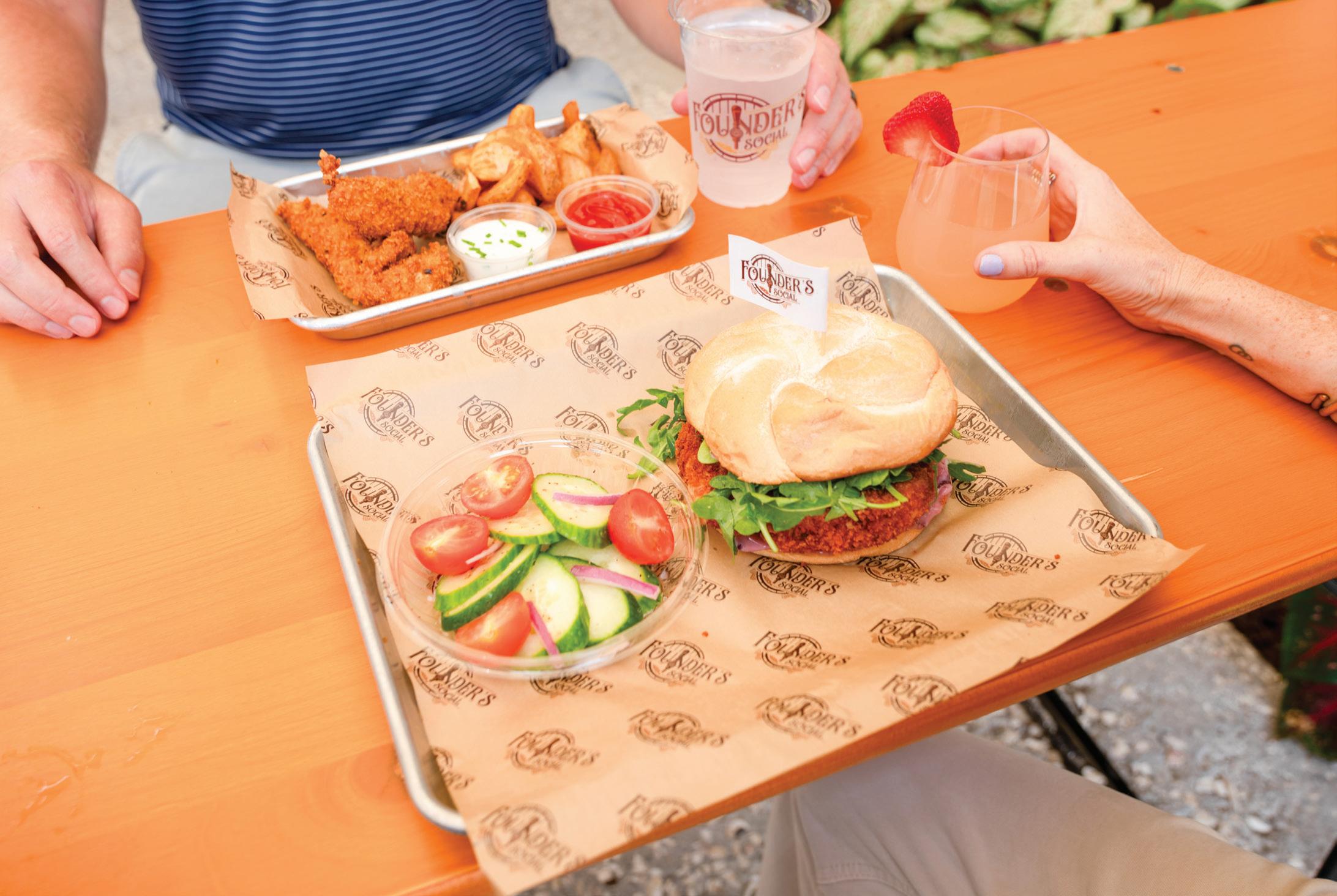
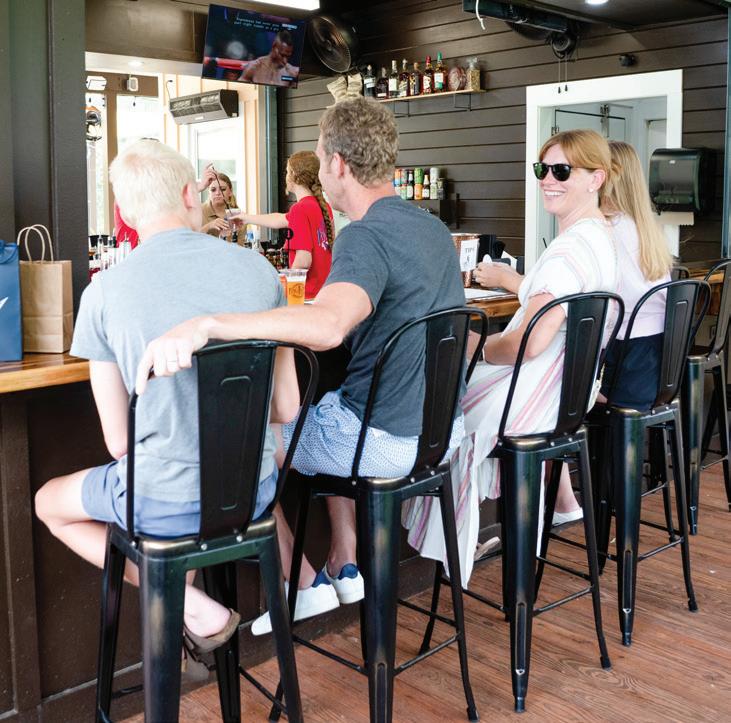

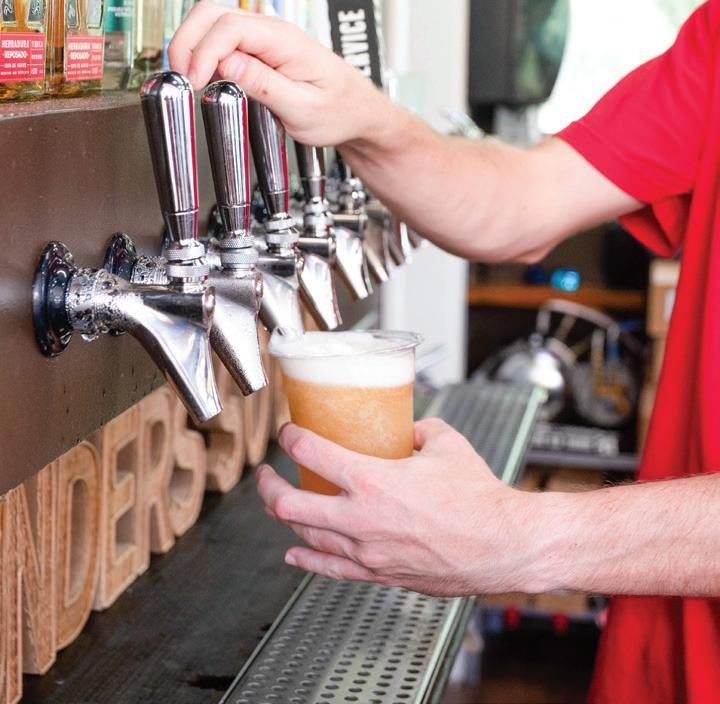
NOW OPEN IN THE DISTRICT SHOPS ON HISTORIC PIER ROAD
Raccoons are the center of Jekyll Island’s food chain
BY TESS MALONE
This mischievous mammal is intelligent and curious— sometimes in the wrong ways. It can steal your trash. It can raid your picnic. It is also vital to the ecosystem. Meet the raccoon, who has called Jekyll Island home since before the first colonizers set foot on the shore.
Raccoons impact the island in many ways. For one, they act as nature’s farmers when they dig for grubs and distribute seeds in the process. “They eat a wide variety of plants, especially seeds and soft fruits, so they spread a lot of good

seed-producing plants all over our landscape,” says Yank Moore, the director of conservation for the Jekyll Island Authority. He even recalls the team finding a prickly pear growing in an oak tree, thanks to a raccoon’s waste. Raccoons are dogood exterminators, making meals of rodents, which helps prevent parasites from spreading; they are also opportunists, ever scavenging.
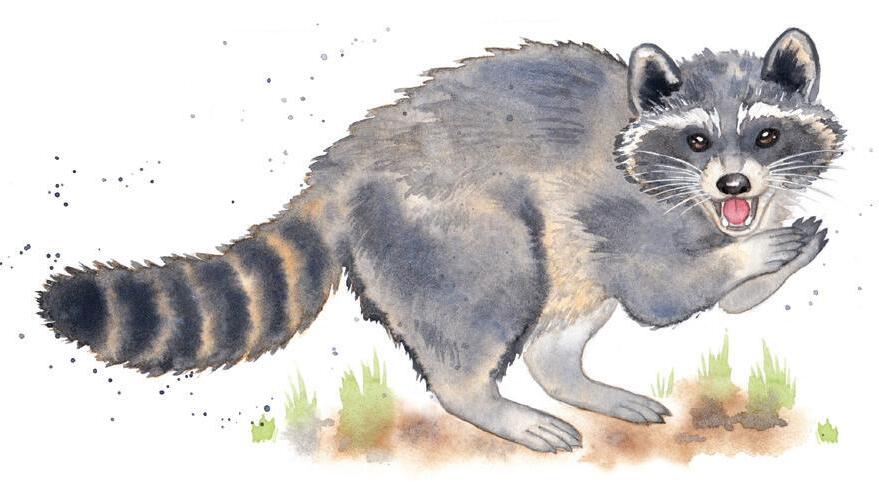
The Algonquin word for raccoon meant he who rubs, scrubs, and scratches with his hands."
Raccoons might look like they’re washing their paws before digging in, but they are actually improving their tactile sensitivity, or ability to determine what they’re touching. Still, the misunderstanding gave them their name; the Algonquin word for raccoon, arukhun, meant “he who rubs, scrubs, and scratches with his hands.” While they are known for being scavengers, they have predators, too, regularly
making up the diet of raptors, alligators, and snakes on the island.
“Raccoons are very smart. They use tools to open mussels and clams, and they have a complex series of vocalizations, facial expressions, and body language that they use to communicate,” notes Jekyll Island Authority wildlife biologist Joseph Colbert.
Their mischievousness is well-documented. The Jekyll Island Authority has a wildlife incident reporting system with on-call staff, and raccoon reports have made up more than 25 percent of the calls since 2019. The biggest cause of rogue raccoons is human error, such as leaving open trash cans or intentionally feeding them, encouraging them to come back for more. To combat this, businesses on the island are required to have compactors that prevent wildlife from opening them, but residents need to make their garbage pest-proof, too, so that raccoons can prioritize their other duties.

Eighty Ocean Kitchen + Bar, located inside the Jekyll Ocean Club Resort, offers a relaxed oceanside dining experience with innovative Georgia fare. Enjoy wood-fired flatbreads, fresh seafood, and signature share plates, paired with craft cocktails, regional brews, and boutique wines. Savor coastal cuisine and sip craft drinks, with indoor seating or breezy alfresco dining.
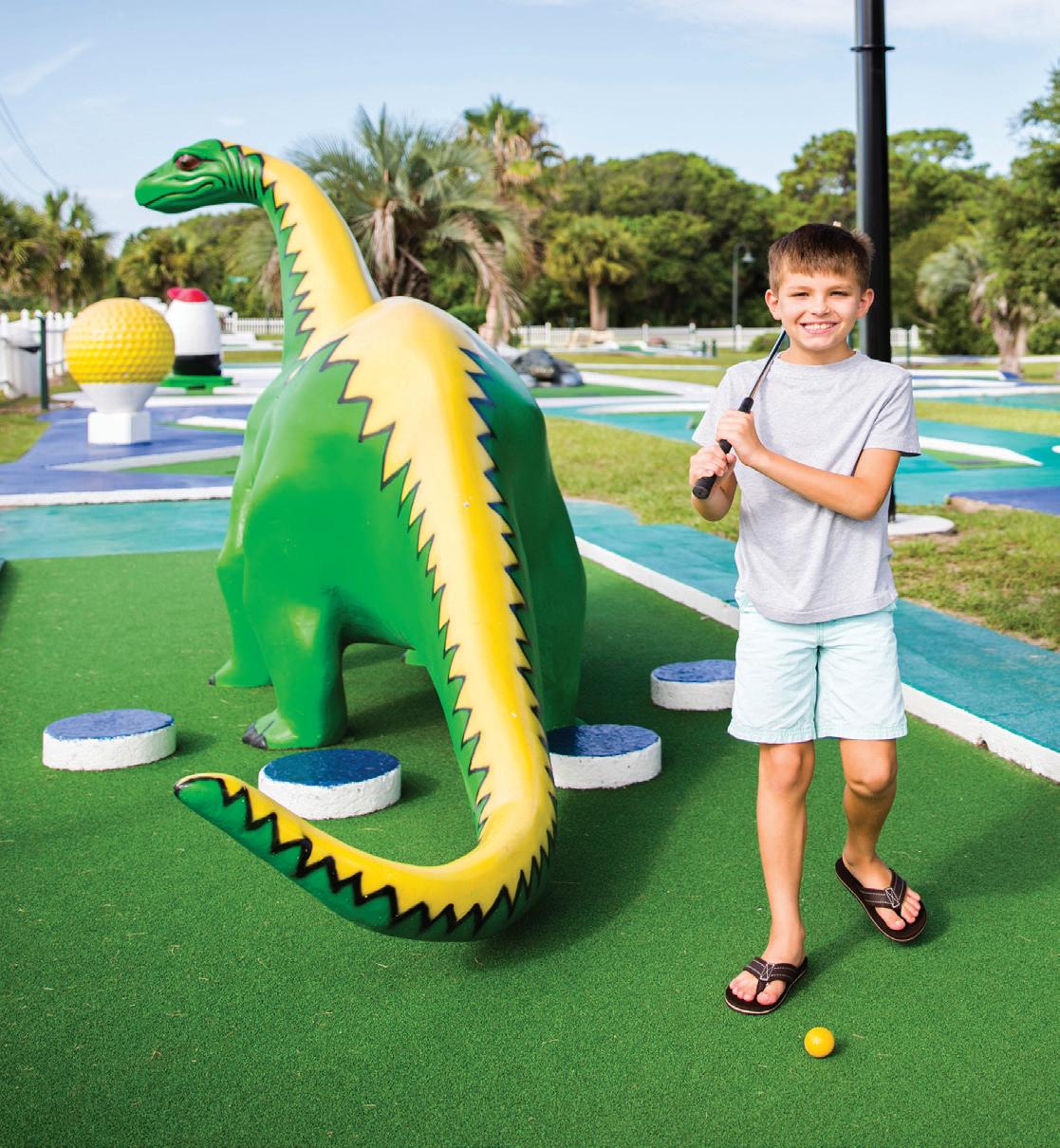

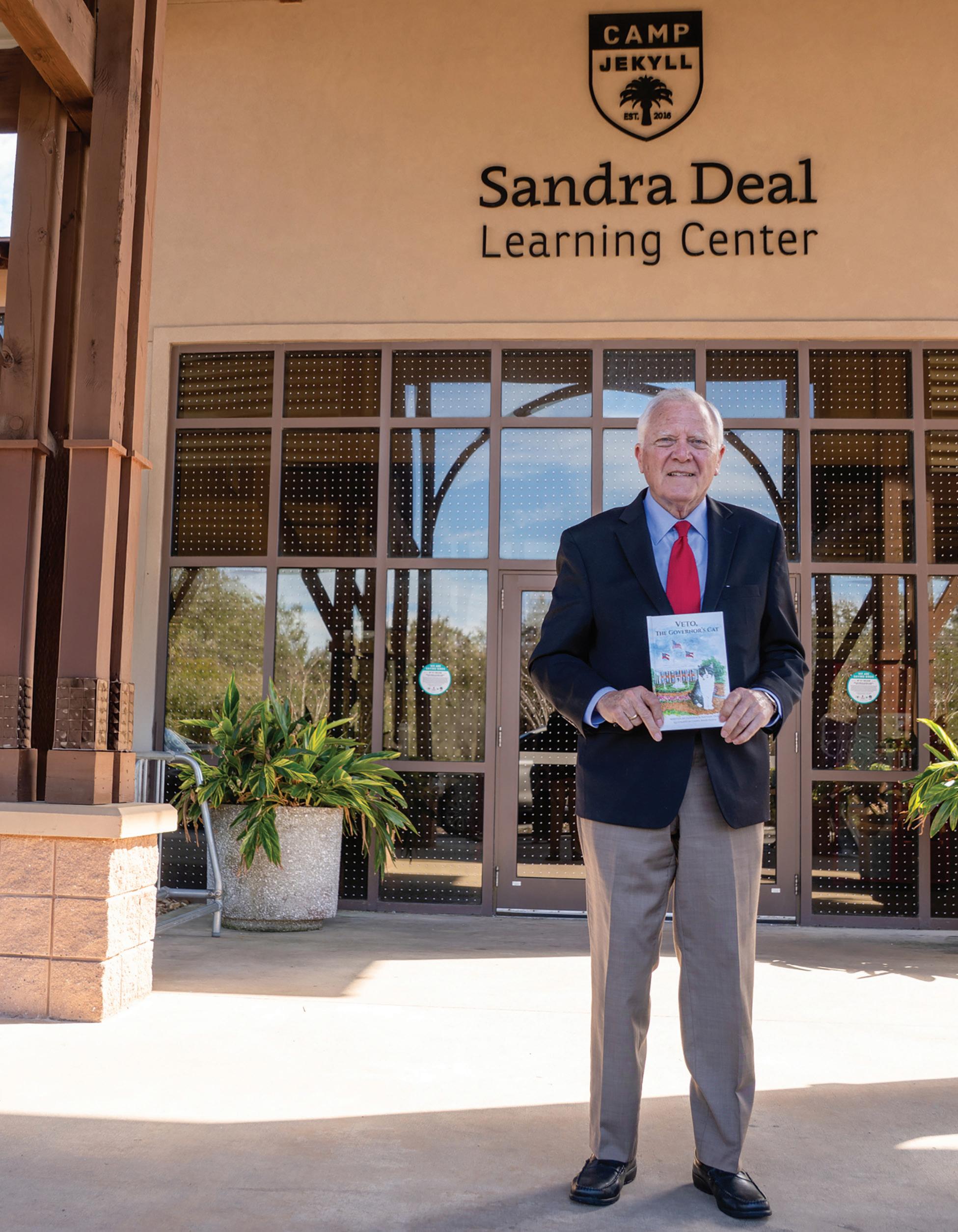
Former Governor Nathan Deal has a long history with Jekyll Island
BY JENNIFER BRADLEY FRANKLIN

Much like the gnarled tree roots on Jekyll Island’s iconic Driftwood Beach, former Georgia Governor Nathan Deal’s history is intertwined with the state’s coastal haven. It all started when he was a child growing up in Sandersville, a small town in Middle Georgia, about three hours away. Local businessman J. H. Boatright planned to build motels on the barrier island, so he sold stock to friends and neighbors. Deal’s mother, an elementary school teacher, bought shares and, as a result, earned free nights each year at the two resulting properties, the Buccaneer Beach Resort and the Wanderer Resort Motel (now the Holiday Inn). “Jekyll was just beginning to be developed,” Deal recalls. “It was a beautiful beach, and I had a good time.”
When Deal became Georgia’s 82nd governor in 2011, his work took him around the state. Soon enough, he was headed back to Jekyll, this time in a professional capacity, with his wife, Sandra, in tow. The former school teacher focused her First Lady efforts on children, education, and literacy, so when someone suggested an opportunity to see the local 4-H Center, she jumped at the chance. What they discovered surprised them. “It was in terrible shape. Sandra was appalled,” Deal recalls. She started an improvement campaign, eventually culminating in an almost complete rebuild. In 2016, when the new "Club Jekyll" reopened, one building was rechristened the Sandra Deal Learning Center. The camp serves approximately 12,000 students each year.

In 2017, Category 5 Hurricane Irma hit Jekyll hard, taking out thousands of trees, destroying beach crossovers, decimating protective dunes, and causing water main breaks. As the state’s chief executive, Deal sprang into action, granting $4 million from the Governor’s Emergency Fund to address critical restoration needs, endearing him further to the island.
Deal suffered a personal tragedy when, in 2022, his beloved wife lost her battle with breast cancer that had metastasized into brain cancer. The former Georgia governor recalled his promise years earlier that he would pen a children’s book at her request. The result is Veto, the Governor’s Cat, released in 2024. It’s based on his real-life pet who once lived at the Governor’s mansion in Atlanta. Since its publication, it’s been translated into Spanish and Braille to reach an even wider audience.

His connection with the island— and his late wife—has now come full circle. This year, he returned to the building that bears Sandra’s name and shared insights from his book with a group of eager children. “I told them about some of the characters,” Deal says. “I put the animals’ and birds’ voices to it because children listen when you do that.” The illustrated chapter book, through its collection of adorable creatures, teaches important life lessons about patience, kindness, courage, and discovery, all of which are traits Deal himself has shown through his multi-decade relationship with Jekyll. Get a copy of the former governor’s book at vetothecat.com
Remembering growing up in Jekyll Island’s first Black-owned home
BY TYRA DOUYON
Sandra Mungin still remembers the salty breeze drifting through the open windows of 13 St. Andrews Drive, the first Black-owned house built on Jekyll Island’s South End. Her father constructed it in 1963 after recovering from tuberculosis.
“He said, ‘Suppose I had passed away—y’all wouldn’t have anywhere to stay,’” Mungin recalls. “So that’s when he built this home.”
As the daughter of Genoa and Mamie Martin—the first African American residents of Jekyll Island—Mungin is one of the last living preservers of the Golden Isles’ Black history. Now at 81 years old, she reflects on an upbringing rooted in legacy, love, and community pride.
Back then, the Martins were the only Black family on the block. “It

was private, all right,” Mungin says. “We could just walk out the front door and go on down to the ocean.”
The South End was still largely undeveloped at the time. Genoa, then a civic leader and radio host in Brunswick, helped encourage Black families to build homes on Jekyll. Few did. The idea of leasing land for 99 years without owning it felt too uncertain for many. But the Martins stayed and eventually, other families followed.
She still recalls the house being built, stopping by often to check on the progress as her father and his friends worked on it. “It was a big thing,” she says. “Living on the beach like that.” People were always coming over to barbecue, boil crabs, and have a good time. “You don’t have any trouble with
friends if you got a beach house,” she laughs.
Today, Mungin returns to Jekyll Island often with her grandson to teach him about his great-grandparents, their family’s history, and ties to the Nigerian Igbo tribe and the Gullah Geechee culture. “I want him to know that they loved people. That it wasn’t all about them. It was about what they could do for other people.”
Though the house has long since been sold, the Martin family's legacy lives on in Mungin’s stories. “It wasn’t a fancy house. It was small, but it was full of love,” she says. “They wanted things to be better. Not just for us, but for the whole community.”
The Martin home today.

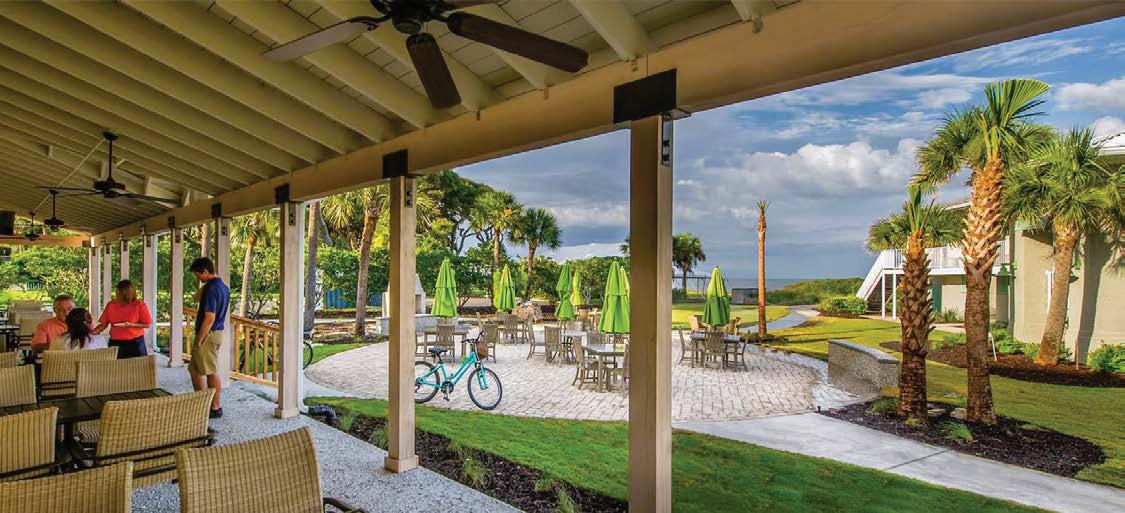
Experience coastal charm at the Beach House Restaurant & Taproom. Sit on the wrap around porch and sip on a craft brew. Savor fresh seafood and gaze out across the Atlantic. Indulge in the perfect blend of relaxation and flavor! We can’t wait for you to dive into our new seafood forward menu!

To learn more scan our QR codes!
Our menu, a variety of delectable meals and drinks.





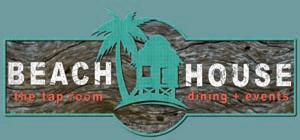


Host your special events and meetings with us.

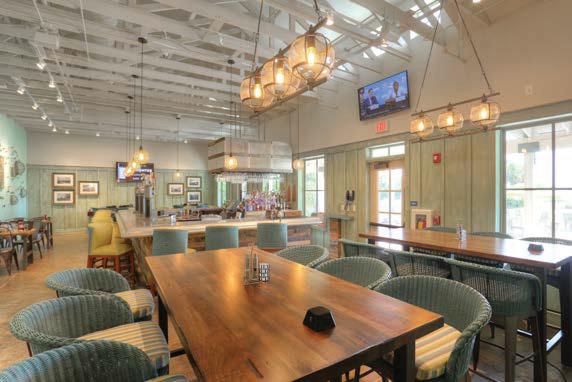

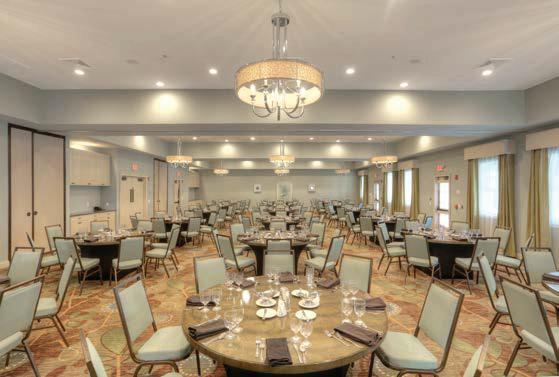


Golf architects Jeffrey Stein and Brian Ross have an old-school approach for a new game BY BETSY RILEY
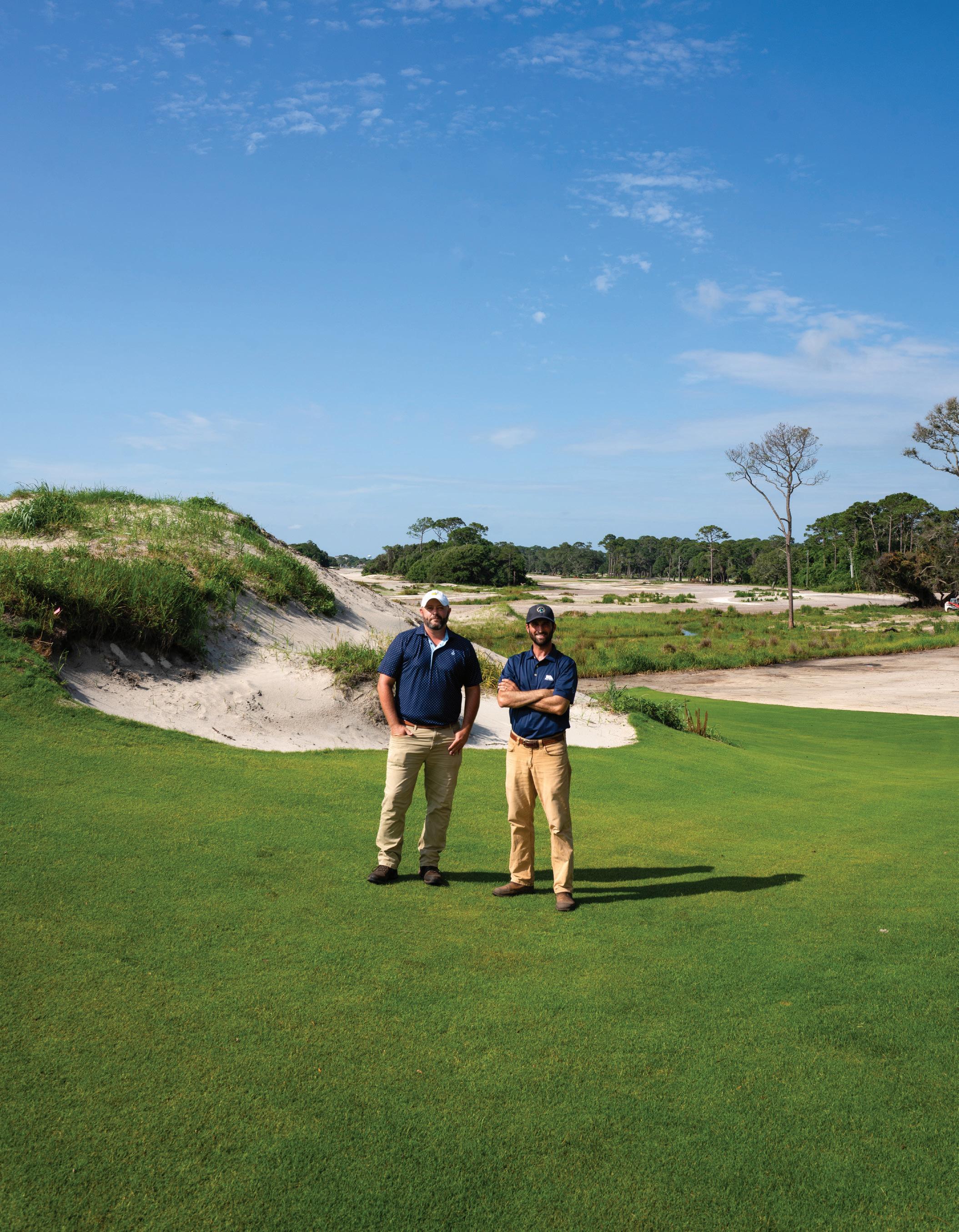
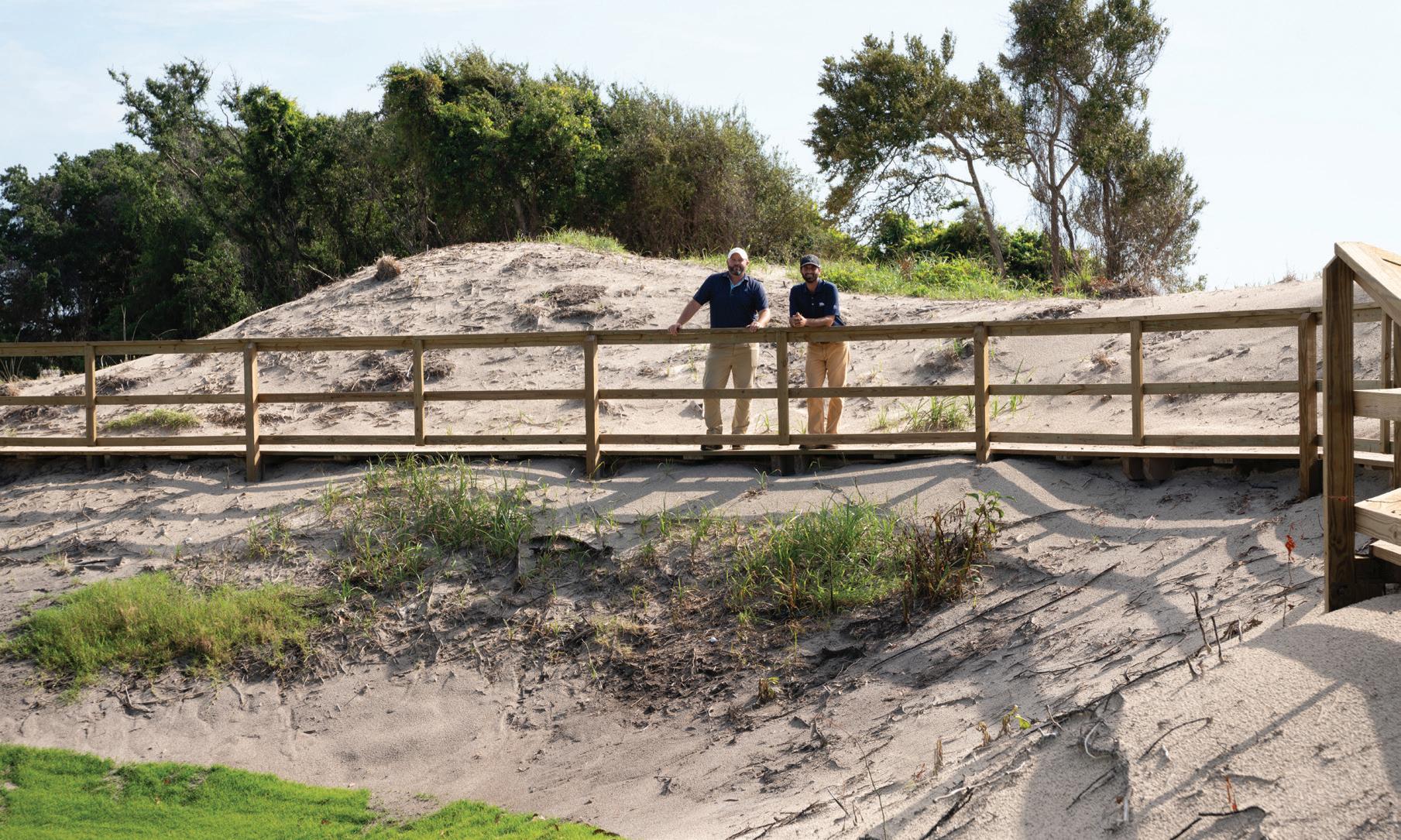
Golf architects Jeffrey Stein and Brian Ross were collaborating on a project in Pennsylvania when they won their bid to reinvent and expand Jekyll Island’s Great Dunes Golf Course, originally conceived in the 1920s by champion golfer and legendary designer Walter J. Travis. The two knew from the start that this course, which opens Fall 2025, presented a unique opportunity.
“For a municipal golf course to have ocean views, dunes, giant live oaks, pine forest, and coastal estuary is really special,” says Ross. Most courses with such dramatic scenery, including many of Travis’s own, are private.
“When Great Dunes opened, it was not like any other course in the U.S.,” says Stein. “It was a true links golf course in the American South. That is rare.”
Both Stein and Ross are drawn to historic courses.
Given Jekyll’s longtime affluent benefactors, it’s not surprising that the island enjoys a lengthy association with the game. Its first course, designed by Willie Dunn, opened in 1898. Legendary designer Donald Ross created a second course in 1910. To map out Great Dunes, Stein and Ross (no relation) tapped local archives for vintage photographs, aerial shots, and even postcards document-
ing the original layout. For example, historic images inspired them to make the new #13 green a duplicate of the original one on #14, a hole long ago washed away by the ocean.
Unfortunately, the island’s remarkable topography was also the downfall of those early courses. Drainage was so challenging that, legend has it, Club members consulted an engineer from the Panama Canal. The entire back nine of Travis’s original course was eventually lost to the tides. As a result, its new 18-hole incarnation incorporates land from 9 holes of the former 1964 Oleander Course, which donated its remaining 100 acres to wildlife habitat for conservation purposes.
Stein and Ross believe the new Great Dunes course proves golf can be beneficial for the environment. Asphalt cart paths have been replaced with crushed aggregate that blends with the sand. The entire course has paspalum grass, irrigated with brackish water to ease the burden on the island’s freshwater aquifer. Runoff doesn’t just drain, it is pumped out with the tides twice daily. “It’s not enough just to get water underground,” says Ross. “You have to actively push the water out.”
“We worked closely with the Jekyll Island Authority’s conservation department to promote native vegetation,” adds Stein. “We stripped away all the Bermuda grass that had been allowed to roam free for the last 80 years.” The new routing does not bring golfers back to the clubhouse at the turn, keeping them immersed in natural beauty. Layouts have also been designed to protect and even enhance wildlife habitats, carving out hammocks for nesting birds and deeper, cooler ponds for fish.
Stein stresses the new vibe is “very much a throwback course,” which blurs the lines between greens, fairway, and out-of-bounds territory. Golfers must navigate deep bunkers and undulating, “diabolical” greens, though these are larger to help reduce wear and tear from foot traffic and maintenance.
The new course presents plenty of challenging shots over mounds and swales—try aiming between 50-foot
dunes on the approach to #4. But the designers insist the course welcomes all skill levels. Careful attention has been given to tee placement to honor this, with play ranging from 6,900 to 4,600 yards. After all, the course’s Golden Age originator titled his first book Practical Golf.
Essentially, Stein and Ross are preservationists—not just of historic golf holes, but of the land itself. “I believe the true art in the reimagination of these golden age tracks is the exercise of restraint,” says Stein, quoting Perry Maxwell, another prominent designer of the era: “Nature must precede the architect, in laying out of links … The site of a golf course should be there, not brought there … Leave the earth where you find it, and the tee where it lies.”
Opposite: Jeffrey Stein and Brian Ross observe the course's progress from the newly restored historic bridge.
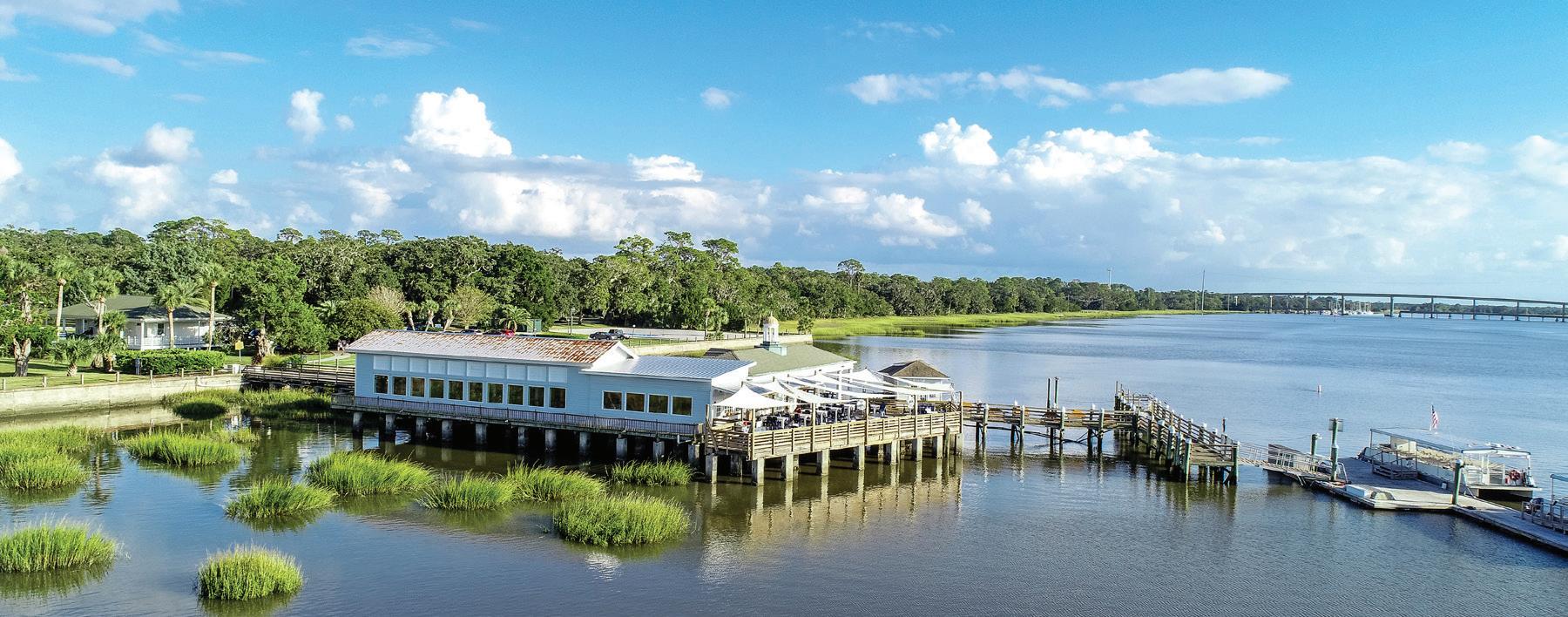
The Wharf, set on Jekyll Island’s riverfront, is the place to kick back with friends and soak up the island vibe. Feast on Southern favorites, fresh local seafood, and chef-crafted specials, with your choice of indoor or open-air deck seating. On weekends, you’ll find live music to go with the sunset and your favorite cocktail, local brew, or wine.

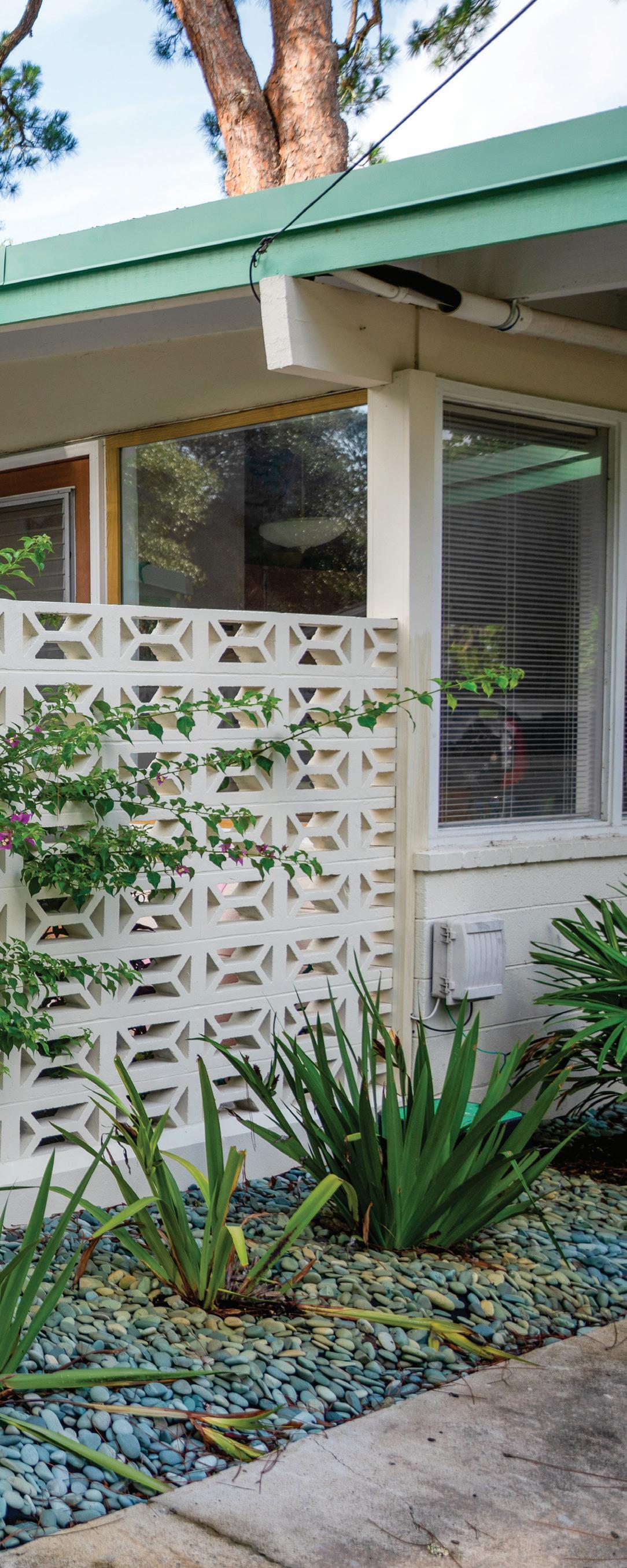
“The house is part of the reason why we’re here. We’re here because it’s Jekyll. The
beaches, the wildlife, the bike trail,
and the fact that it doesn’t have a traffic light… the people are incredibly nice, warm, and welcoming. I thank God every day for this beautiful
place.
My husband and I never get over the miracle of that. It feels like such a blessing.”
— ELLEN ROTHSTEIN
As told to NICOLE LETTS Photograph by ALLISON LEOTIS
when self-proclaimed history buff and architecture aficionado ellen rothstein first saw the iconic glass-front midcentury modern house on riverview drive in 2011, she turned to her husband christopher cook and said, “if that house ever becomes available, that’s the house that i’d love to live in, retire in, and spend the rest of my life in.” in 2019, that promise became the couple’s reality; they acquired the cormac mcgarvey-designed structure from the previous owner, local icon jean poleszak. all three shared a common vision to preserve the house as it was and respect its architectural integrity. the living room features a 60-foot glass window facade with nearly 360-degree views of the surrounding marsh. the kitchen is the crown jewel, done in bubblegum pink, reflecting a bygone era. history comes alive on jekyll.

A fascinating variety of Jekyll species rely on crypsis—or evolutionary camouflage—to thrive
By JOSH GREEN

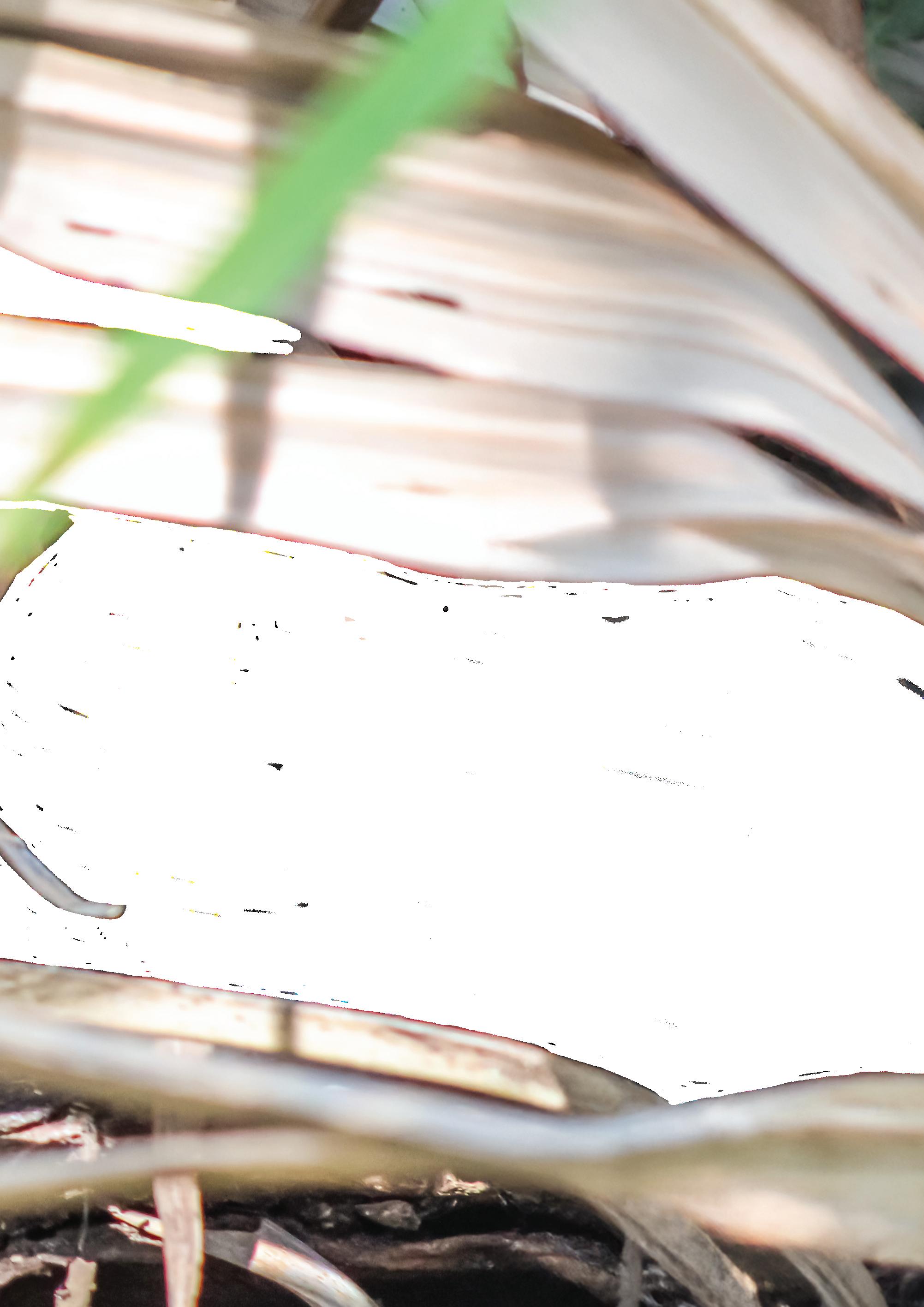



Rest assured, the rattlesnake tucked just off the forested walking path, rendered virtually invisible by dapples of afternoon light and shadows, wants nothing to do with you. It yearns to be still and silent, to ambush the next rodent.
You’re not a target for the rattlesnake and certainly not a meal—you’re a terrifying threat, the real apex organism. Its best defense against you is to be as invisible as a thick, five-foot-long Eastern diamondback rattlesnake can be. And on Jekyll Island, that defense almost always works.
Rarely seen and unbeknownst

to most of Jekyll’s roughly 3 million annual visitors, a fascinating variety of island species have mastered crypsis. That’s a commonly used biology term referring to an organism’s ability to blend into its surroundings as camouflage from predators, or for ambushing unsuspecting prey. It’s the art of being there without being seen. How crypsis is achieved varies widely from the smallest, seemingly most susceptible island creatures (moths, for instance) to the largest and most naturally fearsome (yes, alligators). Even island plants such as mistletoe—it virtually disappears in the tree canopy until leaves start dropping in autumn—participate in the evolutionary hide-and-seek.
“With camouflage, a lot of people think of snipers and the military. These species are essentially doing the same thing, including ambush predators that want a meal,” says Joseph Colbert, Jekyll Island Authority wildlife biologist. “There’s a lot of stuff that we as biologists see regularly that some people are only fortunate to see on rare occasions.”
Wildlife camouflage can entail more than color patterns, such as changes in animal behavior or tactics to mask scent. Collectively, it’s a primary reason why sticking to permitted beach areas and designated nature trails while exploring the wilds of Jekyll is beneficial for both visitors and the animal kingdom.
Almost invisible in forest foliage, Eastern diamondback rattlesnakes are among the highest priorities in Jekyll conservation. They’re genetically and characteristically distinct from their mainland cousins, meaning they’re wholly dependent on the island’s internal snake population. (Fear not: No rattlesnake bite on a human has ever been recorded on Jekyll, and only a handful of sightings are logged per year.) These snakes aren’t fans of swimming, so they typically remain on the island for life, perpetually in hiding.
Michael Brennan, a PhD Student at the University of Georgia’s Warnell School of Forestry and Natural Resources, has been monitoring and tracking Jekyll’s rattlesnake population with tiny Bluetooth and radio transmitters for several years. To date, 63 adult rattlesnakes have been
found in three distinct home ranges: upland marshes, dune systems, and maritime forests. A “barometer” or “umbrella” species at the top of the food chain, like rattlesnakes, can use crypsis to stay undetected and thrive; when the umbrella species is thriving, it benefits the rest of the animals in the habitat by keeping things in check. Rattlesnakes’ dark-light diamond patterns are extremely effective camouflage, but only in the right places, with the proper cover. Evidence also suggests they’ve evolved to become smaller. Eight-foot individual rattlesnakes used to be common, but due to various threats over generations, the species evolved into a reduced size. Today, the largest individuals rarely reach six feet in the wild. There are instances, however, when crypsis backfires for rattlesnakes.
“With behavioral crypsis, a rattlesnake’s natural tendency is to freeze, even when they’re not in ideal habitat, like when they’re crossing a road,” Brennan says.
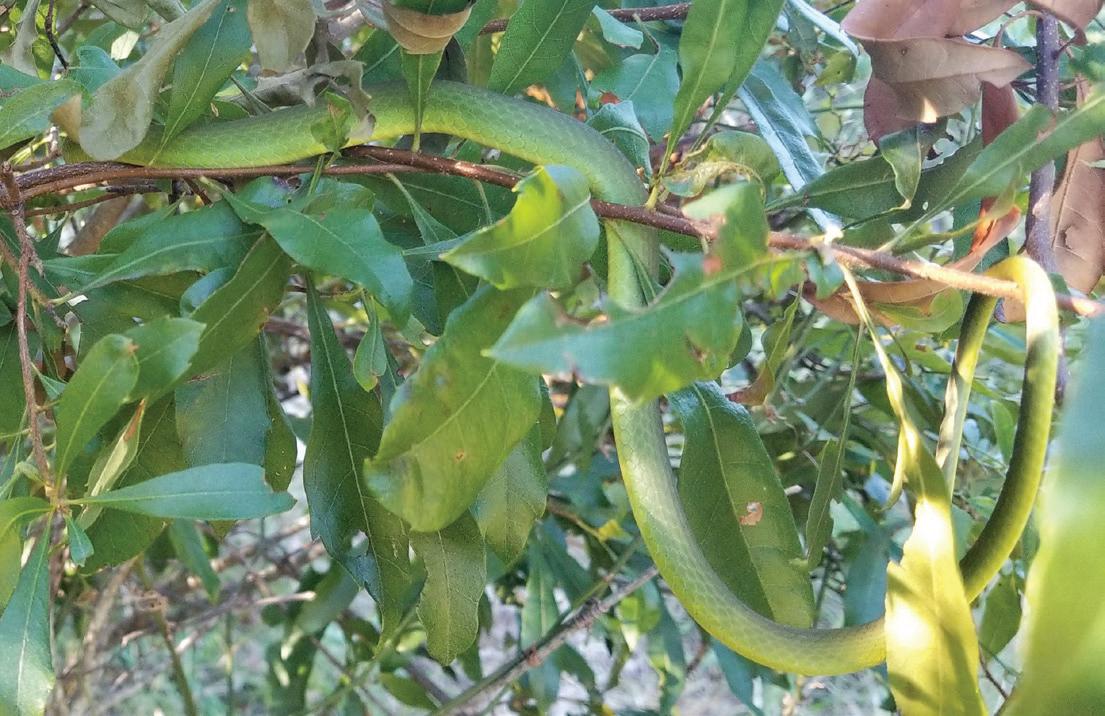
This can sometimes lead to fatal encounters with vehicles. “Their pattern works best when they’re
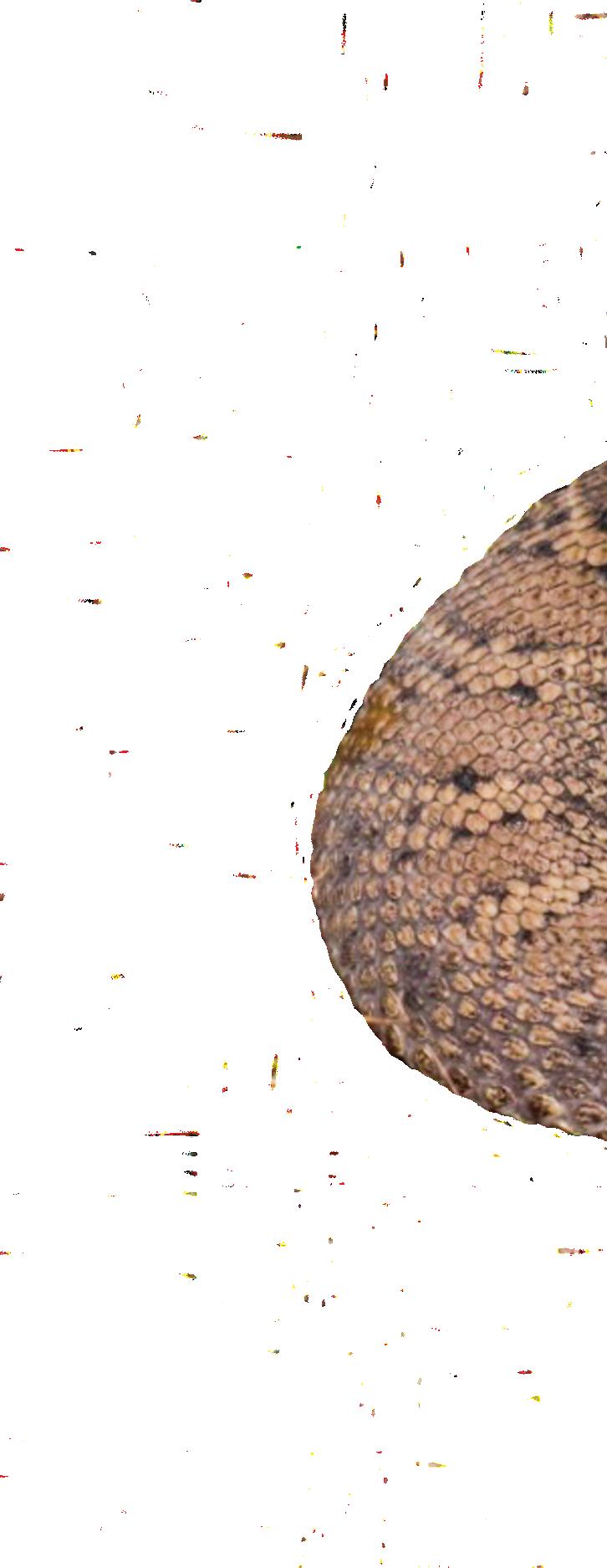
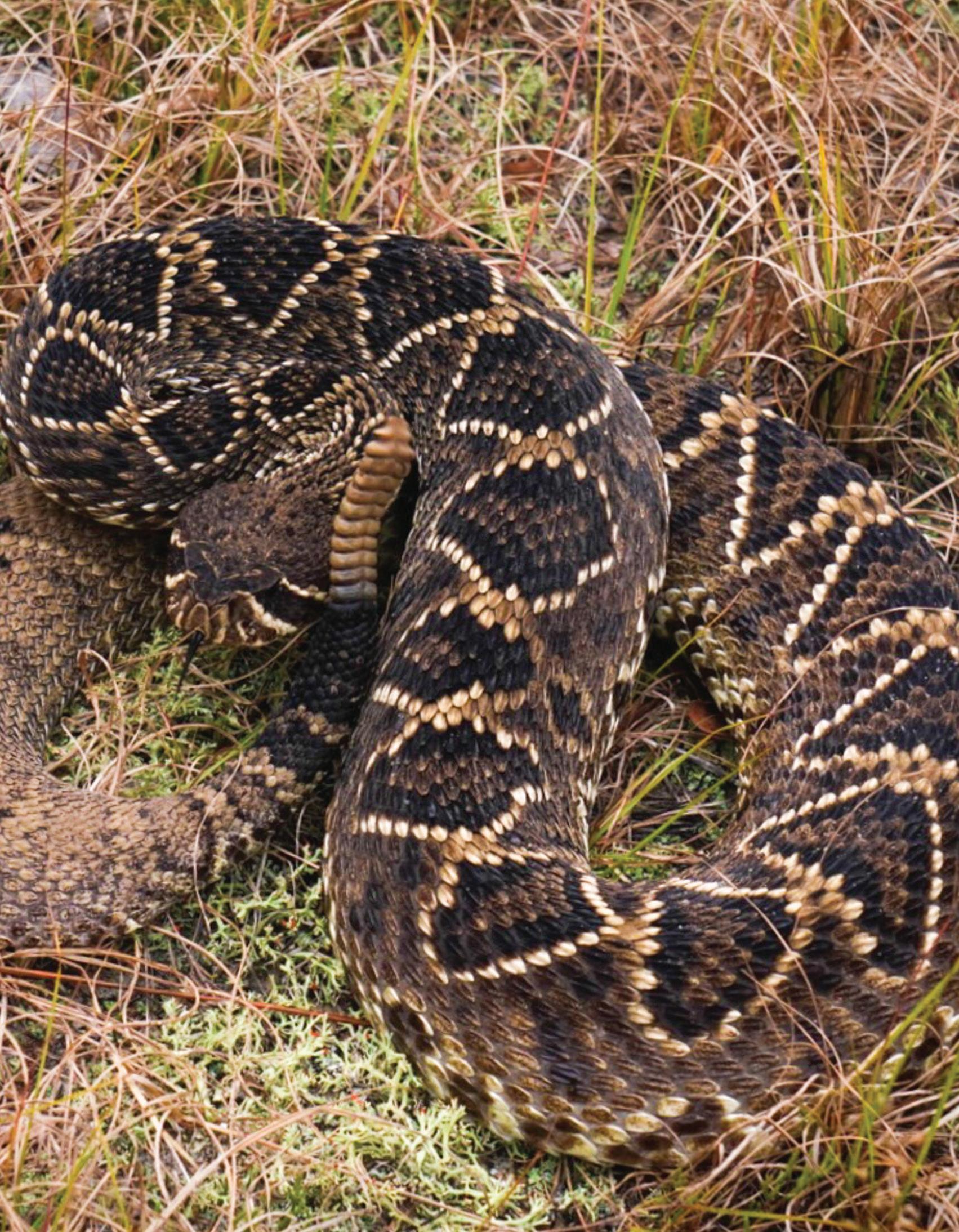
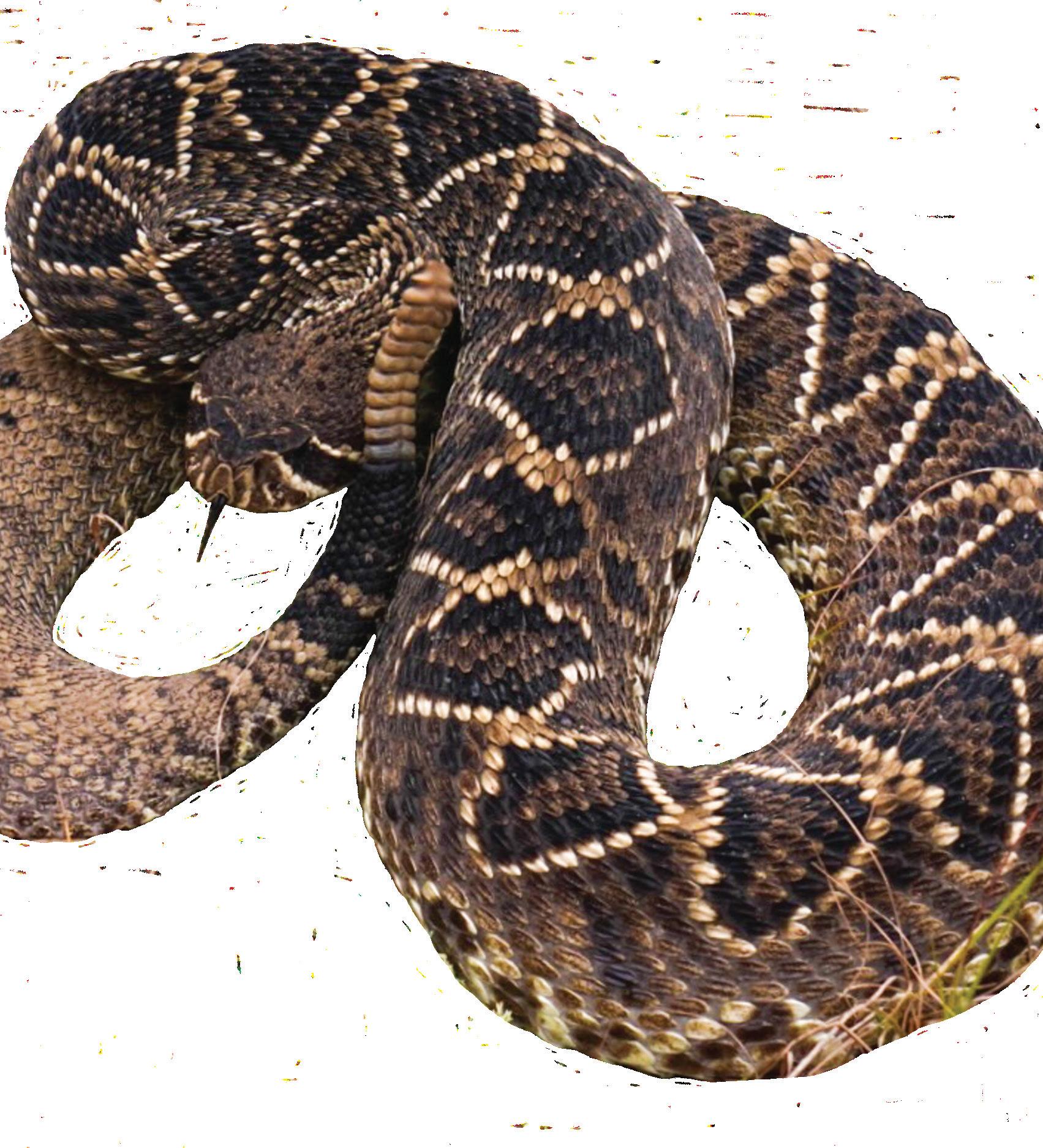
Crypsis is one of the most widely employed biological phenomena used by wildlife. That log near the banks of a pond could be an alligator mimicking a fallen branch, ready to sneak up on prey. Biologist Colbert notes that gators in Florida have even been observed resting on the surface with sticks on their snouts to lure in birds building nests.
Bobcats are another alpha species that commonly hide in plain sight. With spotted and striped fur that mimics blades of grass, sticks, and twigs, bobcats are patient, creeping hunters capable of sitting still for long periods before pouncing on rabbits, squirrels, and other rodents, and sometimes smaller deer. About a dozen adult bobcats have been found on Jekyll to date. “They kind of prowl and are hard to see, like how a cat moves in tall grass with just its eyes sticking out,” says Colbert. “People don’t see them often on the island unless they’re quiet.”
Fawns are also capable of mime-like stillness when threatened. Crypsis is effective when combined with spots that lend the appearance from a distance of sun and shade mixed, but it’s not the deer’s only self-preservation tool. They also have scent crypsis. “If a fawn doesn’t want a coyote to smell it very eas ily, they won’t put off much of a scent and can mask it,” says Colbert.

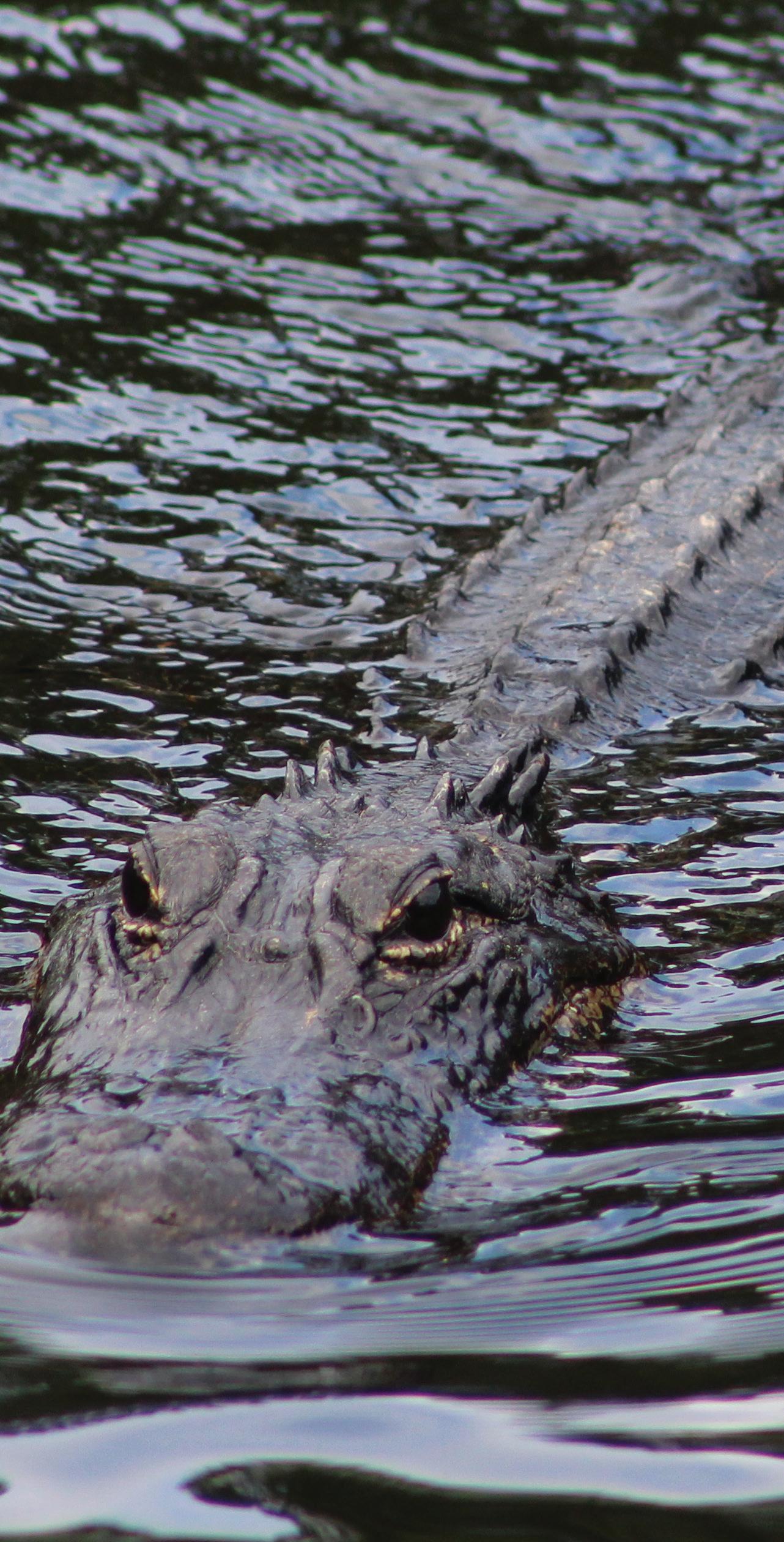


White-tailed deer fawn
Practically any habitat on the island is populated with members of the insect kingdom that employ crypsis. Stick bugs are self-explanatory, and some beetles can pass for little stones. A few moth species are easily mistaken for rolled-up leaves on the ground. In the amphibian world, leopard frogs’ brilliant greens
and other colors are blatant on a sidewalk, but at the edge of a wetland, the animals all but disappear.
Nighthawks and shorebirds such as Wilson’s plovers tend to sit on their nests in dunes, relying on camouflage until beachgoers are practically on top of them. Their spotted eggs, even on close inspection, can look exactly like sand. “We look for their eggs, which sit in a shallow bowlshaped nest that has footprints leading to it,” says Colbert. “The
footprints we follow to track them can’t be found on rainy days.”
Wildlife camouflage on Jekyll extends offshore as well. Hermit crabs are often mistaken for common shells until those shells start trying to crawl out of kids’ buckets. Some tiny jellyfish are almost invisible in the shallows, and at the seafloor, stingrays and flounder use the darker top portions of their bodies to blend into sand, masking themselves from predators above. Other crabs, snails, and turtles use epibiosis,

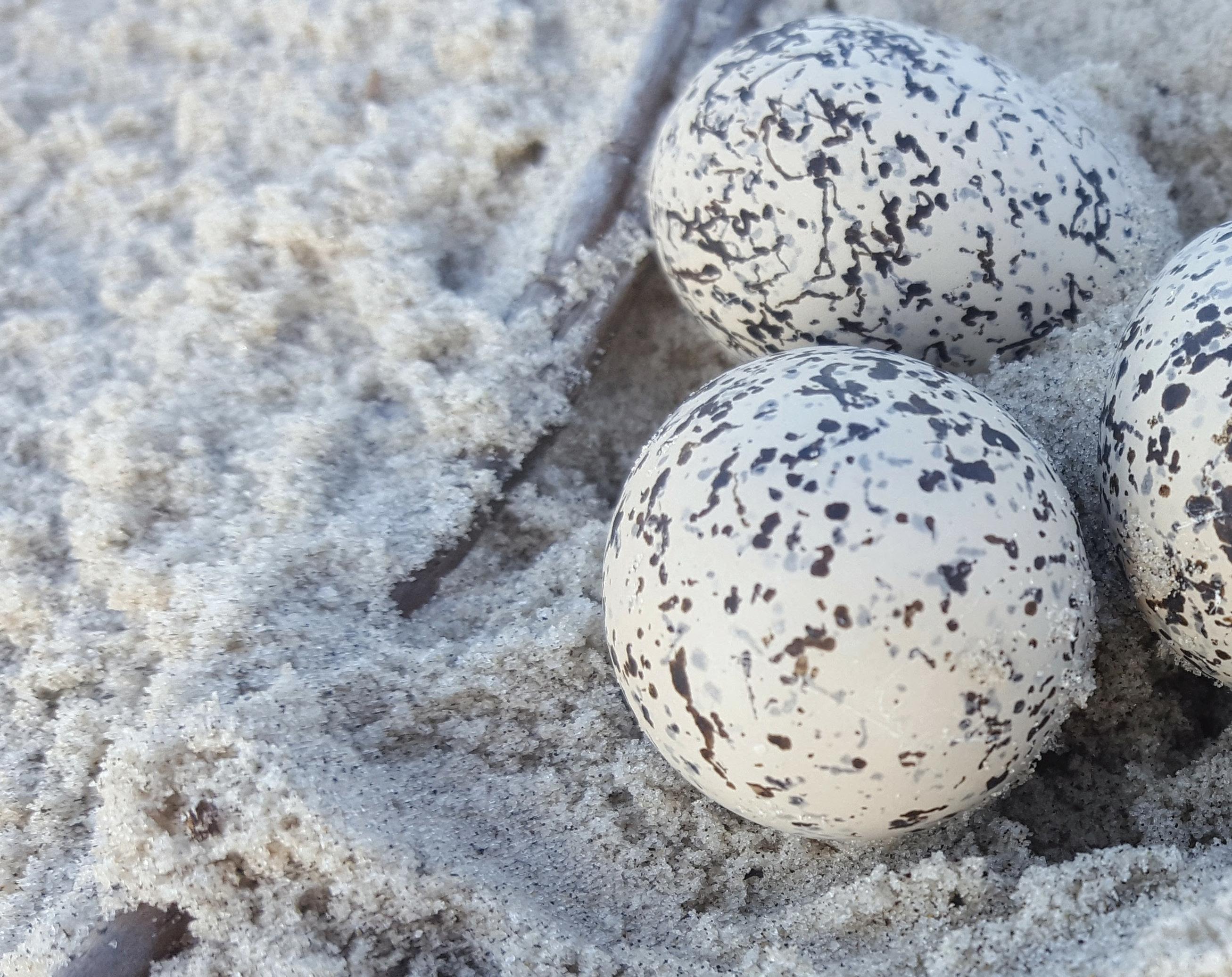
or the process of letting smaller organisms such as barnacles grow on their shells, as a means of disguise.
No matter their size, species across Jekyll rely on human intervention to help crypsis work, whether through habitat restoration or the creation of microhabitats that dot the island. “I created a stick pile, and we found a king snake in it three days later, perusing underneath it,” says Colbert of one recent example. “We were happy about that.”
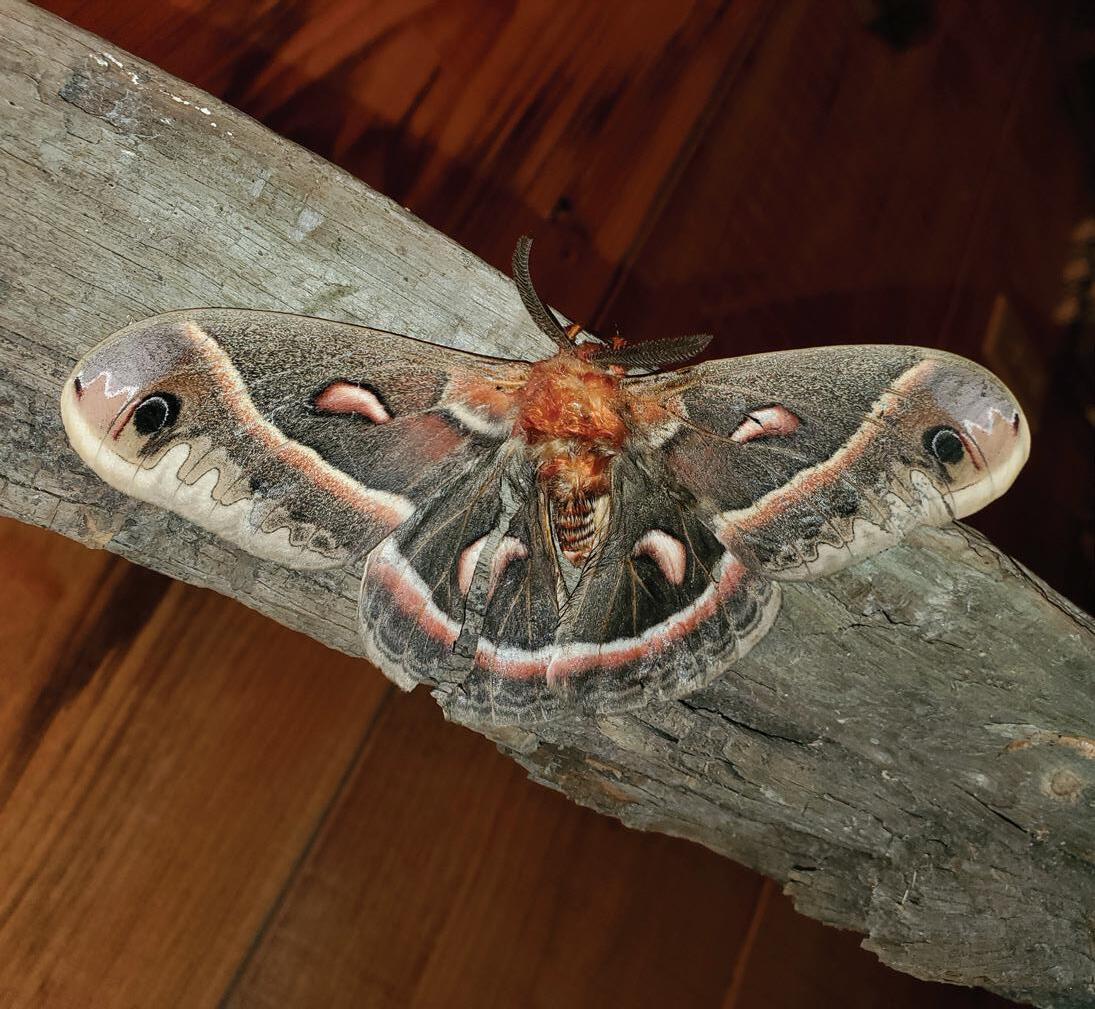
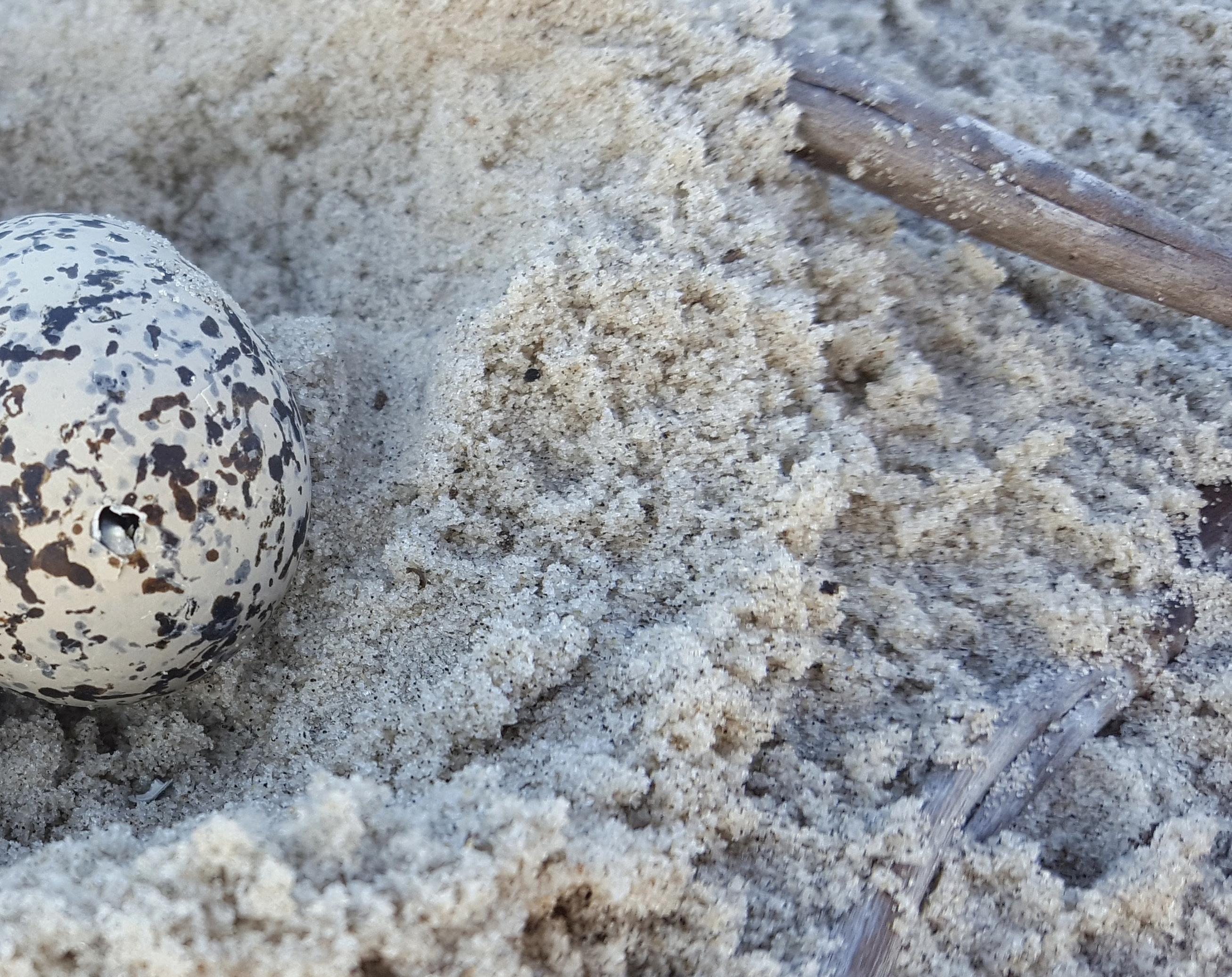
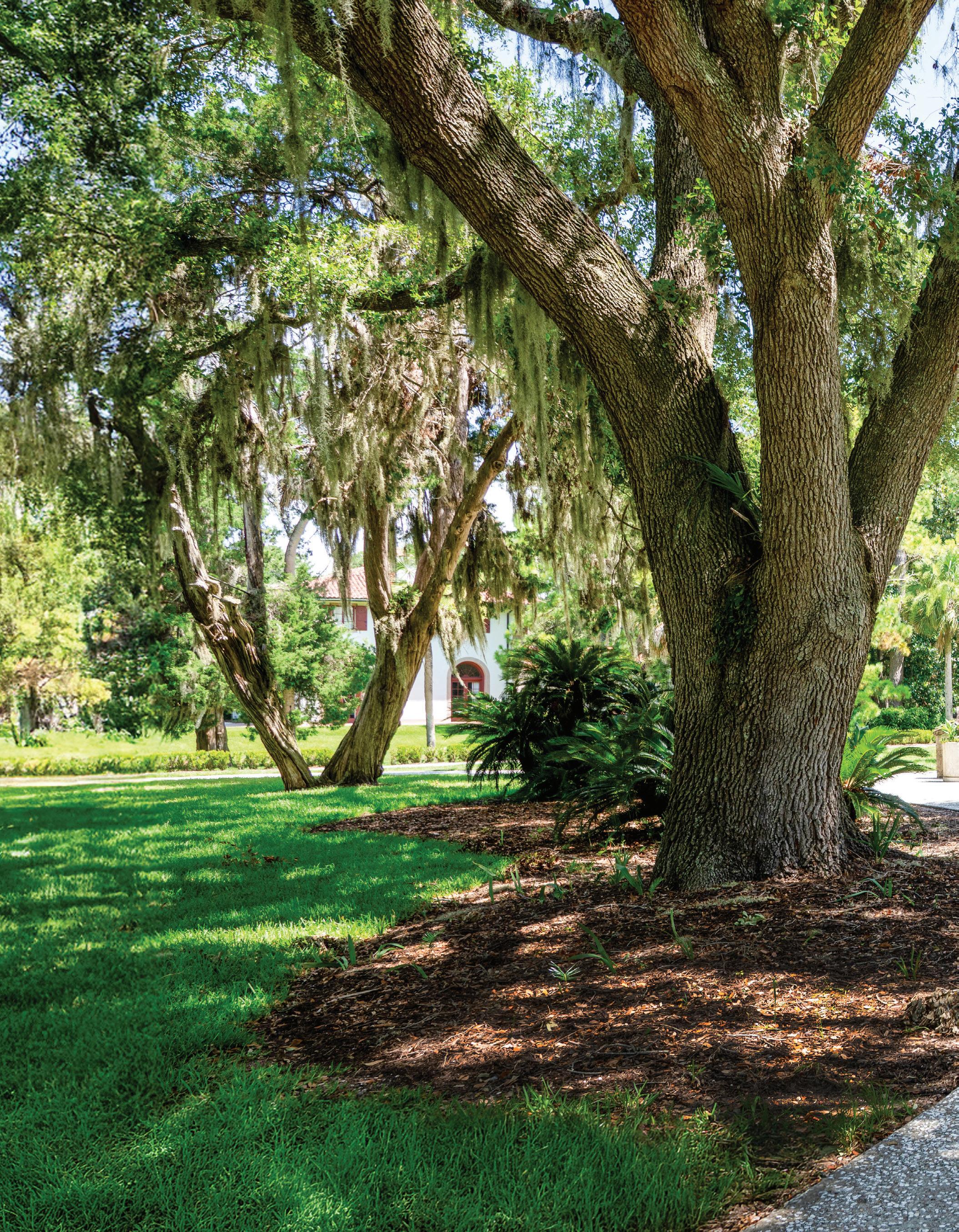
The influential Maurice family’s Hollybourne Cottage re-welcomes guests through a new exhibit
BY RICHARD L. ELDREDGE
PHOTOGRAPHY BY ALLISON LEOTIS
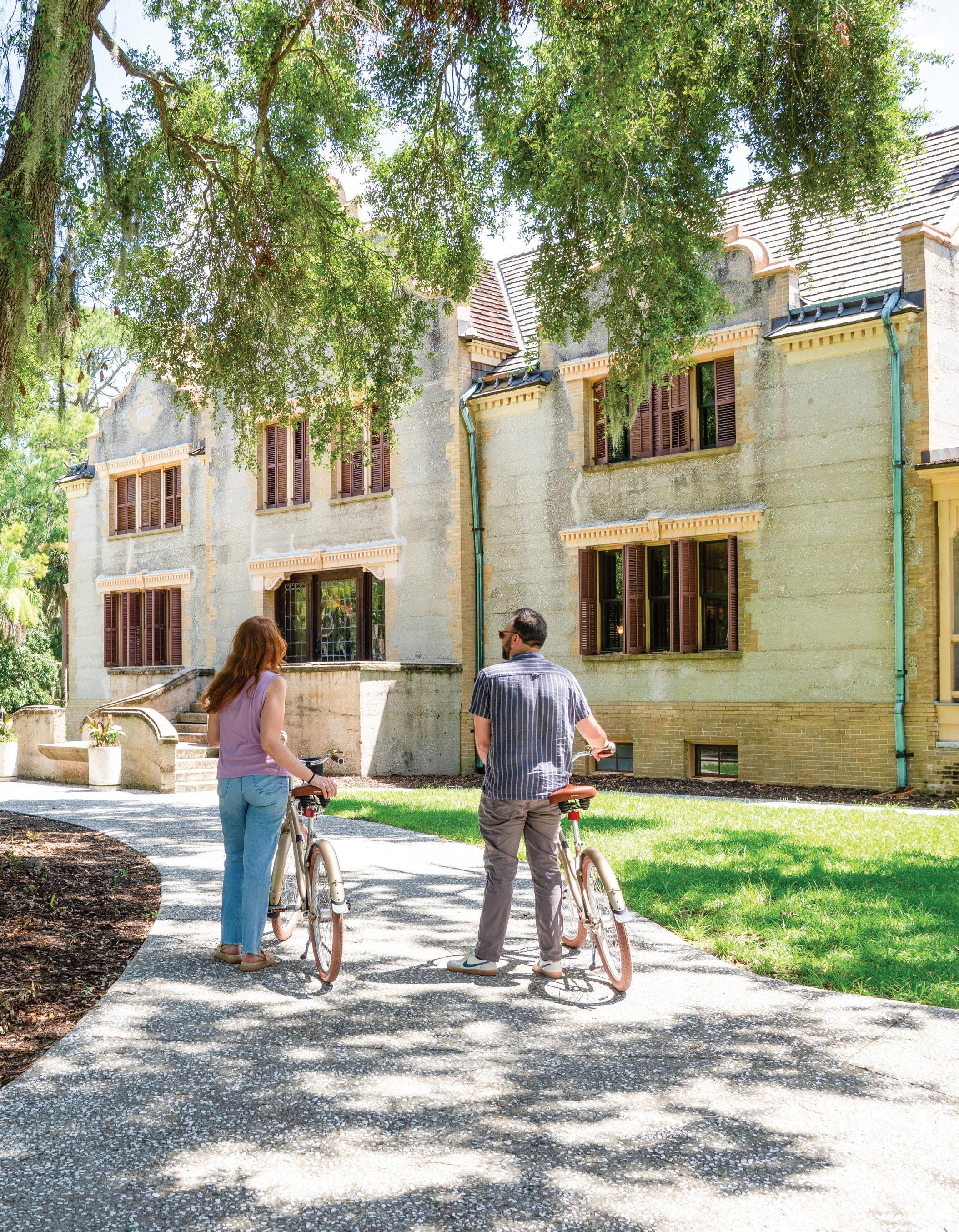
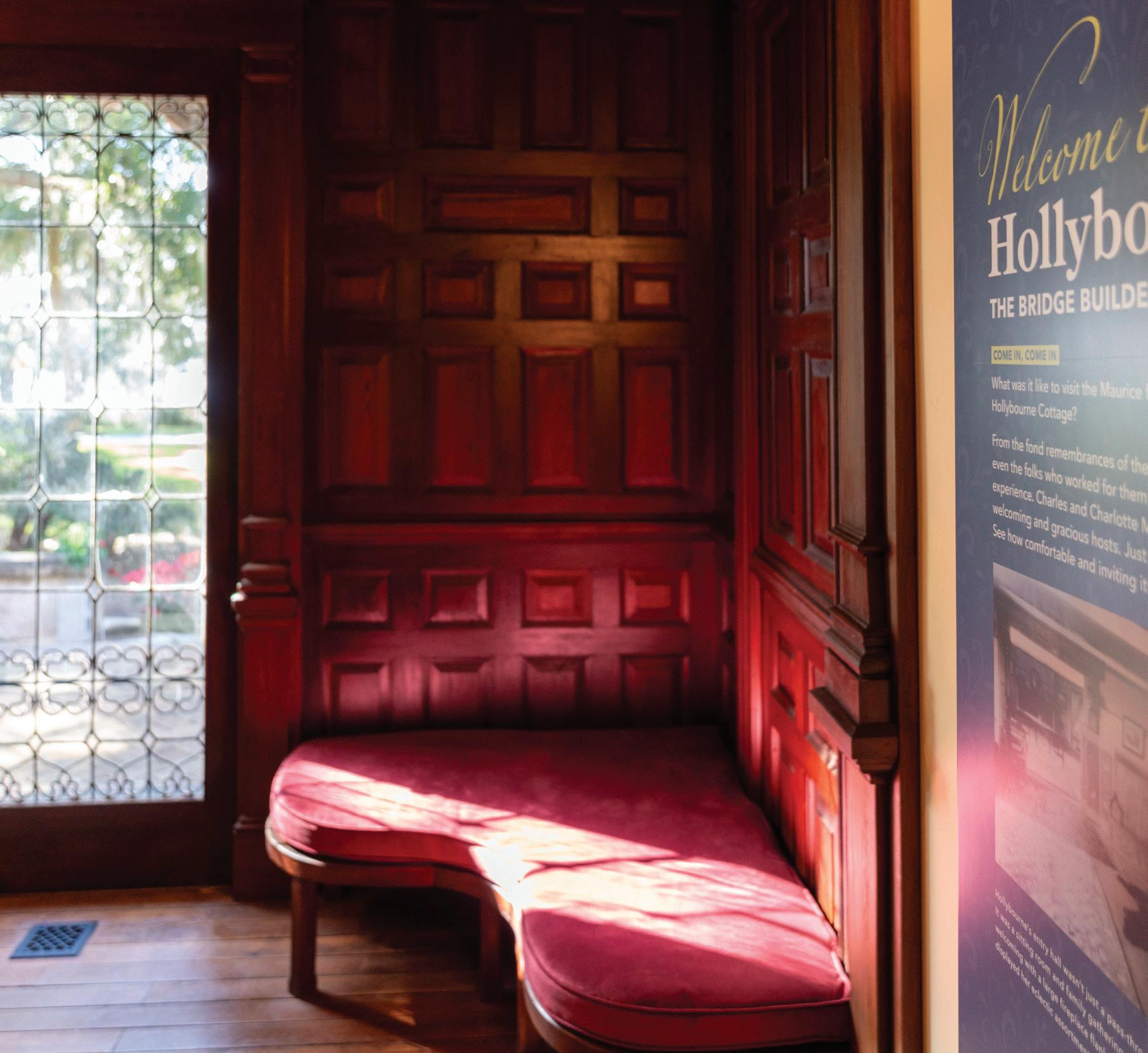
To step inside Hollybourne, the historic tabby cottage built by Jekyll Island Club members Charles and Charlotte Maurice in 1890, is to spend time with one of the island’s most beloved families. Patriarch Charles was an iron bridge pioneer and counted the Memphis Bridge over the Mississippi River among his engineering feats. The Athens, Pennsylvania and Jekyll Island–based family so loved the island that they would often arrive in time to celebrate Christmas and even Thanksgiving on occasion, weeks before everyone else. The Maurices are perhaps one of the only members who retained membership for the entirety of the Jekyll Island Club era, from 1886 until
its final bow in 1947, before the state of Georgia acquired the island through eminent domain.
Now, after decades of rescue and restoration by dozens of volunteers, interns, and staff, the doors to the first floor of the 12,271-square-foot, nine-bedroom Hollybourne are back open. Thanks to meticulous diaries and archived photos kept by Charlotte Maurice and her daughter Marian, the home offers Jekyll visitors one of the most three-dimensional portraits of any of the “Club–Era” families. The sprawling, eclectic Jacobethan Revival Tudor-style structure provides a fascinating glimpse into how one of the island’s most famous families lived.
“Because of Charlotte’s recordkeeping, we know so much more about the Maurice family compared to other Club members,” says Andrea Marroquin, curator at Jekyll Island Museum. Her notes included how they spent their time on the island, who they interacted with socially, and even what they ate for dinner. Archival records show the Maurice family hosted events almost daily, entertaining the likes of the Rockefellers, Kennedys, Goulds, Claflins, Porters, and other Club families.
Now, after decades of rescue and restoration by dozens of volunteers, interns, and staff, the doors to the first floor of the 12,271-square-foot, nine-bedroom Hollybourne are back open.
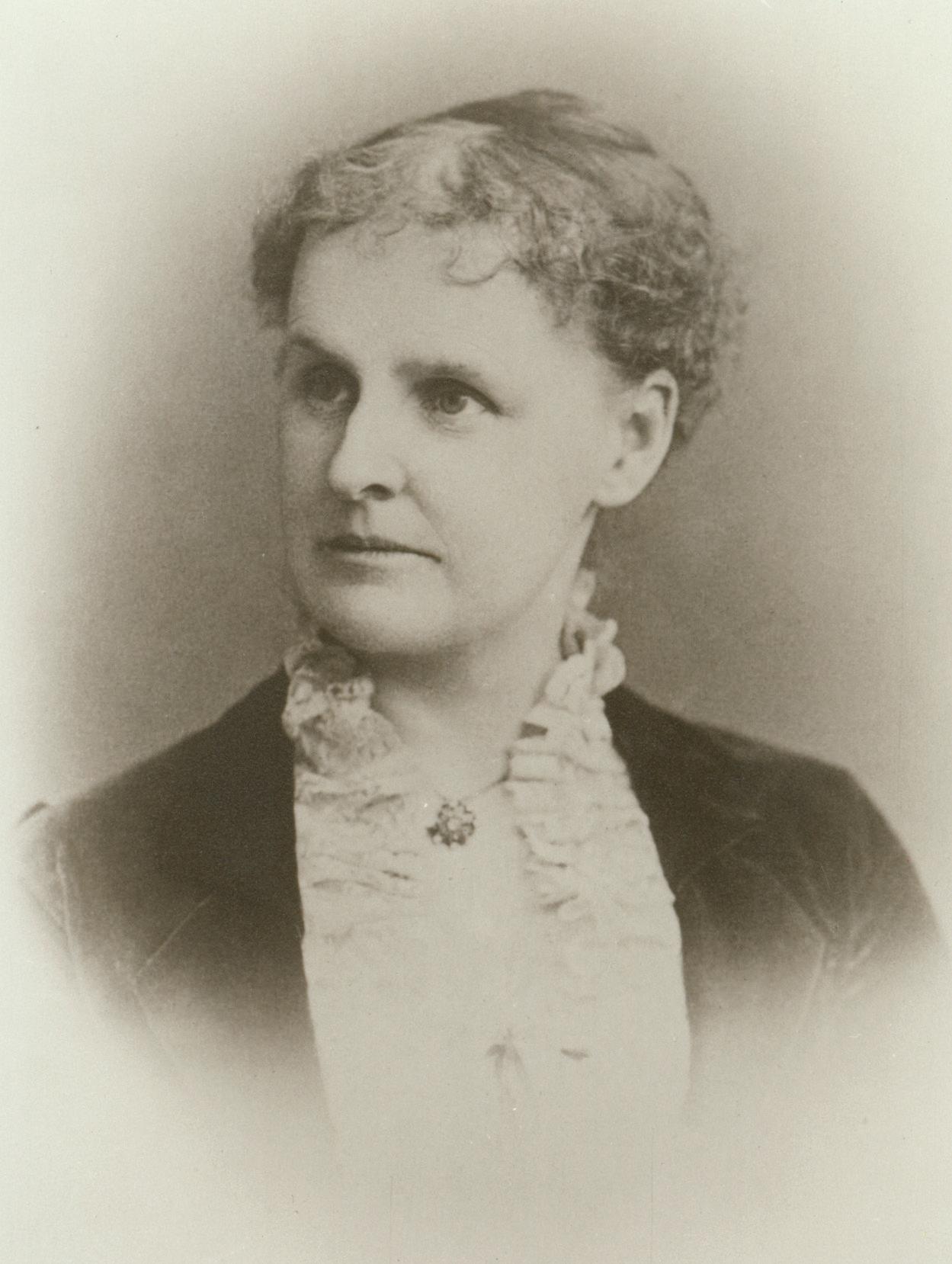

Hollybourne is significant architecturally. It is one of the few remaining cottages constructed with tabby, a concrete mixture utilizing indigenous materials, including lime, sand, and shell. Inside, visitors are treated to one of the cottage’s most unique construction characteristics.
Assisted by architect William H. Day, Charles Maurice put his bridge-building skills to use, reinforcing his home with suspension trusses and stepped piers.
“Because of the structural engineering Charles Maurice brought to Hollybourne, it's quite likely that it prevented the cottage from falling in during years of vacancy,” says Will Wagner, director of historic resources at Jekyll Island Authority. Wagner also credits the creative use of tabby as a reason Hollybourne has successfully weathered 135 years of coastal storms. Among the island’s first preservationists, Charles and Charlotte Maurice were enamored
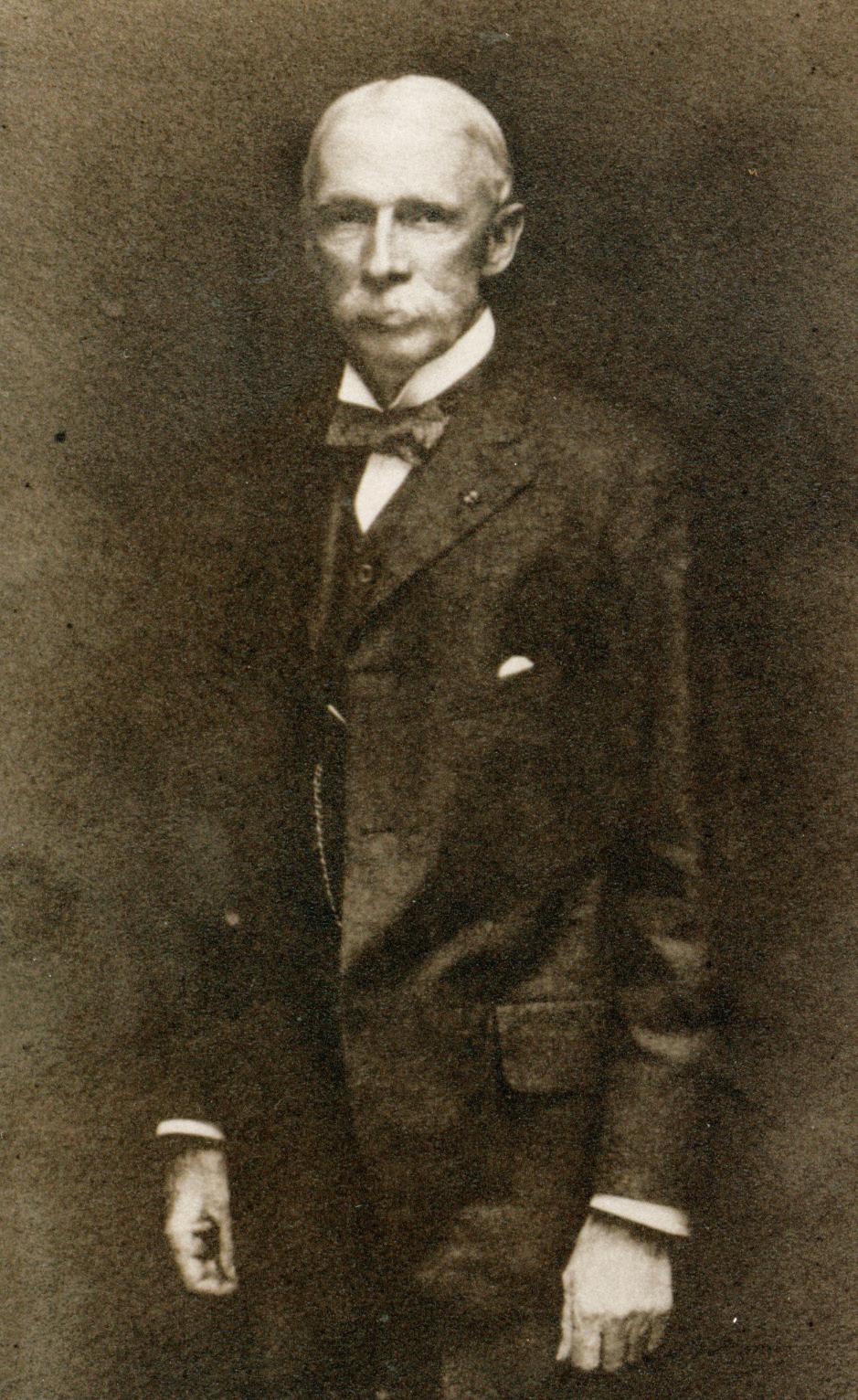
by Horton House, one of the oldest tabby structures in the state that dates to 1743. The couple were among the donors who headed the effort to help save the structure, and used it as inspiration for their impressive cottage.
Now, Jekyll visitors can partake in life as the Maurices saw it, thanks to a new Hollybourne exhibit. Guided tours from Jekyll Island Museum are offered daily. Interactive stations, chock-full of information about the family’s daily life, contain facts gleaned from family letters and Charlotte and Marian Maurice’s diaries. There’s even a naturalist room dedicated to the family’s fascination with the island’s indigenous botany. “The family was so interested in the island’s plant life, they wrote pamphlets on Jekyll’s flora and fauna,” says Wagner.
Legend has it that when the state of Georgia took over the island in the 1940s via eminent domain, including


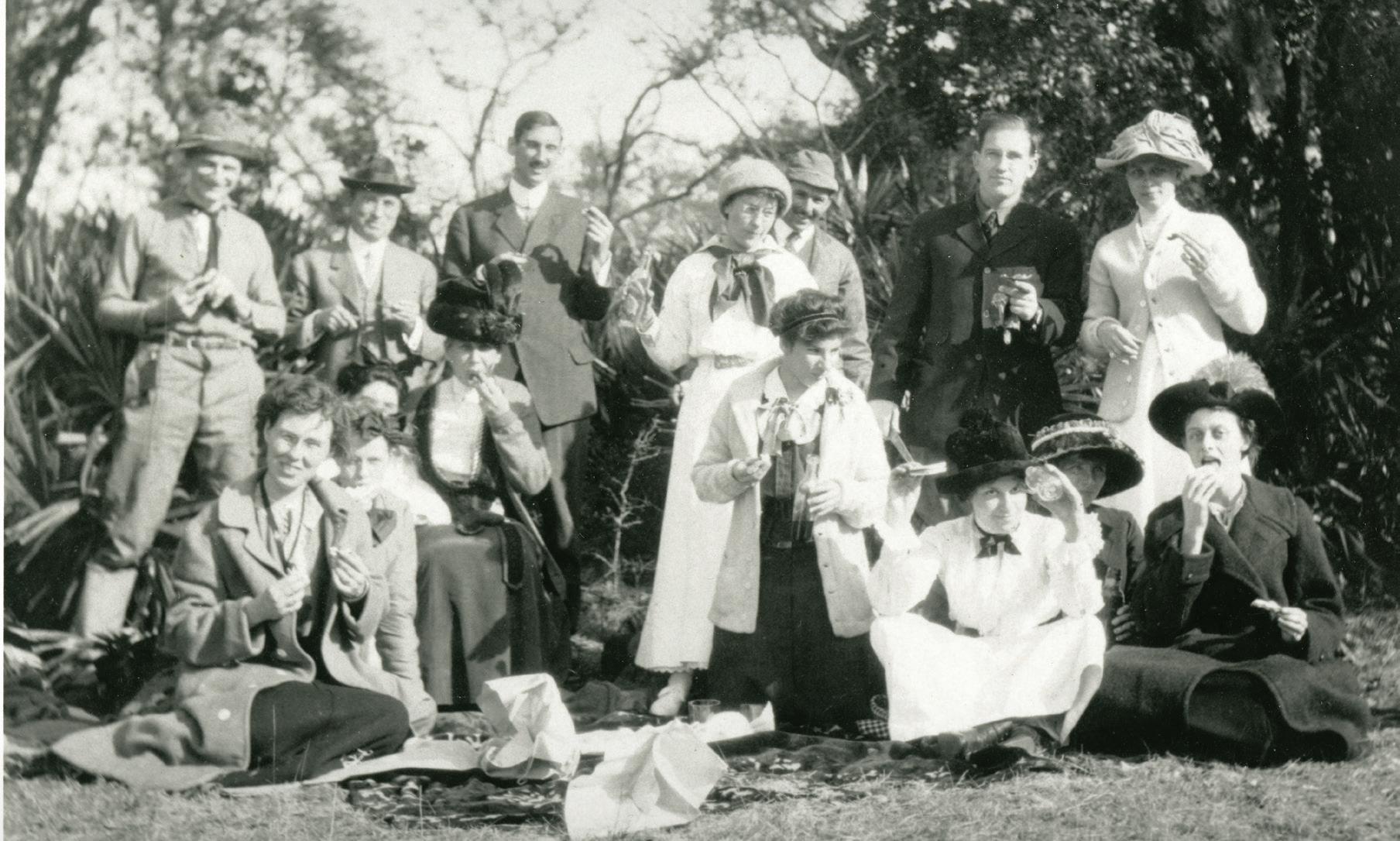
Hollybourne, the Maurice family was so enraged by the loss of their beloved home that they stripped the property bare and dumped the stove into the Jekyll River. Though unconfirmed by historians, this tale has endured over the years. Even after constructing a new Southern winter home in Florida, daughters Margaret and Marian Maurice remained so averse to all things Georgia that they bypassed the Peach State altogether, traveling through Alabama to reach their destination.
Thankfully for Jekyll Island preservationists, tempers cooled over the decades. Following youngest daughter Emily Maurice’s death in 1975, her estate donated the family’s massive dining room table that had accommodated Charles and Charlotte plus their nine children, to the island’s museum.
"Watching an entire community come together to save Hollybourne and to make it safe and once again available to the public has been transformational.”

The refinished family heirloom was proudly on display for the 2017 marriage of great-granddaughter Holly Maurice McClure’s wedding at the home, the first family gathering held there since 1942. “We’re glad those wounds have healed and that we’ve reconnected with the family now,” says Wagner.
The rehabilitated Hollybourne is a tribute to the decades of work from staffers, preservationists, interns, and volunteers, an effort that dates back to 1999. Marroquin chooses to see the 25-year labor of love with a glass-half-full attitude. After decades of disuse following the state’s takeover of the island, Hollybourne began deteriorating. Ceilings had fallen in, and flooring had given way to the elements. “The positive thing about that time is that, because there was no plan for the building, it wasn’t torn up or repurposed,” Marroquin explains. “It became a time capsule. Watching an entire community come together to save Hollybourne and to make it safe and once again available to the public has been transformational.”
In addition to daily tours via the Landmark Trolley Tour, Hollybourne’s lawns, its rebuilt side porch, and signature horseshoe driveway have become popular destinations for weddings and other social gatherings, including touchingly, the nuptials of two preservation interns who met while working on the project.
While visitors enjoy daily deep dives into the Maurice family’s luxurious Gilded Age lives, Jekyll Island Authority’s preservation team is hard at work developing design plans for phase two of the exhibit. The effort will restore some of the bedrooms on the second floor and include interactive spaces for school-aged children. Phase three of the project will focus on restoring the attic where the Maurice children spent hours playing.
“It’s an ongoing, living, breathing, learning laboratory,” says Marroquin. “The goal is for visitors not only to learn more about this Gilded Age environment and the people who lived here, but also how this past has been preserved.”



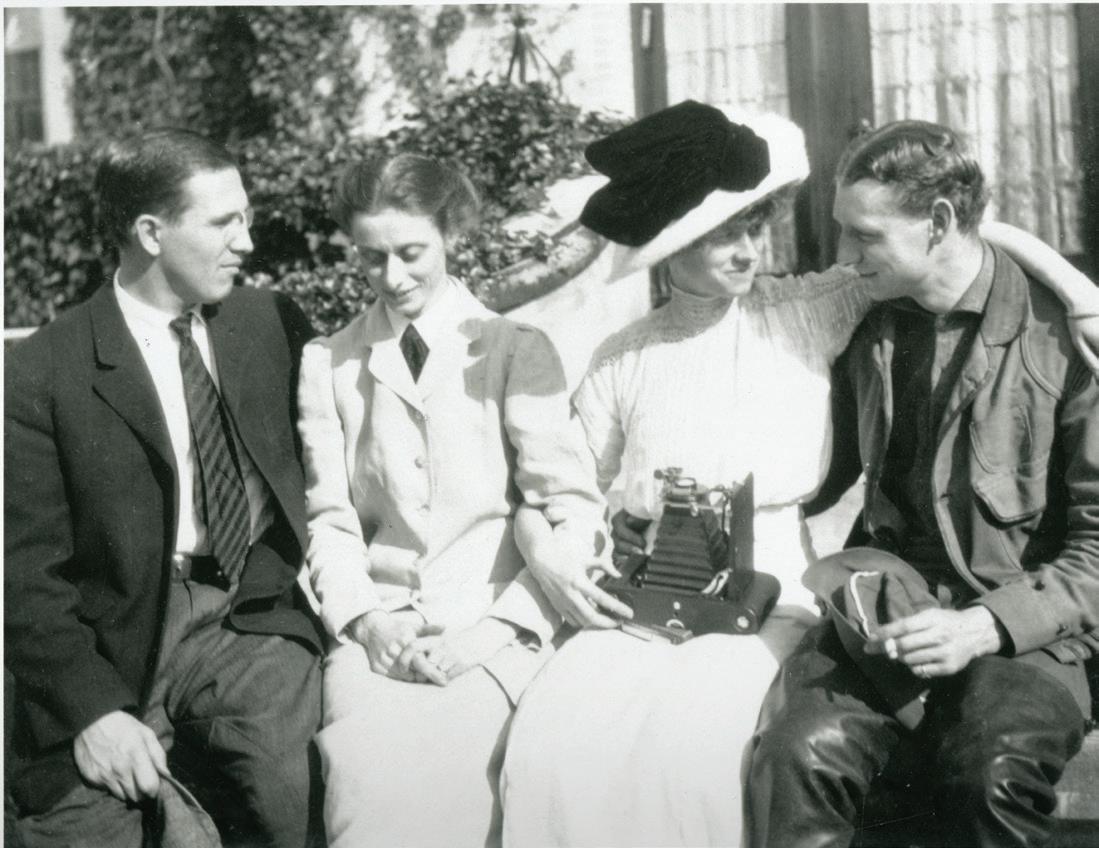
In 1903, frequent dinner guest and fellow Club member Frederic Baker wrote rhapsodically to bridge builder Charles Stewart Maurice about his evenings spent at Hollybourne, telling his host, “The associations are too pleasant to relinquish. Too many heart-to-heart talks in that sofa near the fire in the south-east room, too many good dinners, too many good chats after dinner. I do not forget the cherry cordial—to be relinquished."
He’s referring to Charlotte’s wistfully remembered, crowd-pleasing Cherry Bounce liqueur. Charlotte’s recipe called for, among other things, cherries to be infused in a gallon of whiskey for weeks and creating a simple syrup using a pound of sugar with two quarts of liquor. Historians at Jekyll Island Museum have simplified her recipe for today’s tastes.

Developed by Will Wagner, Jekyll Island Authority's director of historic resources
• 1 oz. cherry syrup
• 2 oz. bourbon
• 2 oz. orange juice (fresh-squeezed is recommended)
Add all ingredients to a cocktail shaker and shake well. Strain over ice into a lowball glass. Splash in a dash of cherry bitters. Float a bit of sparkling water on top. Garnish with a dried orange slice and a Luxardo cherry.
From Gilded Age motorcars to dolphin-filled waterways, how to explore Jekyll Island
By Tyra Douyon
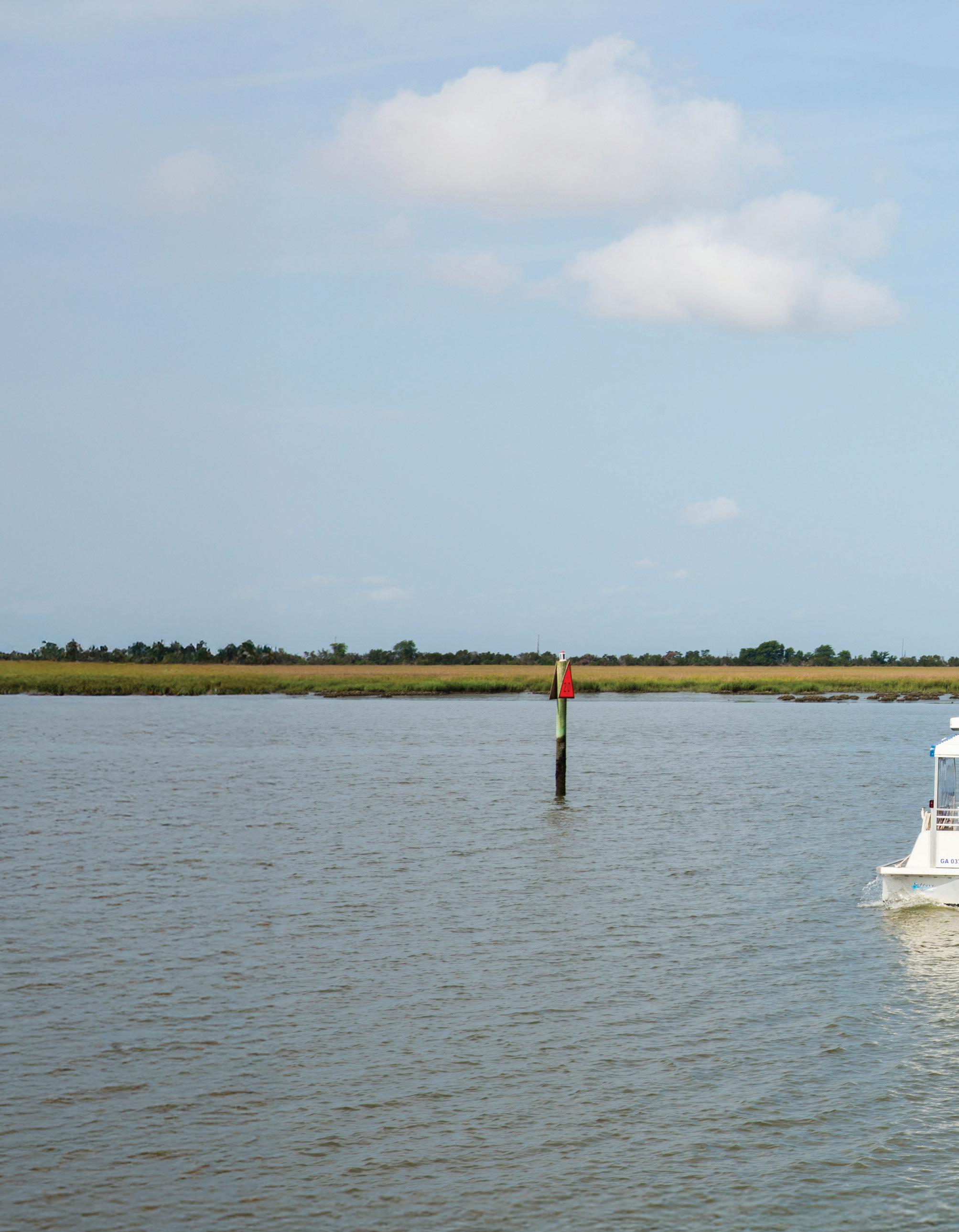

Hop aboard with Captain Phillip of Jekyll Island Boat Tours for a shaded, open-air dolphin cruise that showcases what makes Jekyll Island so special from the water. Departing from the Jekyll Wharf, these small-group boat tours wind through the island’s scenic estuaries, where you might be lucky enough to spy bottlenose dolphins leaping through the waves. The experience is part wildlife safari, part ecological lesson: you’ll learn about the island’s salt marshes, migratory birds, and maritime heritage. Tours run about 90 minutes and are timed around the tides. Advanced booking is encouraged.

For a luxe time-travel experience, get chauffeured around in a replica of a 1903 Model T and explore Jekyll Island the way America’s elite once did. The Millionaire Motorcar Tour departs from Jekyll Island Museum, and offers a private, open-air ride through the Historic District, complete with a personal guide to explain the island’s stint as a winter retreat for the wealthy. The car is a showstopper with vintage styling, leather seats, and all the Gilded Age charm you’ll love. It’s an ideal option for small groups or celebrating special occasions and provides a slower, cinematic way to take in the scenery.
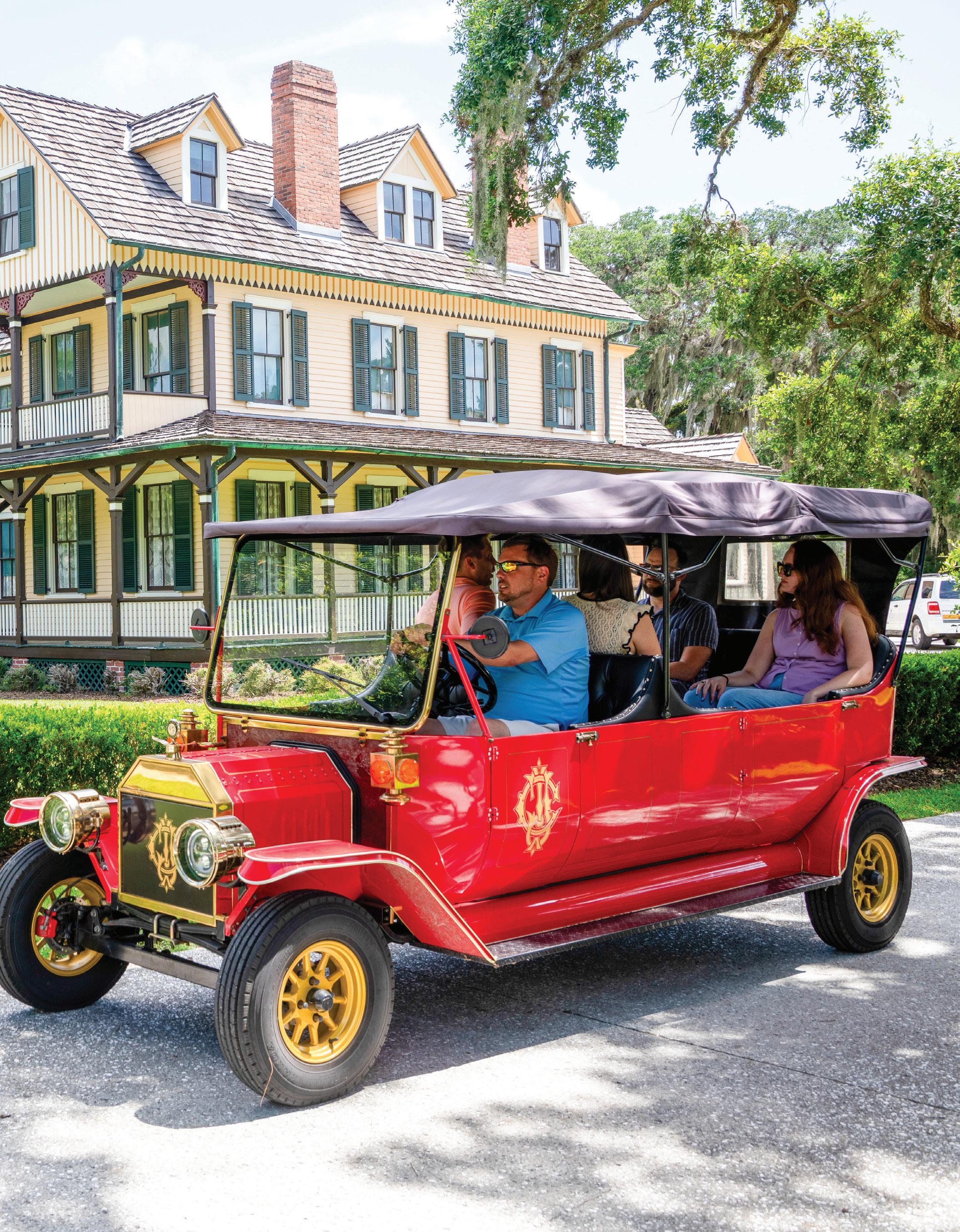
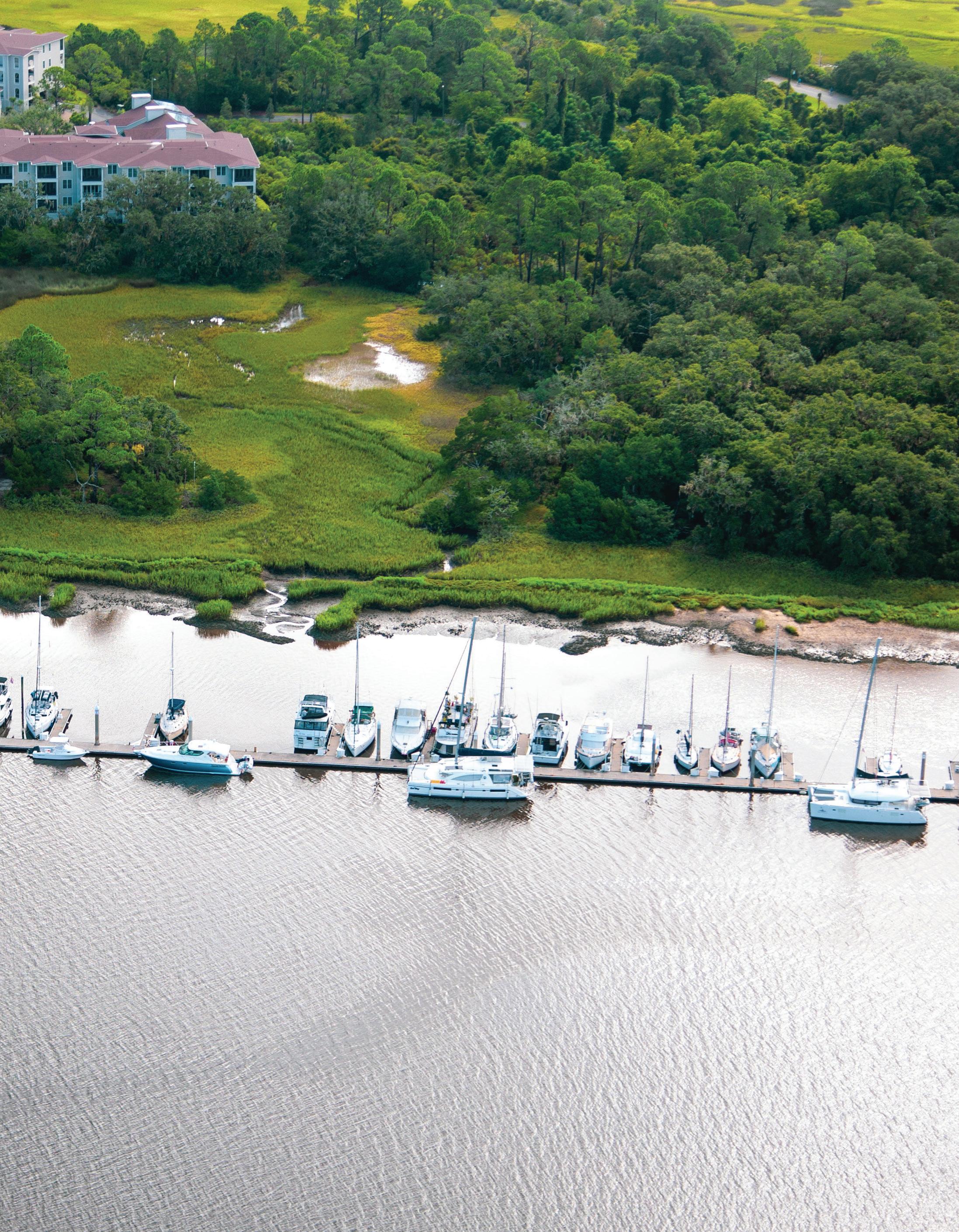
Take your sightseeing sky-high and see Jekyll like you’ve never seen it before. High Tide Aviation’s plane tours offer a 20-minute, 25-mile bird’seye view of the island and include highlights like Driftwood Beach, Jekyll Pier, Shark Tooth Beach, Jekyll Island Club Resort, and more. Your pilot will point out dolphins, sea turtles, and sharks below and give an overview of the area’s history, putting it all into perspective, literally. The plane departs from nearby McKinnon-St. Simons Island Airport and can be booked with a Discovery Flight upgrade to include a mini flying lesson.
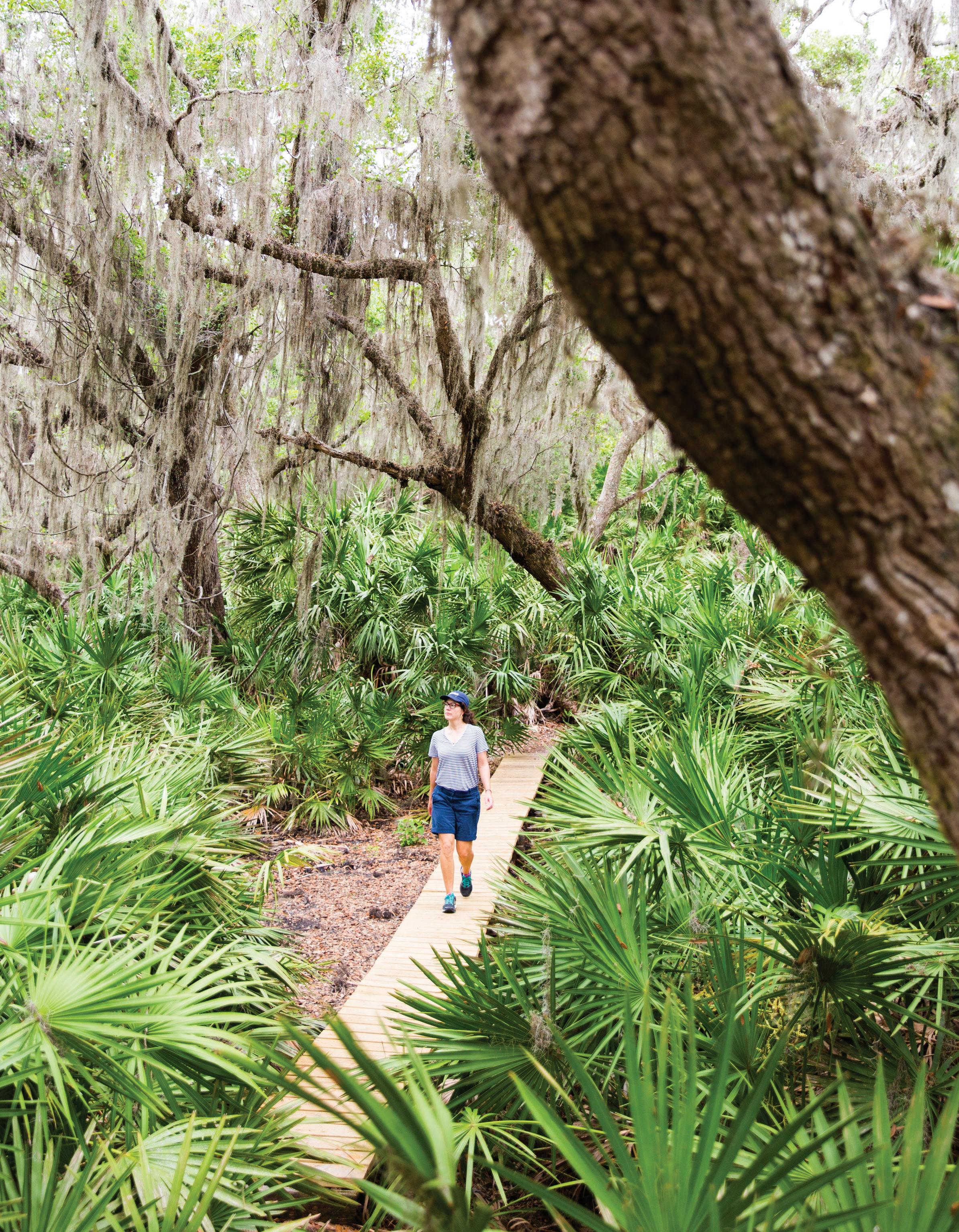
Sometimes the best way to connect with a place is on foot. The Jekyll Island trail system has over 30 nature and urban trails, including family- and pet-friendly routes. Do the 0.3-mile hike to Driftwood Beach, or stroll the 1.4-mile road from Horton Pond to Horton House. The Jekyll Island North Loop trail offers a comprehensive 18-mile excursion, while the very walkable Historic District makes it easy to wander and get steps in while learning about the Gilded Age. Jekyll Island Museum even has a selfguided walking tour with maps and interpreted signage to help you identify buildings such as Faith Chapel, which boasts an original Tiffany stainedglass window.

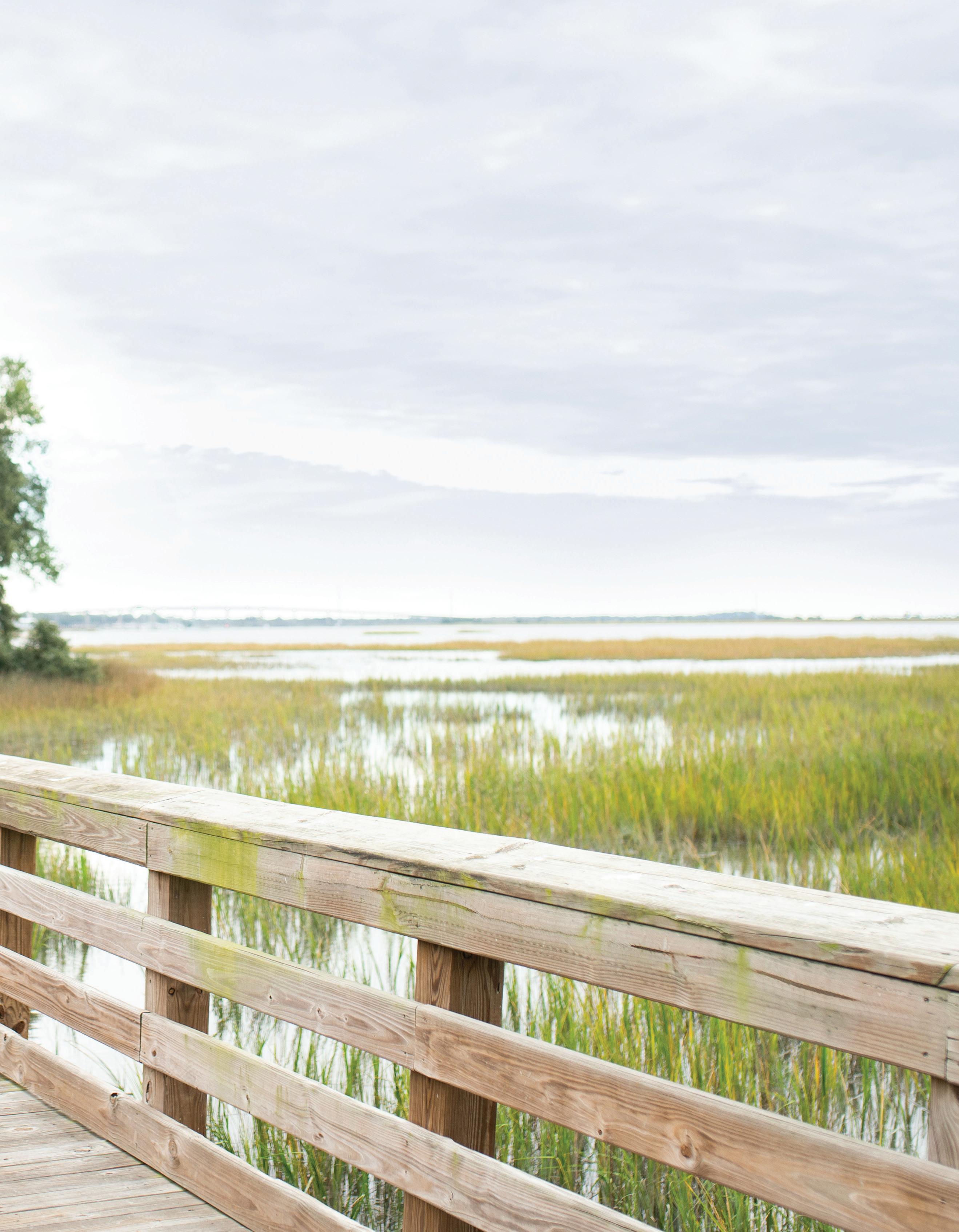
Cycling around Jekyll feels like unlocking a secret level of freedom. With more than 24 miles of flat trails looping through beaches, forests, and historic sites, it’s one of the easiest and most scenic ways to explore. Rent two wheels from one of the many island outfitters like Bike Jekyll, which can provide everything from tandem bikes to four-person surreys to kid bikes. Pepper your route with stops like Driftwood Beach, Horton Pond, and Jekyll Island Sweets, where you can cool off with an icy sweet treat.
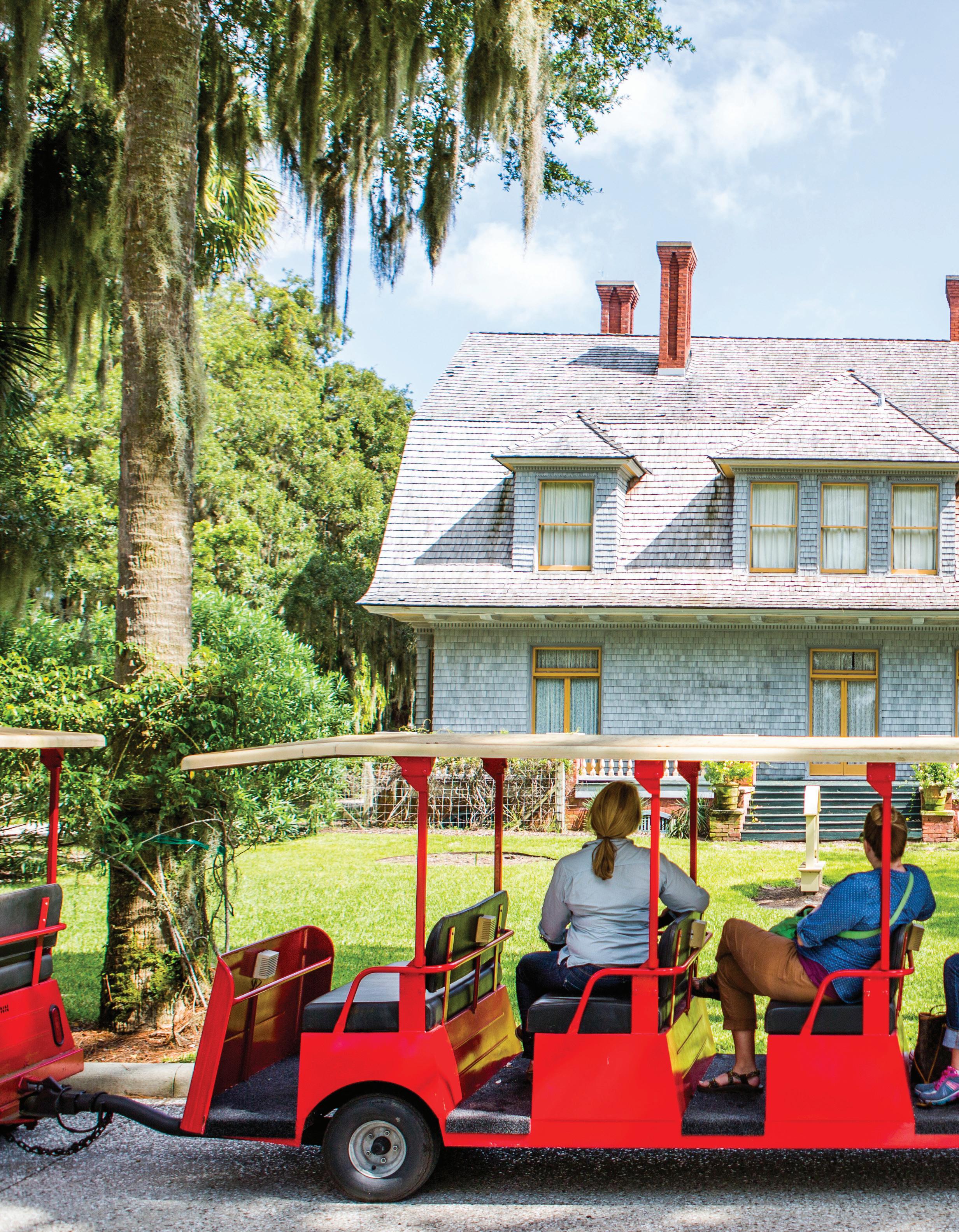
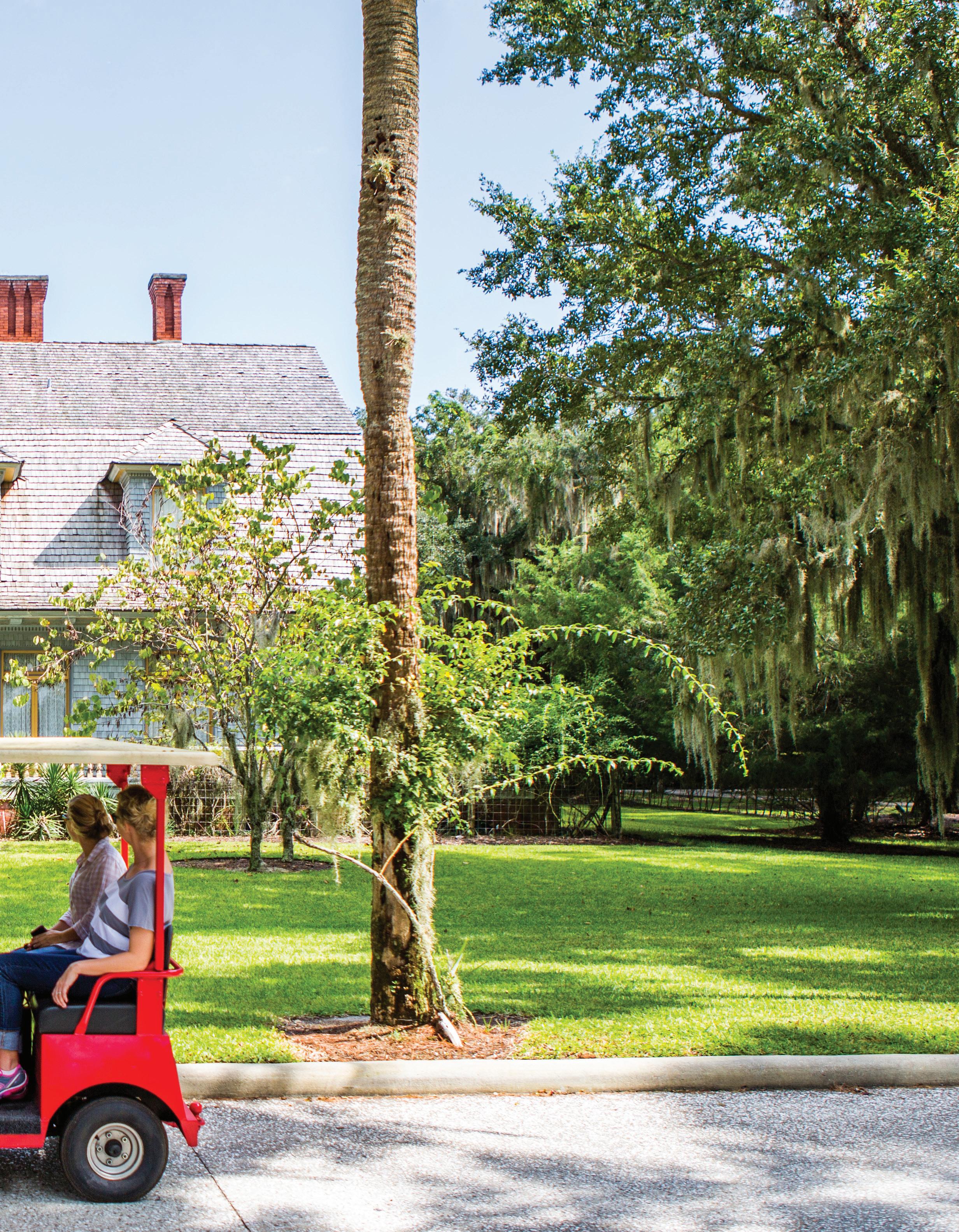
Soak up history without breaking a sweat on the Landmark Trolley Tour. This guided ride in a vintagestyle trolley offers a front-row seat to the island’s Gilded Age homes. Wind through the 240acre Historic District, passing by restored cottages once owned by well-known family names like the Rockefellers, Vanderbilts, and Pulitzers. This adventure includes a guide who brings the past to life, sharing stories of the island’s wealthiest families. Tours last 60 minutes and begin at Jekyll Island Museum. Admission includes entry into a historic cottage and admission into the museum gallery and Faith Chapel.
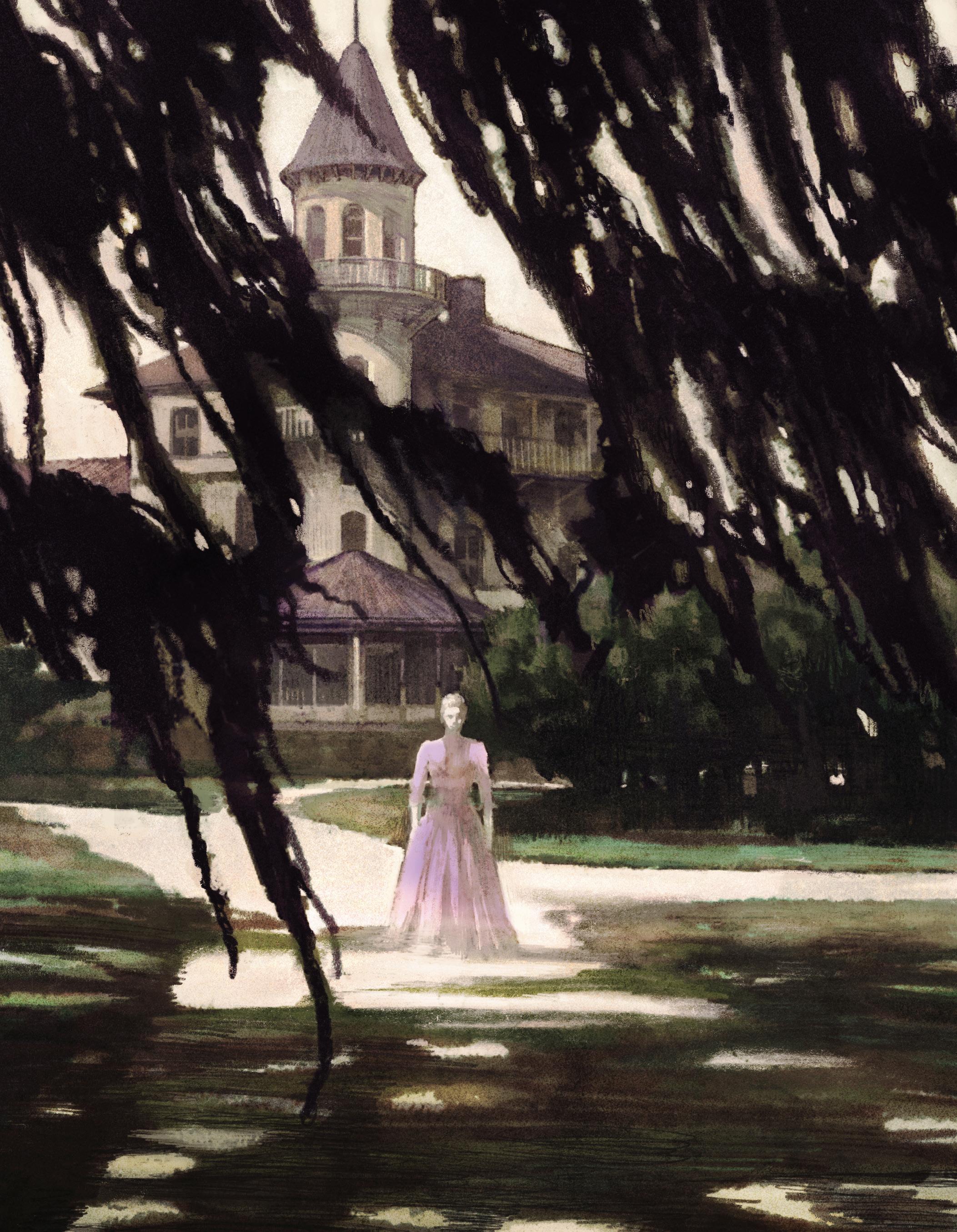
BY TONY REHAGEN ILLUSTRATIONS
BY HOKYOUNG KIM
That’s a question everyone asks themselves at some point, but it seems that Jekyll Islanders are faced with it more often than others.
Humans have inhabited this land for thousands of years, so it’s not unreasonable to think that some of these beings—be they Native Americans, French explorers, English colonists, enslaved Africans, or wealthy Club Era elites and their attendants—have left a spiritual or metaphysical part of themselves behind. And if the living truly share this isle with ghosts, then natural and supernatural are bound to cross paths occasionally. An eerie sound, a foreign scent. A strange shadow or perhaps a fully formed apparition. Or, it’s just a feeling of being watched or not being alone. A chill, a shudder, an experience the rational mind can’t quite explain.
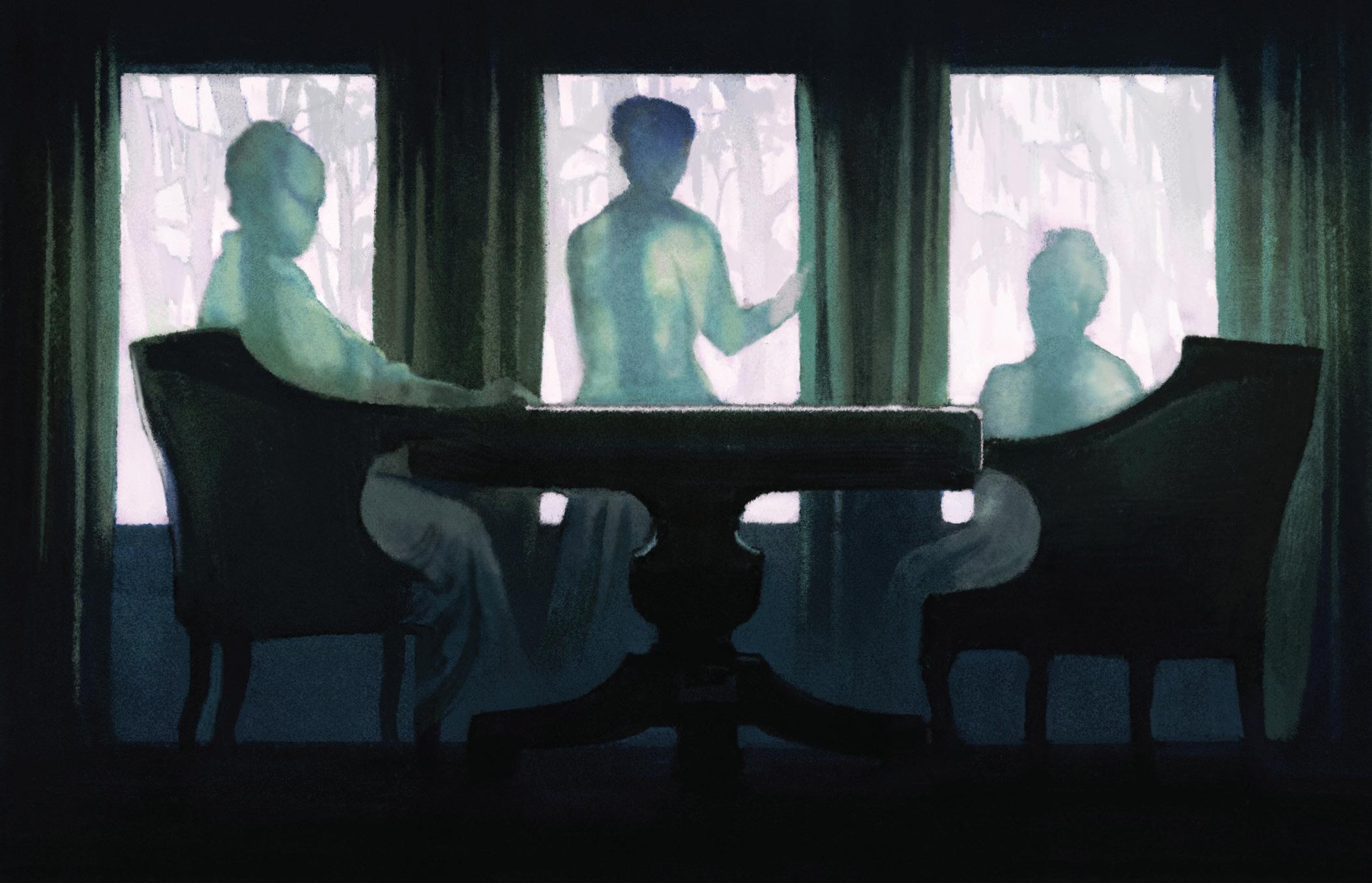
“Iam pretty sure there’s a logical explanation,” says Taylor Davis, historic preservationist with the Jekyll Island Authority. “But I don’t know what it is.” Davis is referring to an incident in 2017, when he and a guide were entering Moss Cottage in the Historic District. It was after hours, so the two had come in through the back door. When Davis tried to close the door, he felt the knob turn in his hand and the door pulled away from him. He paused, then jerked the door shut and locked it. “Whatever it was,” says Davis, “it needed to have the door open.”
Built in 1896, Moss Cottage appears to be an epicenter of ghostly activity, both man-made and mysterious. In the late 1990s, the green two-story building was set up as a Halloween haunted house. It was complete with an upstairs maze, a moving wall, and a guillotine.
But as Davis discovered, the Gilded Age abode didn’t need smoke and mirrors to be spooky. A tour guide once told Jekyll Island Museum manager
Will Story that Moss Cottage spoke to them. “I initially took that to mean that there was something about the building that appealed to him,” says Story. “But he said he heard actual voices, indistinct conversations when he was there.” Moss Cottage has never spoken directly to Story. However, once, when he was conducting a Saturday tour on the first floor, everyone heard footsteps and doors opening and closing upstairs. He assumed it was the collections manager rummaging through artifacts in second-floor storage—until Story remembered she was off for the weekend.
In 2023, Lucy Hatcher was in her first year as assistant manager at the museum, where she got to lead a ghost-themed tour of Moss Cottage. Because it was October, the staff had installed some special effects for guests on the tour, but the sudden slamming of the pantry door in Hatcher’s face, blowing her hair back, wasn’t one of the gags. “Whoever was in there was done with us,” says Hatcher. “I told them I was sorry, it was our last tour, and we’d be leaving now.”

Of course, Moss Cottage doesn’t have a monopoly on Jekyll’s paranormal activity. “The entire island has a rich and varied past, so we can only assume that there are ghosts elsewhere,” says Story. “But many of the sightings seem to be concentrated in the Historic District.”
In one instance, Story was closing up DuBignon Cottage, the former home of John Eugene DuBignon, the founder of the Jekyll Island Club. He was turning off all the lights and locking the doors when he suddenly got the impulse to press one of the electric call buttons that once summoned servants from their third-story quarters. The buttons had long been disconnected, yet no sooner had he turned from the button than he heard a door open
on the first floor. Story rushed down to find the entrance to the staircase that leads to the servants’ quarters wide open. “It was as if I had summoned the staff,” he says.
Barry Moore is familiar with DuBignon’s connection to the realm beyond because he lived there from 1961 to 1988 when his father worked for then Secretary of State Ben Fortson as a foreman for the state. He remembers his mother’s empty rocking chair constantly rocking back and forth by itself in the living room. His oldest brother recalls seeing the shape of a little girl playing with dolls on the floor of his room. Once, Moore was half-asleep when he heard his mattress squeak. He looked down to see the imprint of a body sitting on the bed, but no body. “I took my pallet and headed to the living room,” says Moore.
Paranormal activity has also been seen at Mistletoe Cottage. After Story had spoken at a gathering in the great room, a gentleman came up to him and told him that while he was speaking, a lady in an old-fashioned purple dress had been scowling at him. Unnerved, the man took off his ballcap, at which point the lady leaned forward to thank him before disappearing.
Once, a guest broke off from the tour group at Mistletoe Cottage and wandered upstairs to explore the second floor. When he returned, he told the guide that he had enjoyed talking to the costumed character about what it was like living in the house during the Club Era. Jekyll employed no such interpreter, and the second floor was off-limits to the public.
While Mistletoe’s paranormal residents have yet to be identified, locals know the lingering figure at Hollybourne Cottage too well. The late 19th-century home once belonged to Charles Maurice, a famous bridge designer, and his wife, Charlotte, who was famous for her hospitality and kindness. In the afterlife, Mrs. Maurice seems a bit of a trickster, turning the lights on and off while Jekyll Island Authority staff are visiting. Once in 2020, Davis walked into Hollybourne to work on a restoration project and noticed the alarm had
already been disarmed. Thinking nothing of it, he continued stripping paint. He had stopped to wipe out his respirator when he dropped the container of disinfectant wipes, scattering them all over the floor. He reflexively cursed out loud, causing every alarm in the building to sound immediately. “I was telling the story to a guide, and they replied, ‘Well, did you apologize to Mrs. Maurice for the language?’” says Davis. “I didn't, but I probably should have.”
Not to be outdone, Almira Rockefeller, wife of financier William Rockefeller, once welcomed Jekyll Island Authority archivist Faith Plazarin to Indian Mound Cottage with a reminder of the Cherokee roses she loved to grow. Plazarin was taking inventory of the books near the tearoom. She left to go to the supply closet, and when she returned, she found a single preserved rose petal in the middle of the tearoom floor. “It was real,” says Plazarin. “It could
not have come from inside a book; they were too far away. And we never put plants in the cottages because of bugs.”
Most of these encounters suggest a population of good-natured spirits, albeit a few not above playing occasional tricks. Among the living, nonbelievers tune out or shrug off these incidents, while agnostics just try to coexist. But true believers understand they are sharing this space—and know what can happen if they don’t respect their phantom neighbors.
“When I was 10, my buddies and I were playing army,” says Moore. “My parents were away, and we were slamming doors, running down the hall, and shooting these loud plastic cap guns. We got thirsty, so we left the guns at the top of the stairs and went to the marina to get a Coke. I locked the door. When we got back, the guns looked like they had been thrown from the stairs. They were broken in pieces by the front door. I guess we upset the spirits that time.”
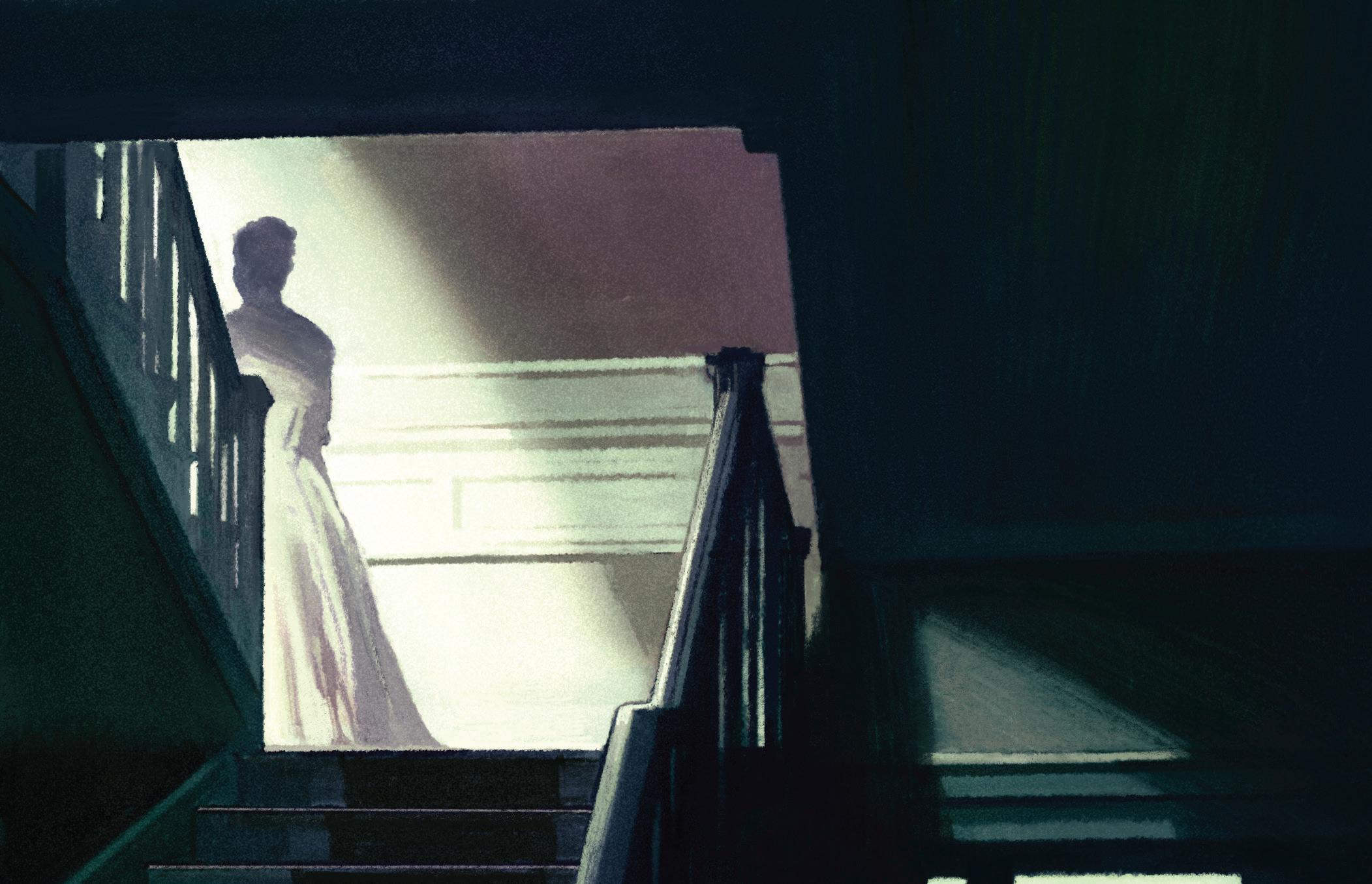

Creating your own adventure on the island is easy, thanks to myriad ways to fill your days, from nature-centered activities to history highlights to focused beach time. Pick a morning activity to set the tone and see where the day takes you.
By LAUREN FINNEY HARDEN Photography courtesy of JEKYLL ISLAND AUTHORITY
Part of the beauty of Jekyll Island is the ability to take things at any speed you choose. Practice the art of doing nothing and start your day when it suits you best.

Oceanview Beach Park is the perfect place to watch the day begin, thanks to its east-facing position. Stroll over from a nearby hotel or hop in your car and make the short drive to catch the start of a new day.
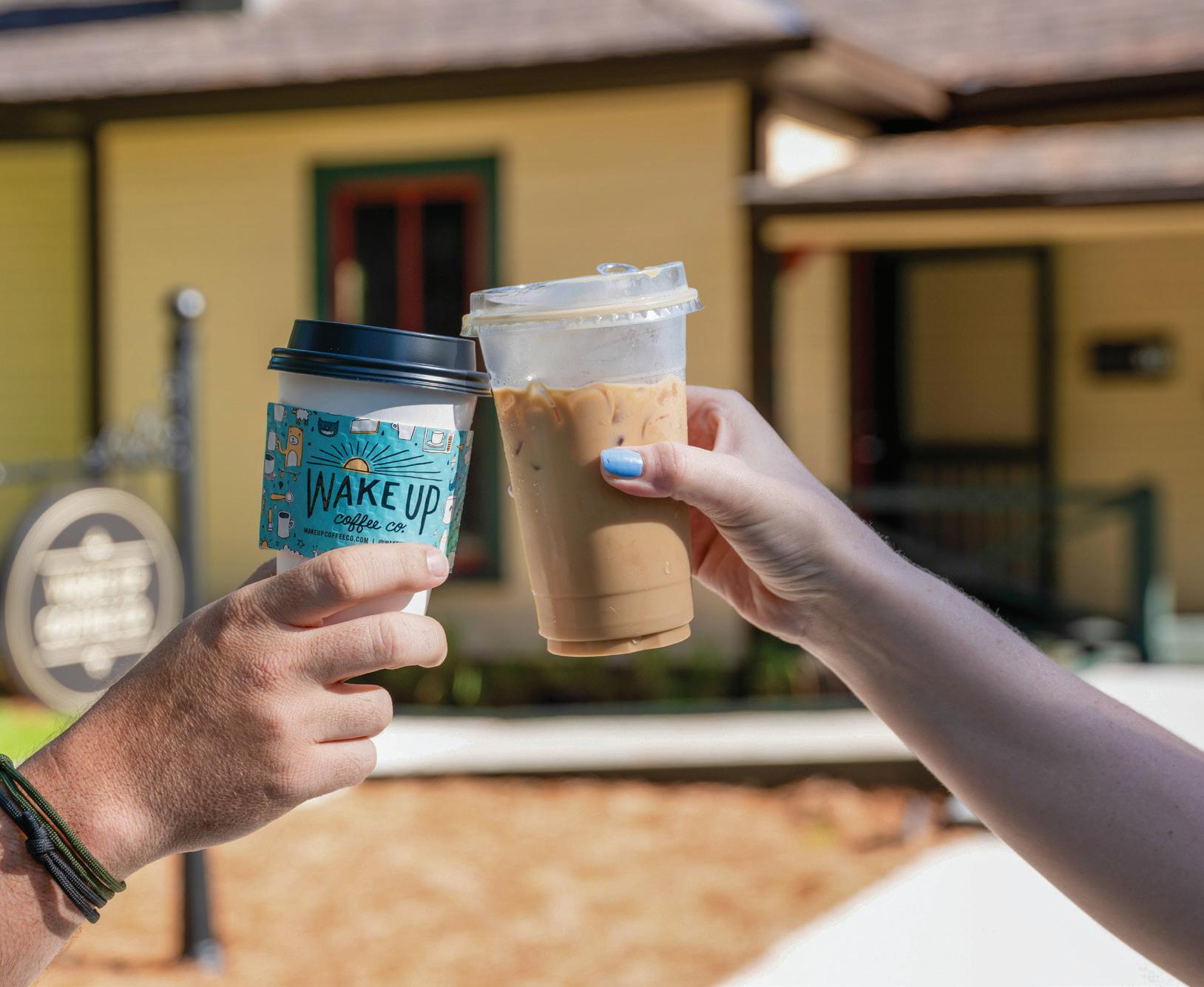
Golden Isles favorite, Wake Up Coffee Company, has a new location in the heart of Jekyll’s historic district. Start your day with handcrafted espresso drinks and homemade baked goods. Pro tip: Try the Turtle Mocha, which is whipped up with caramel and chocolate.
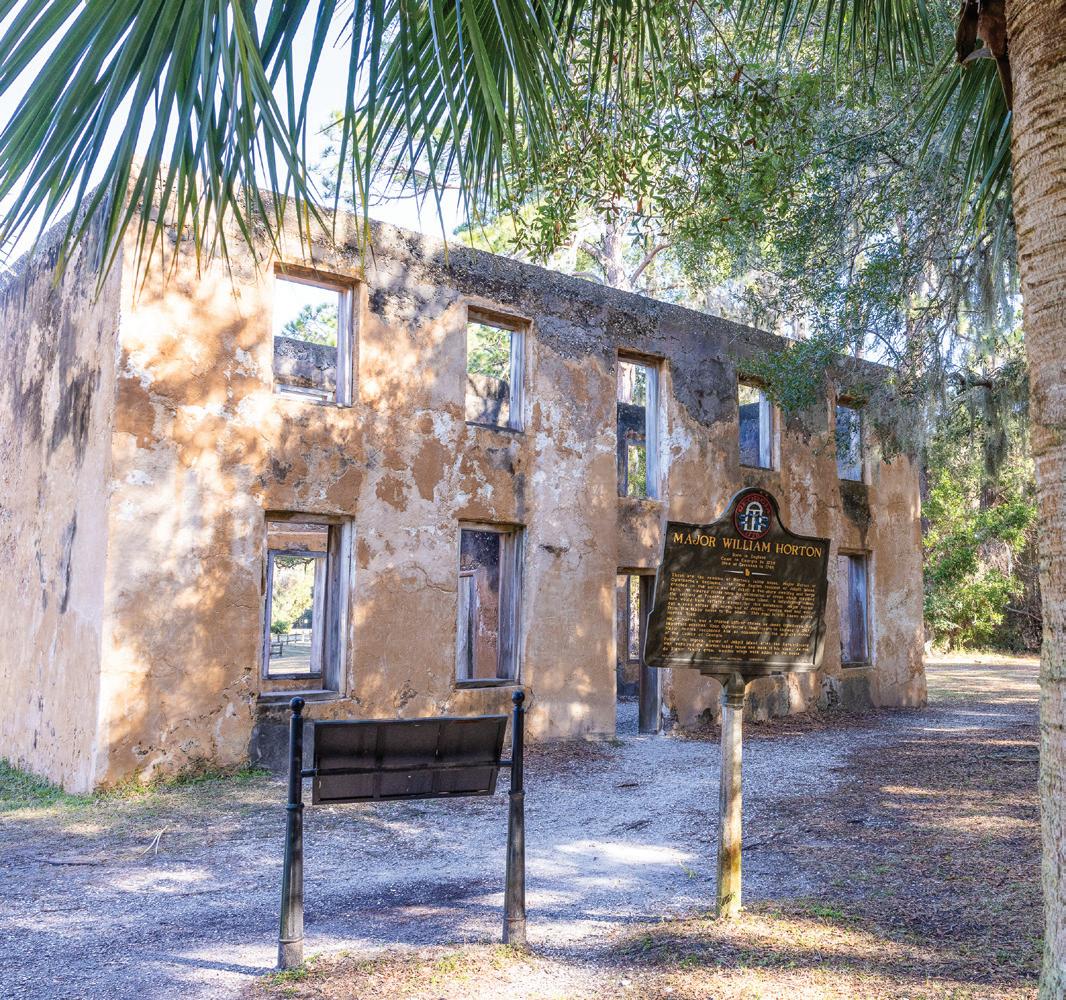
Head to ADA-acce ssib le Horton Pond on the north end of the island to glimpse alligators, birds, turtles, fish, and more in their natural habitat at one of the best spots on the island to see animals in action. Tupelo Trail, a 0.7mile nature trail, loops the pond for more immersion in the natural world. Leashed dogs are welcome on the trail.
Horton House is one of the oldest surviving tabby structures in Georgia. Rent a bike from the Jekyll Island Museum and bike four miles to the north end of the island. Take a self-guided tour of the remains of the building, which was built in 1743 and is on the National Register of Historic Places.

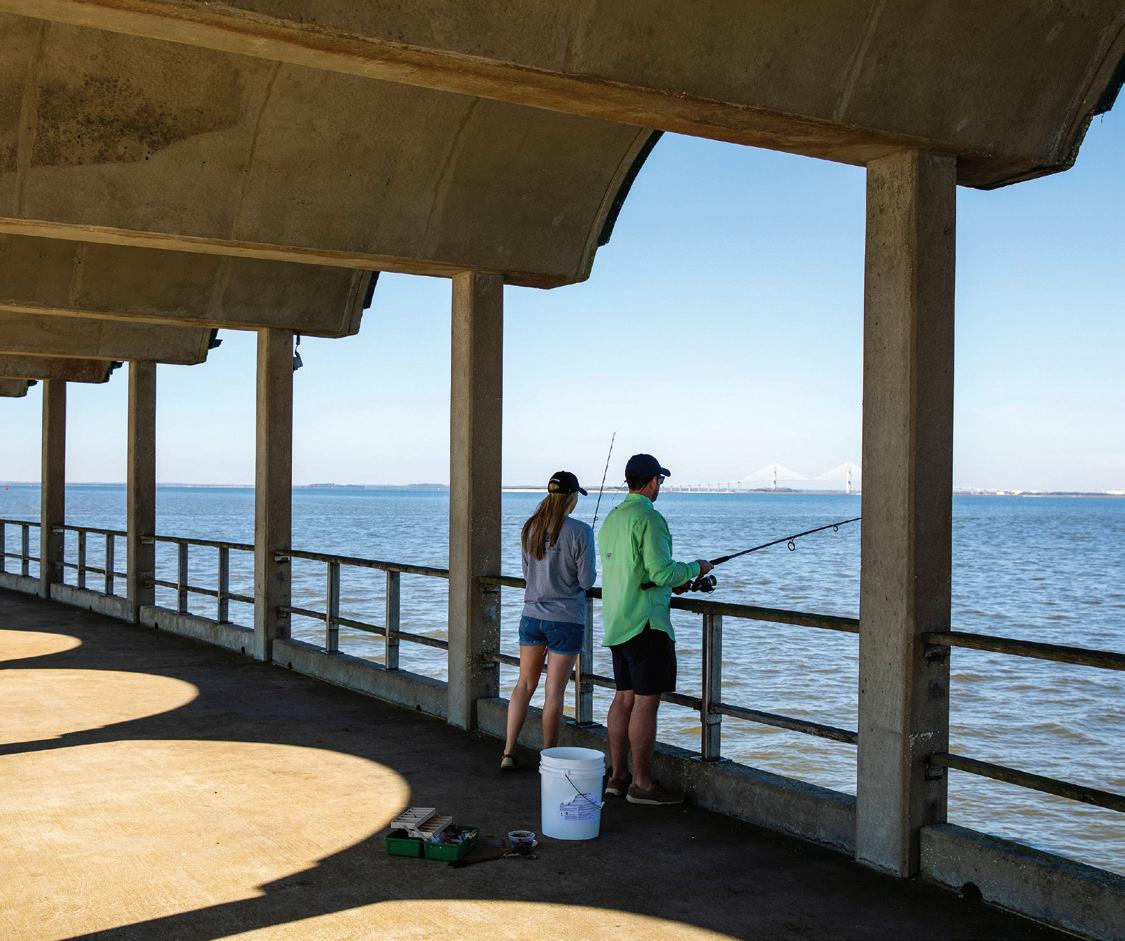
Gear up at Pier Road Outfitters b efore heading to the Clam Creek fishing pier on the north end of the island. Secure live bait at the Jekyll Island Fishing Center to try your hand at catching redfish, speckled trout, or sheepshead. Be sure to grab a year-long fishing license from the Georgia Department of Natural Resources Wildlife Division, which can be done online.

Visit the Geor gia Sea Tu rtle Cen ter, the only education and research facility in the state devoted to the rehabilitation of sea turtles and other native wildlife like marsh-dwelling diamondback terrapins. Indoor and outdoor interactive exhibits and programming are appropriate for all ages, while a 45-minute behindthe-scenes tour is available for those over age 10.

Walk the Wanderer Memory Trail, which explains the story of one of America’s last known slave ships that illegally came ashore over 160 years ago on the banks of the Jekyll River with more than 400 enslaved Africans. Individual exhibits at this UNESCO Slave Route Project “Site of Memory” take visitors through the story of one young African boy as he goes from capture to freedom.

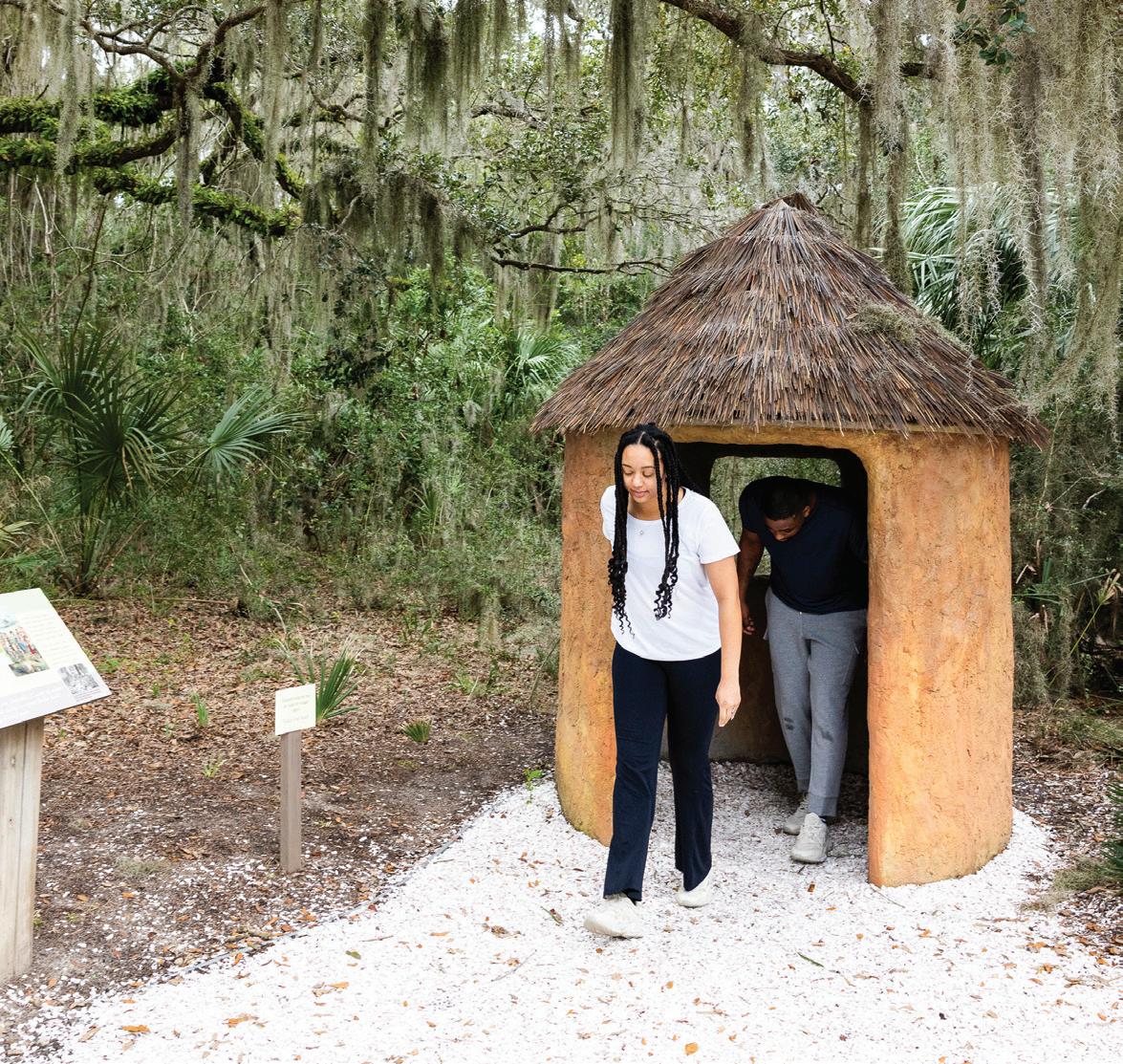
Head to 4-H Tideland s Nature Center on S. Riverview Drive for a guided kayak tour, which begins on the salt marsh near Tidelands Pond. See egrets, herons, fiddler crabs, and potentially dolphins and manatees over two hours on the water. If you want to explore on your own, the nature center, which is run by the University of Georgia, offers a comprehensive self-guided tour.
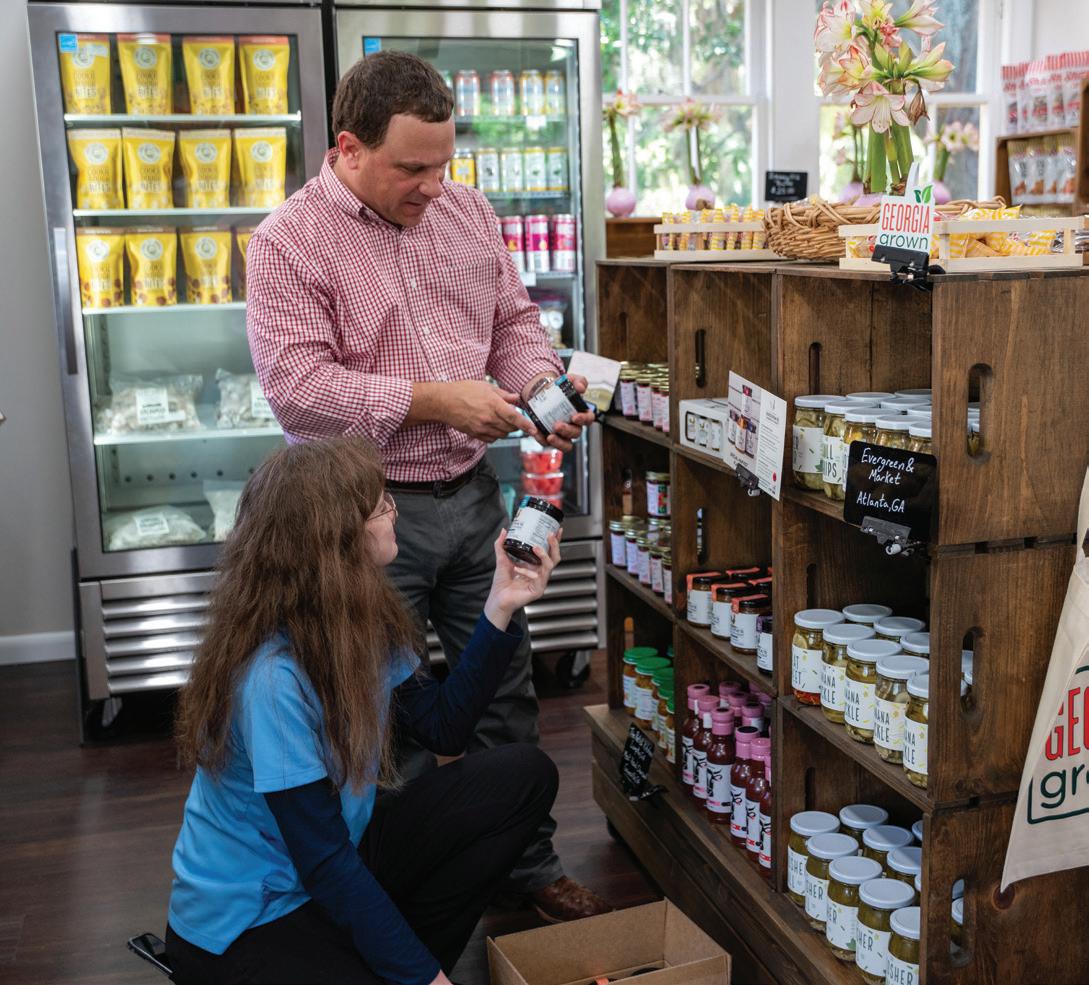
Georgia Grown Sign ature Sho ppe in the Historic District offers everything needed for a picturesque picnic. In partnership with the Georgia Department of Agriculture, the store has locally sourced goods such as fresh produce, refreshing sips from Montane Sparkling Water, and a sweet pick-me-up from Dillon Candy Company out of Boston, Ga.

Red Bug Motors Pizza has been slinging handmade pies on the island for over a decade. Order local favorites like the Redbug, which comes with pepperoni, sausage, mushrooms, and black olives, or twists on classics like the Hawaiian Overload. This island-inspired pizza comes loaded with ham, salami, red onions, pineapple, and green peppers. Take a seat in the Old English pub-inspired dining room, or head outside to the adjacent ADA playground to let kids burn off energy while you wait for takeout.
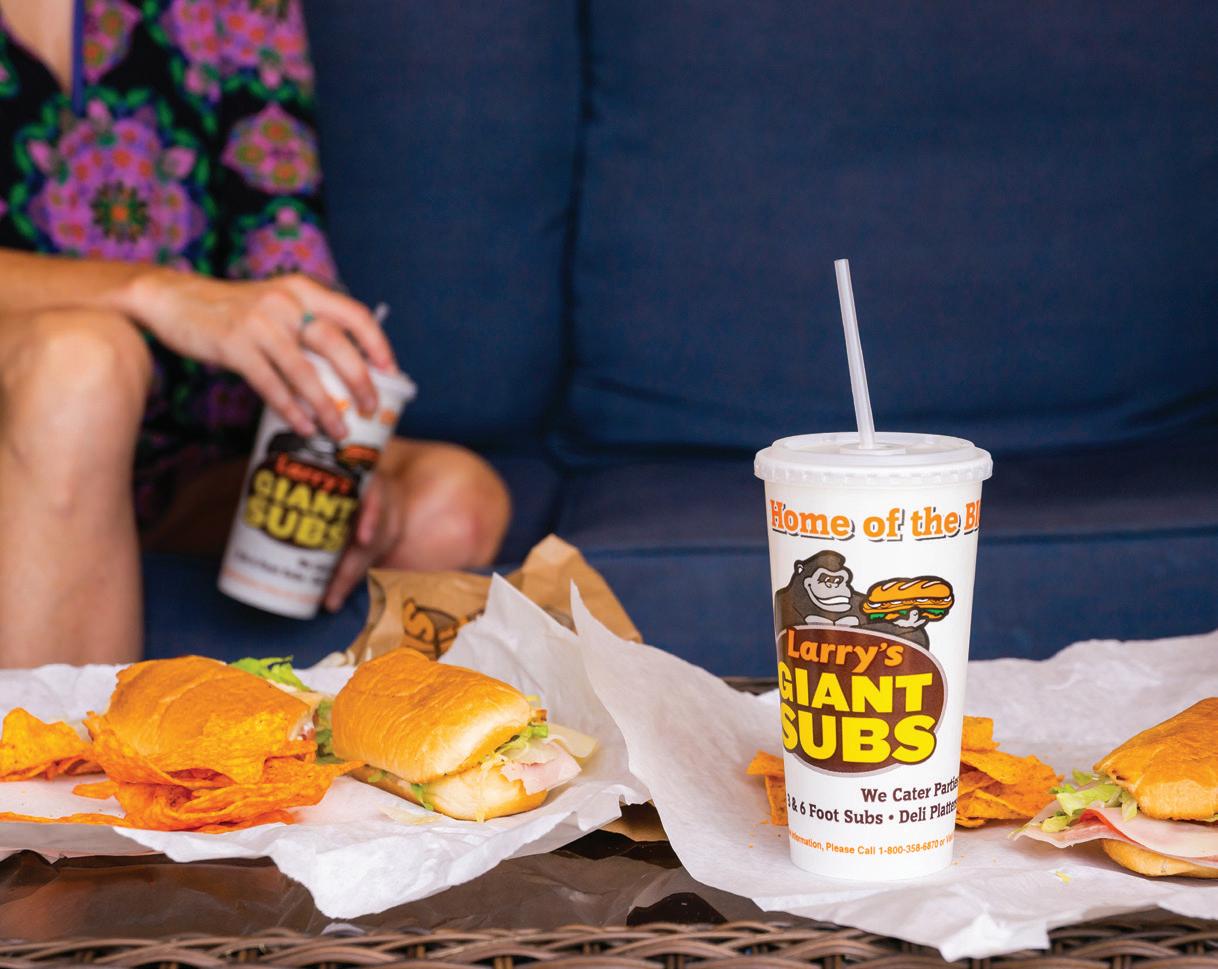
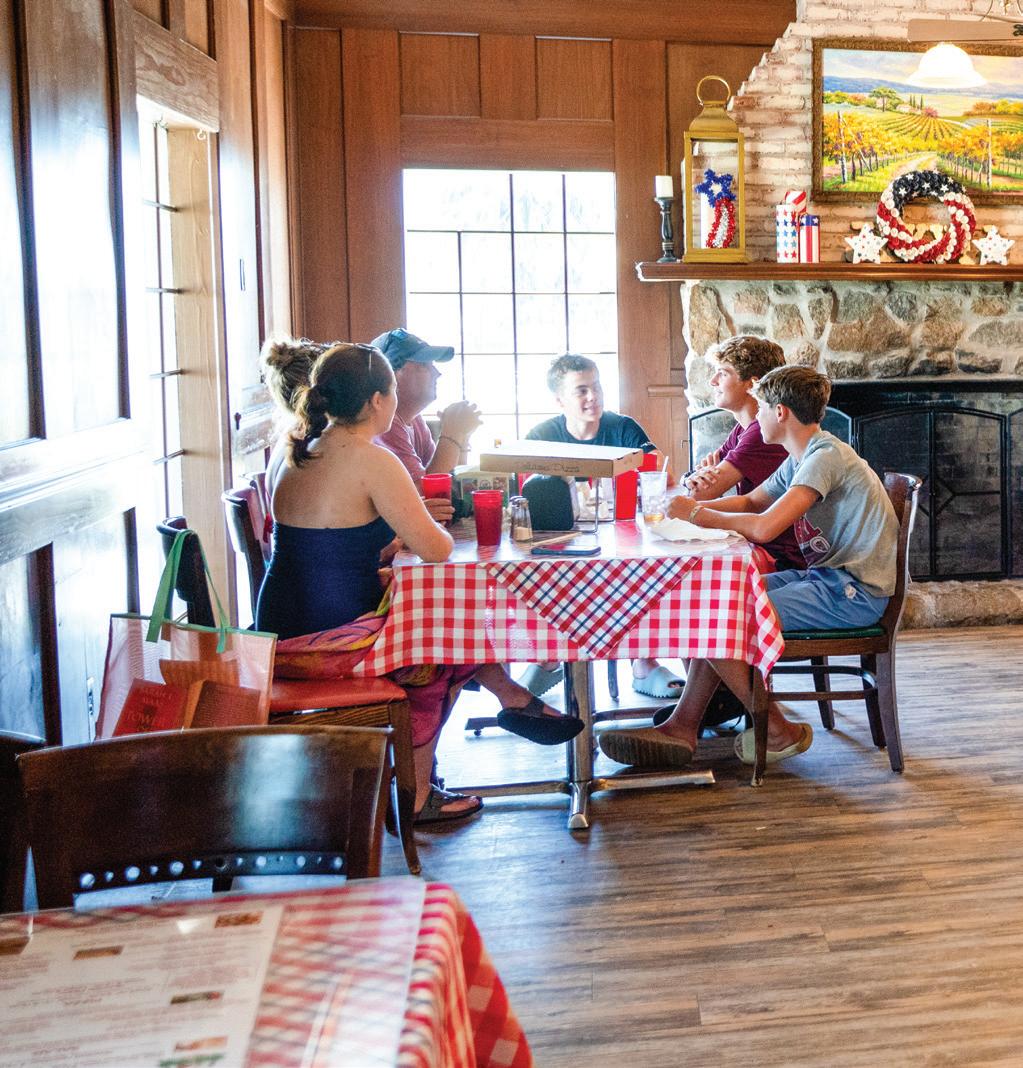
Satisfy with sandwiches.
Local cult favorite Larry’s Giant Subs on Main Street in Beach Village has an array of beachready subs, salads, and New York-style deli sandwiches like corned beef on rye or pastrami to fill bellies before a requisite beach nap.
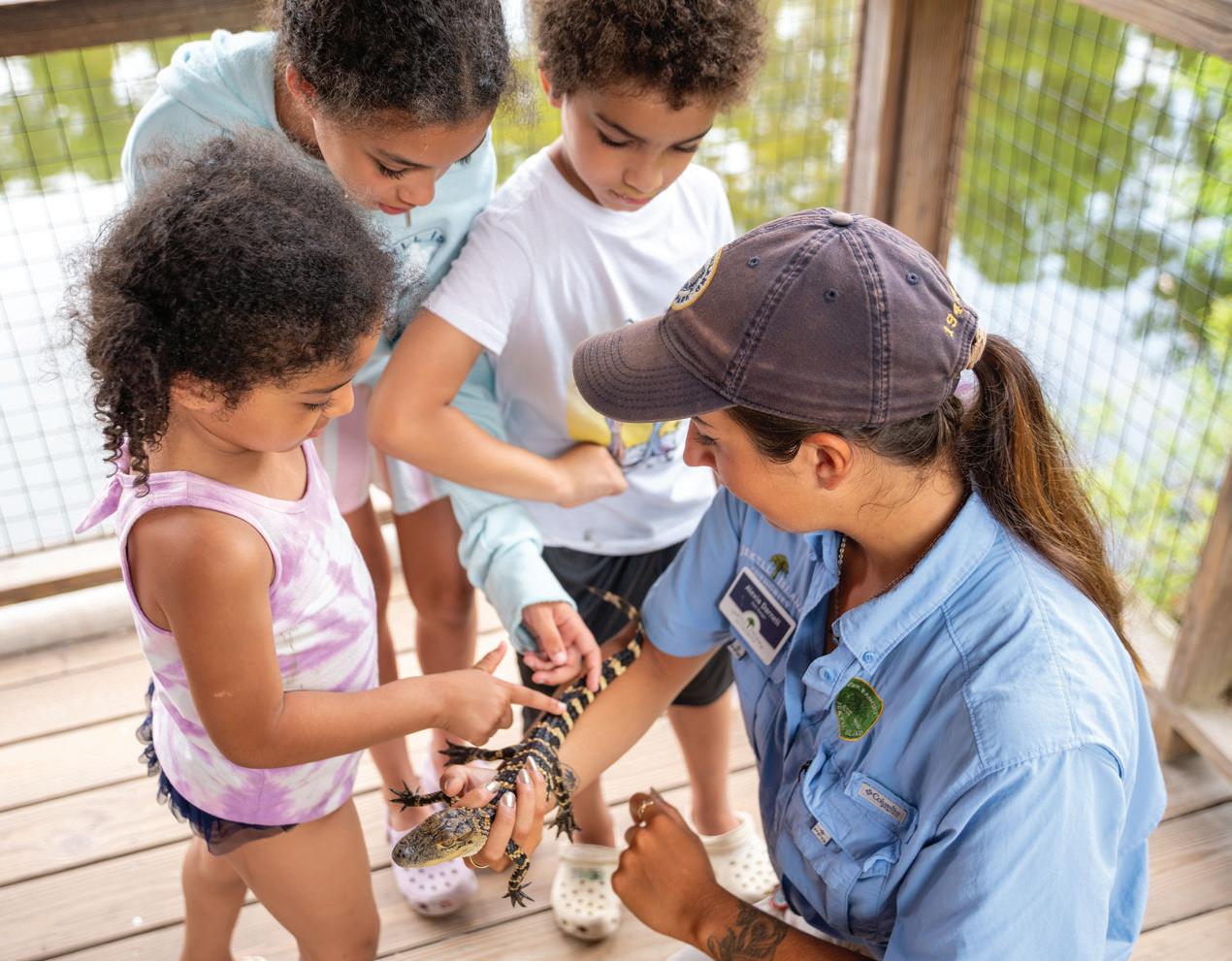
Prioritize conservation and pick a naturalist program to dig deep into the island’s efforts. Options include a Ranger Walk to see bald eagle nests, Gatorology to get hands-on experience with one of nature’s most mystifying creatures, or a spot in the Snakes of the Southeast program, an up-close encounter where these misunderstood reptiles get the focus they deserve.

Acquire unique gifts at t he Di strict Shops in the Historic District. Peruse Pier Road Outfitters for outdoor essentials, North Pole South for a bit of Christmas cheer all year long, and J.P. & Co. Gilded Age Photo Studio for a step back into times past. 31•81, a Jekyll Island Lifestyle Shop, has upscale souvenirs from brands like Southern Tide, Comfort Colors, Smathers & Branson, Dune Jewelry, and more.
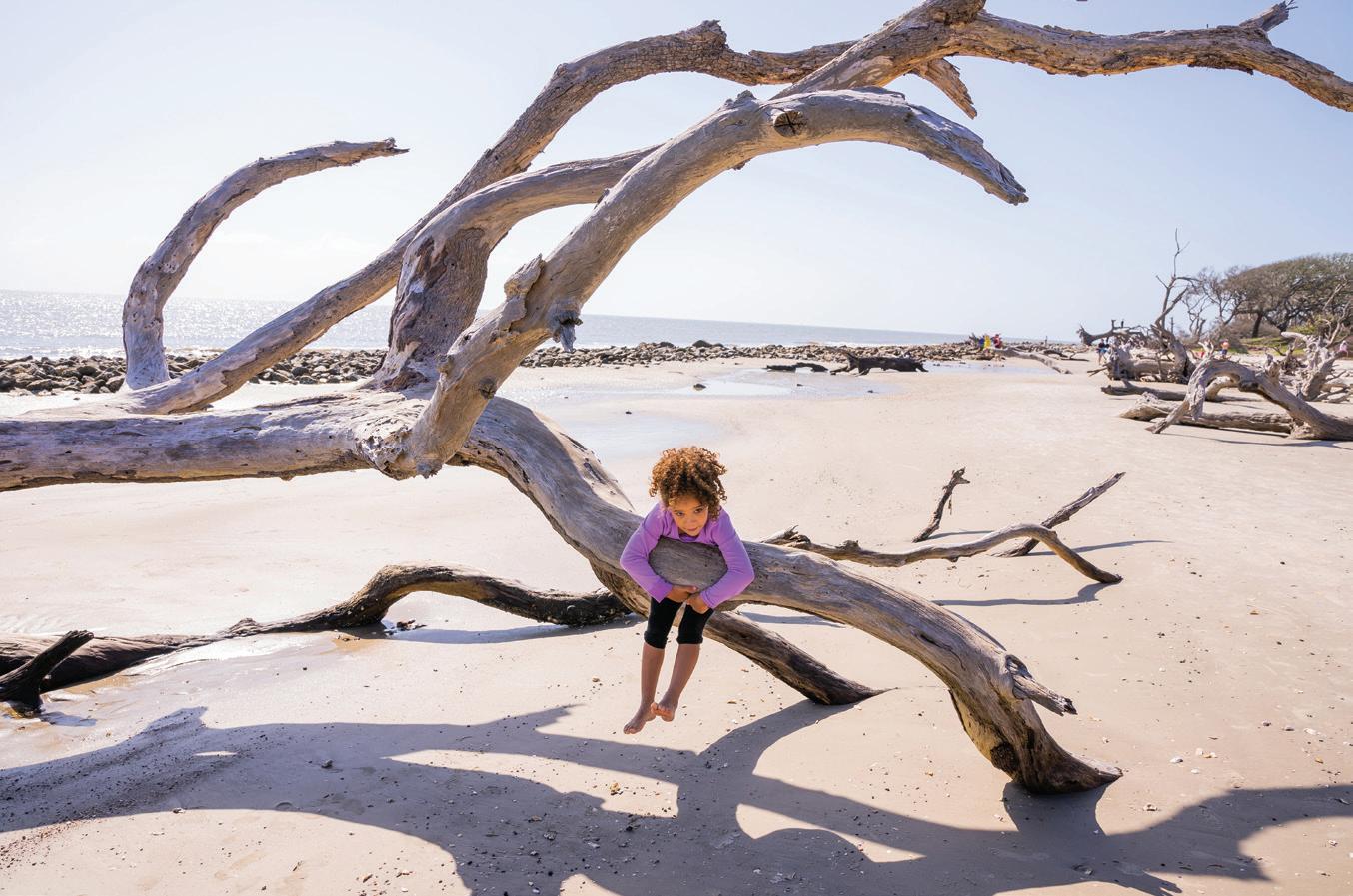

Head to Driftwood Beach, one of the world’s best and most photographed beaches. Ancient driftwood structures create an otherworldly landscape, perfect for photo ops, family play time, and contemplating life.
Book a table timed to sunset for a front-row seat to nature’s most spectacular show at The Wharf, walking distance from the Historic District. Complement it with peel-and-eat shrimp, oysters on the half shell, or a Lowcountry boil—all accompanied by live music.

Fill your belly as you eat your way through Beach Village’s shops and restaurants. Start at Love Shack BBQ Shrimp and Yard Bird in Jekyll Market for barbecue or Corridor Z Kitchen & Cocktails for light apps like shrimp tacos and crab cakes. Head to McGarvey’s Wee Pub for a heaping serving of its award-winning butter pecan bread pudding topped with caramel and whipped cream. Walk it off by browsing Beach Village shops post-meal.

Craft cocktails and local beers on tap bring the party to Founder’s Social on Pier Road.


Two 18-hole mini golf courses will delight both beginners and more advanced players at Jekyll Island Mini Golf. So will larger-than-life structures such as shark jaws and the Brontosaurus, which has stood ferociously since the course opened in the 1960s.
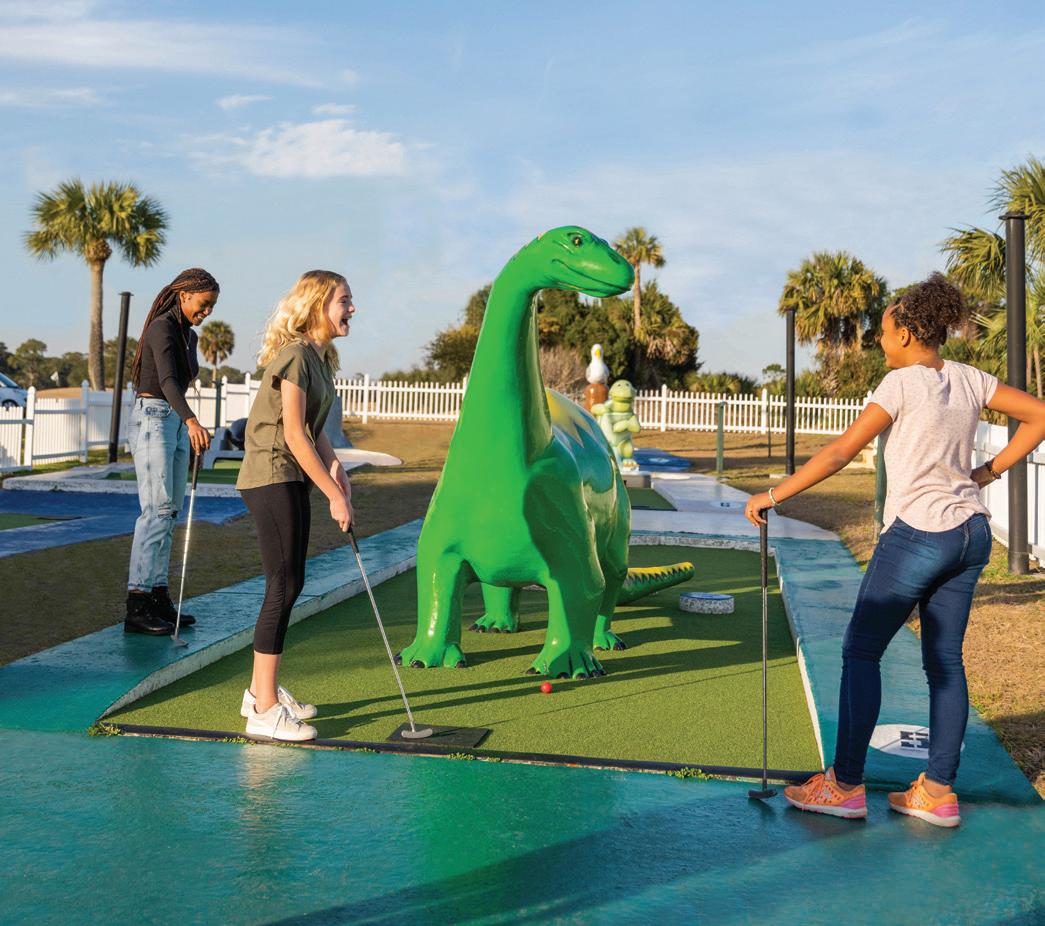


Make a stop at Jekyll Isla nd Sw eets on Pier Road to grab an evening treat. Delight in old-fashioned confectionery items like fudge, chocolate-covered Oreos, chocolate turtles, brownies, and divinity, a light and airy Southern treat. If ice cream is more your speed, choose from more than a dozen housemade flavors in the ice cream parlor, (bourbon butter pecan and peach cobbler are local faves). If you’re lucky, you can catch a candy-making demonstration.
Grab binoculars, a blanket, and a star app of your choice to identify constellations and head to Glory Beach or St. Andrew's Beach. These spots have optimal viewing, preferably on new moon mights or one to two days before or after, when the sky is darkest. Use a red LED flashlight from May to October to help preserve your night vision and keep any nesting sea turtles on their path.


We run barefoot down the boardwalk as first light breaks. The still invisible sun paints the horizon purple and blue before setting fire to the streaking clouds with a sudden blaze of orange. The ocean is calm, a distorted mirror of the sky. We trace the seam of water and land, where gentle waves wipe the shore smooth. Sand is cold between our toes as the receding sea pulls the ground from beneath our feet. The sun is rising, but we cast our gaze downward. We scour the ground for shells: lettered olive, angel wing, channeled duckclam, calico scallop, and knobbed whelk. Once a mollusk’s home, abandoned and cast aside, it’s now our treasure. Everyone else is still asleep, no competition—just us and the ghost crabs scuttling along. The tide is low, exposing a trove of shells, and if we’re lucky, maybe a shark’s tooth or a sea dollar intact. The morning hunt is good. — tony rehagen
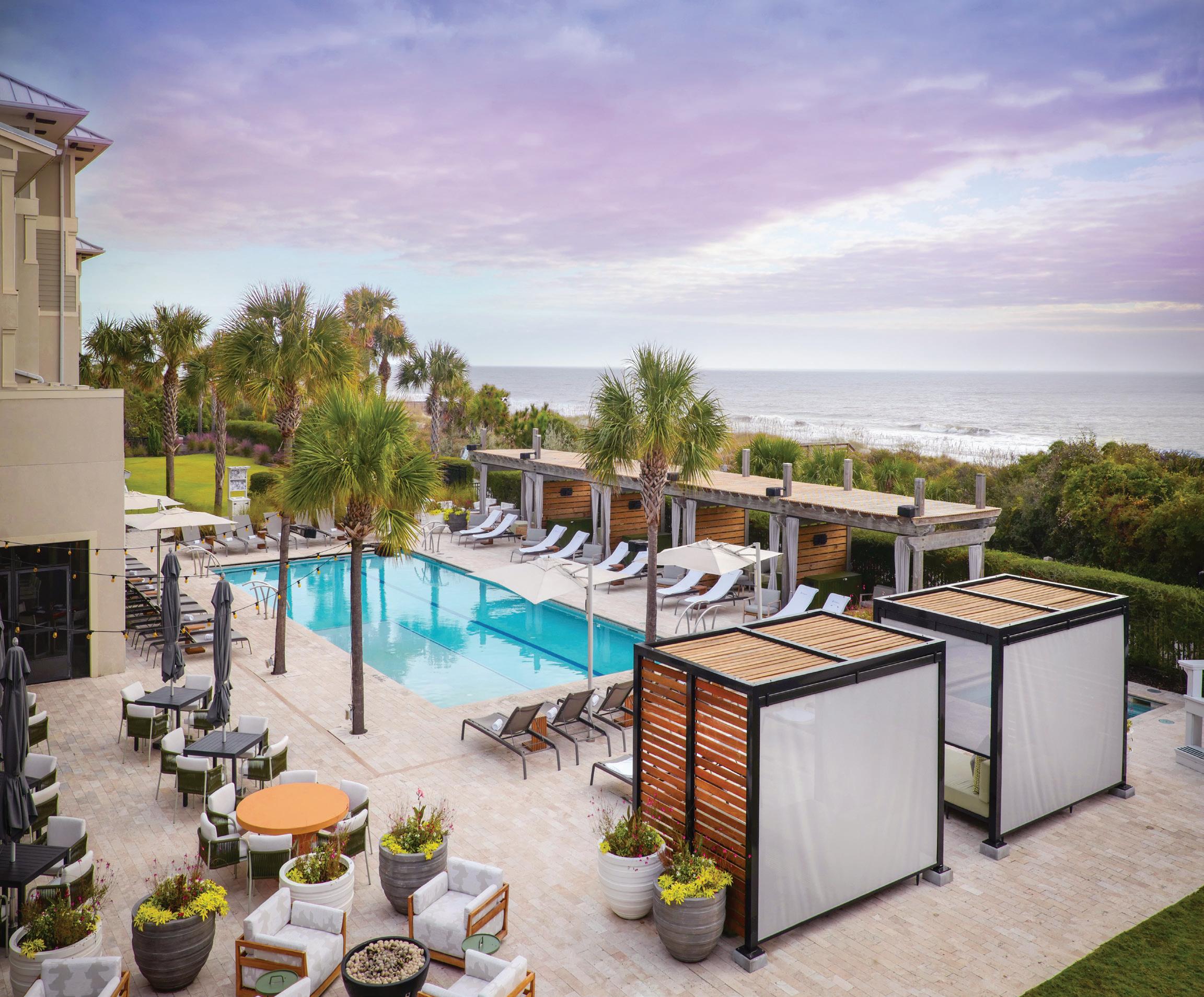
RECHARGE AND REJUVEN ATE WIT H OCEAN AIR AND ELE VAT ED COMFORTS.
Embark on your island getaway at our intimate oceanfront boutique hotel with 40 luxurious suites. Just moments from the beach, each suite offers timeless comforts: a generous living area, private balcony, and porch. Indulge in culinary delights at Eighty Ocean Kitchen and Bar, serving breakfast, lunch, and dinner favorites. Come, stay a while in paradise.
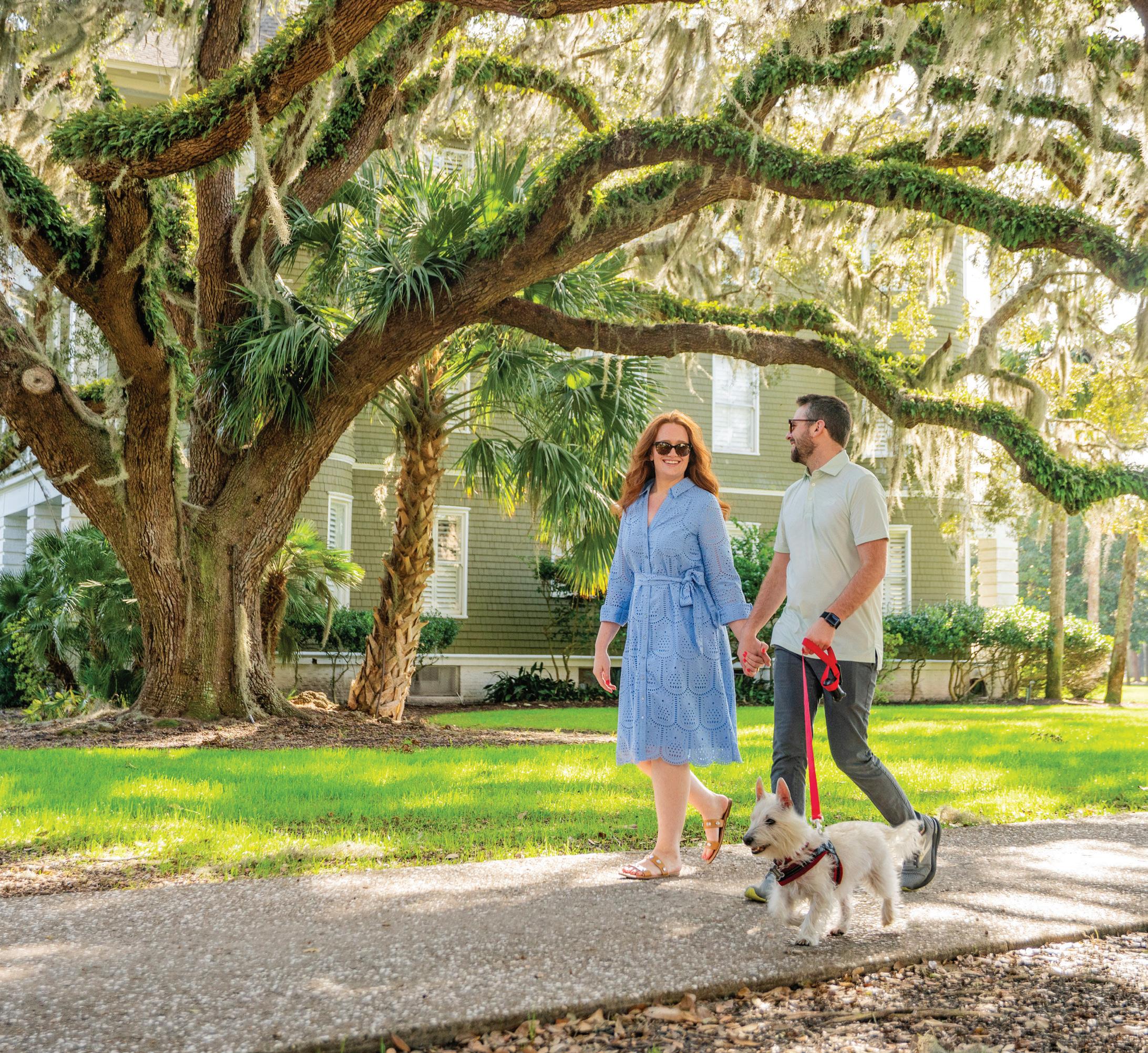
Inspired by Georgia’s most intriguing barrier island, this refined, coastal collection celebrates the moments and memories only found here. Featuring brands like Southern Tide®, Comfort Colors™, Lilly Pulitzer®, and more, 31•81 captures the essence of laid-back elegance.